
キューバの音楽
Music of Cuba

☆ キューバの音楽( music of Cuba) は、楽器、パフォーマティビティ、ダンスを含め、主に西アフリカとヨーロッパ(特にスペイン)の音楽の影響を受けた独自の伝統的な音楽で構成されている。 例えば、ソン・クバーノは、スペインのギター(トレス)、メロディー、ハーモニー、叙情的な伝統と、アフロ・キューバのパーカッションやリズムを融合させ たものである。16世紀に原住民が絶滅したため、原住民の伝統はほとんど残っていない。 19世紀以降、キューバ音楽は世界中で絶大な人気と影響力を持っている。19世紀以降、キューバ音楽は世界中で絶大な人気と影響力を持つようになり、録音 技術が導入されて以来、おそらく最も人気のある地域音楽の形態となっている。キューバ音楽は、ラテンアメリカ、カリブ海諸国、西アフリカ、ヨーロッパを中 心に、世界中のさまざまなジャンルや音楽スタイルの発展に貢献してきた。例えば、ルンバ、アフロ・キューバン・ジャズ、サルサ、スークー、アフロ・キュー バン・ミュージックを西アフリカに再アダプトしたもの(オーケストラ・バオバブ、アフリカンド)、スペインのフュージョン・ジャンル(特にフラメンコとの フュージョン)、ラテン・アメリカの多種多様なジャンルなどが挙げられる。
| The music of Cuba,
including its instruments, performance, and dance, comprises a large
set of unique traditions influenced mostly by west African and European
(especially Spanish) music.[1] Due to the syncretic nature of most of
its genres, Cuban music is often considered one of the richest and most
influential regional music in the world. For instance, the son cubano
merges an adapted Spanish guitar (tres), melody, harmony, and lyrical
traditions with Afro-Cuban percussion and rhythms. Almost nothing
remains of the original native traditions, since the native population
was exterminated in the 16th century.[2] Since the 19th-century Cuban music has been hugely popular and influential throughout the world. It has been perhaps the most popular form of regional music since the introduction of recording technology. Cuban music has contributed to the development of a wide variety of genres and musical styles around the globe, most notably in Latin America, the Caribbean, West Africa, and Europe. Examples include rhumba, Afro-Cuban jazz, salsa, soukous, many West African re-adaptations of Afro-Cuban music (Orchestra Baobab, Africando), Spanish fusion genres (notably with flamenco), and a wide variety of genres in Latin America. |
キューバの音楽は、楽器、パフォーマティビ
ティ、ダンスを含め、主に西アフリカとヨーロッパ(特にスペイン)の音楽の影響を受けた独自の伝統的な音楽で構成されている。例えば、ソン・クバーノは、
スペインのギター(トレス)、メロディー、ハーモニー、叙情的な伝統と、アフロ・キューバのパーカッションやリズムを融合させたものである。16世紀に原
住民が絶滅したため、原住民の伝統はほとんど残っていない[2]。 19世紀以降、キューバ音楽は世界中で絶大な人気と影響力を持っている。19世紀以降、キューバ音楽は世界中で絶大な人気と影響力を持つようになり、録音 技術が導入されて以来、おそらく最も人気のある地域音楽の形態となっている。キューバ音楽は、ラテンアメリカ、カリブ海諸国、西アフリカ、ヨーロッパを中 心に、世界中のさまざまなジャンルや音楽スタイルの発展に貢献してきた。例えば、ルンバ、アフロ・キューバン・ジャズ、サルサ、スークー、アフロ・キュー バン・ミュージックを西アフリカに再アダプトしたもの(オーケストラ・バオバブ、アフリカンド)、スペインのフュージョン・ジャンル(特にフラメンコとの フュージョン)、ラテン・アメリカの多種多様なジャンルなどが挙げられる。 |
Overview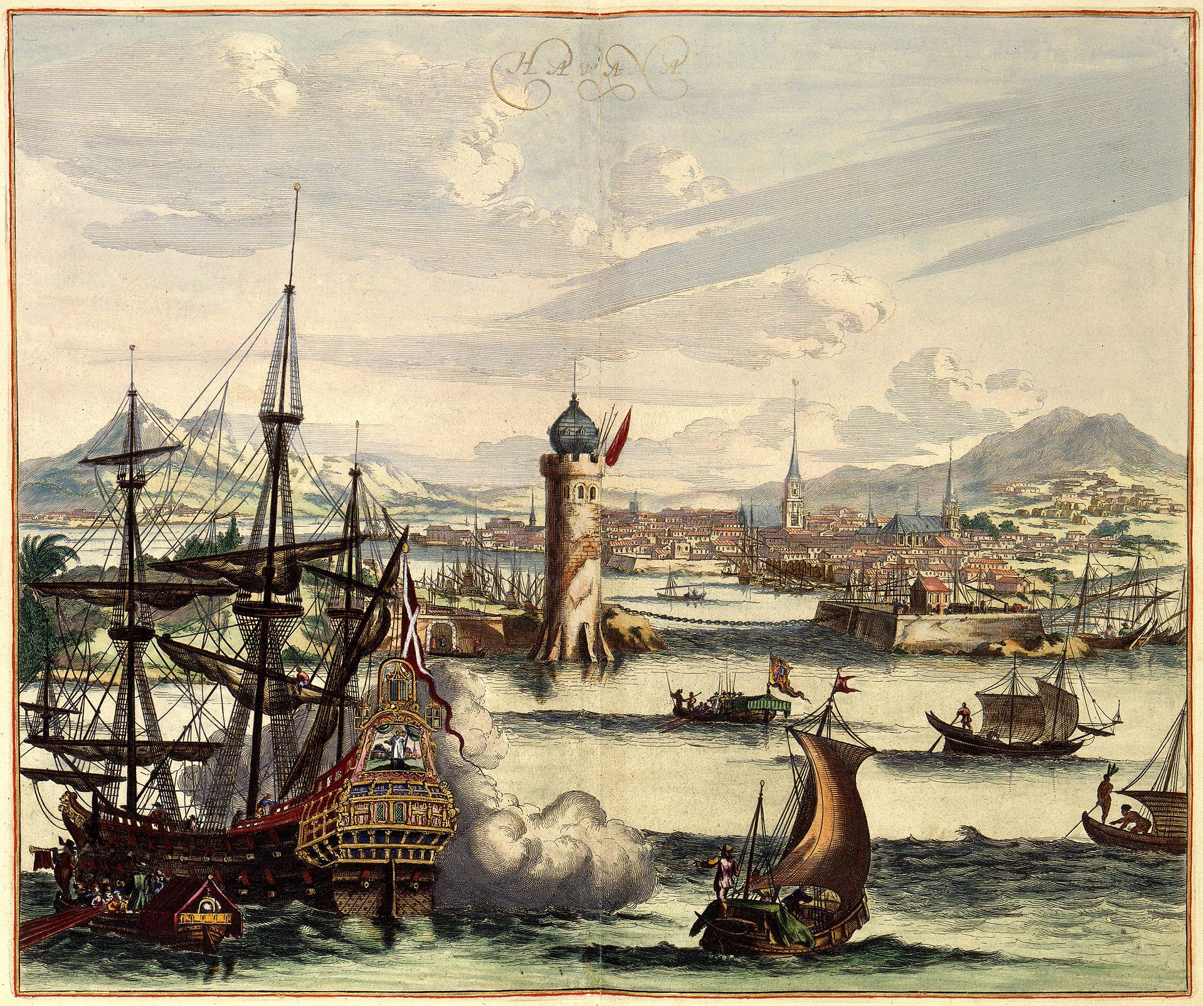 Ancient print of colonial Havana Large numbers of enslaved Africans and European, mostly Spanish, immigrants came to Cuba and brought their own forms of music to the island. European dances and folk musics included zapateo, fandango, paso doble and retambico. Later, northern European forms like minuet, gavotte, mazurka, contradanza, and the waltz appeared among urban whites. There was also an immigration of Chinese indentured laborers later in the 19th century. Fernando Ortiz, the first great Cuban folklorist, described Cuba's musical innovations as arising from the interplay ('transculturation') between enslaved Africans settled on large sugar plantations and Spaniards from different regions such as Andalusia and Canary Islands. The enslaved Africans and their descendants made many percussion instruments and preserved rhythms they had known in their homeland.[3] The most important instruments were the drums, of which, there were originally about fifty different types; today only the bongos, congas and batá drums are regularly seen (the timbales are descended from kettle drums in Spanish military bands). Also important are the claves, two short hardwood batons, and the cajón, a wooden box, originally made from crates. Claves are still used often, and wooden boxes (cajones) were widely used during periods when the drum was banned. In addition, there are other percussion instruments in use for African-origin religious ceremonies. Chinese immigrants contributed the corneta china (Chinese cornet), a Chinese reed instrument still played in the comparsas, or carnival groups, of Santiago de Cuba. The great instrumental contribution of the Spanish was their guitar, but even more important was the tradition of European musical notation and techniques of musical composition. Hernando de la Parra's archives give some of our earliest available information on Cuban music. He reported instruments including the clarinet, violin and vihuela. There were few professional musicians at the time, and fewer still of their songs survive. One of the earliest is Ma Teodora, supposed to be related to a freed slave, Teodora Ginés of Santiago de Cuba, who was famous for her compositions. The piece is said to be similar to 16th-, 17th- and 18th-century Spanish popular songs and dances.[4] Cuban music has its principal roots in Spain and West Africa, but over time has been influenced by diverse genres from different countries. Important among these are France (and its colonies in the Americas), and the United States. Cuban music has been immensely influential[citation needed] in other countries. It contributed not only to the development of jazz and salsa, but also to the Argentine tango, Ghanaian high-life, West African Afrobeat, Dominican Bachata and Merengue, Colombian Cumbia and Spanish Nuevo flamenco and to the Arabo-Cuban music (Hanine Y Son Cubano)[5] developed by Michel Elefteriades in the 1990s. The African beliefs and practices certainly influenced Cuba's music. Polyrhythmic percussion is an inherent part of African music, as the melody is part of European music. Also, in African tradition, percussion is always joined to song and dance, and a particular social setting.[6] The result of the meeting of European and African cultures is that most Cuban popular music is creolized. This creolization of Cuban life has been happening for a long time, and by the 20th century, elements of African belief, music, and dance were well integrated into popular and folk forms. |
概要 植民地時代のハバナの古代版画 奴隷にされた大勢のアフリカ人とヨーロッパ人(主にスペイン人)がキューバに移住し、独自の音楽様式を持ち込んだ。ヨーロッパのダンスや民族音楽には、サ パテオ、ファンダンゴ、パソ・ドブレ、レタンビコなどがあった。その後、メヌエット、ガボット、マズルカ、コントラバンザ、ワルツといった北欧の形式が都 市部の白人の間に登場した。19世紀後半には、中国人年季奉公労働者の移民もあった。 キューバ初の偉大な民俗学者フェルナンド・オルティスは、キューバの音楽的革新は、大規模な砂糖プランテーションに定住した奴隷アフリカ人と、アンダルシ アやカナリア諸島など異なる地域から来たスペイン人との相互作用(「トランスカルチュレーション」)から生じたと述べている。最も重要な楽器はドラムで、 元々は50種類ほどあったが、現在ではボンゴ、コンガ、バタ・ドラムのみが一般的である(ティンバレスはスペインの軍楽隊のケトル・ドラムの子孫)。ま た、クラベスという2本の短い広葉樹のバトンと、カホンという木製の箱も重要で、もともとは木箱で作られていた。クラーベは今でもよく使われ、木製の箱 (カホン)はドラムが禁止されていた時期にも広く使われていた。さらに、アフリカ起源の宗教儀式に使われる打楽器もある。中国からの移民は、サンティア ゴ・デ・クーバのコンパーサ(カーニバルのグループ)で今でも演奏されている中国のリード楽器、コルネータ・チャイナ(中国のコルネット)をもたらした。 スペイン人の楽器面での大きな貢献はギターであったが、それ以上に重要だったのは、ヨーロッパ楽譜の伝統と作曲技術であった。エルナンド・デ・ラ・パラの アーカイブには、キューバ音楽に関する最も古い情報が残されている。彼は、クラリネット、バイオリン、ビウエラなどの楽器を報告している。当時、プロの音 楽家はほとんどおらず、彼らの歌はほとんど残っていない。最も古い曲のひとつは「マ・テオドラ」で、解放奴隷だったサンティアゴ・デ・クーバのテオドラ・ ジネスが作曲したことで有名だ。この曲は、16世紀、17世紀、18世紀のスペインのポピュラーソングやダンスに似ていると言われている[4]。 キューバ音楽の主なルーツはスペインと西アフリカにあるが、長い時間をかけて様々な国の多様なジャンルの影響を受けてきた。中でも重要なのは、フランス(とアメリカ大陸の植民地)、アメリカである。 キューバ音楽は他国にも多大な影響力[要出典]を持っている。ジャズやサルサの発展だけでなく、アルゼンチン・タンゴ、ガーナのハイ・ライフ、西アフリカ のアフロビート、ドミニカのバチャータとメレンゲ、コロンビアのクンビア、スペインのヌエボ・フラメンコ、そして1990年代にミシェル・エレフテリアデ スが発展させたアラボ・キューバ音楽(Hanine Y Son Cubano)[5]にも貢献した。 アフリカの信仰と慣習がキューバの音楽に影響を与えたのは確かである。ポリリズムのパーカッションは、メロディがヨーロッパ音楽の一部であるように、アフ リカ音楽に固有のものである。また、アフリカの伝統では、パーカッションは常に歌や踊り、特定の社会的環境と結びついている[6]。ヨーロッパとアフリカ の文化が出会った結果、キューバのポピュラー音楽のほとんどはクレオール化している。キューバ人の生活におけるこのクレオール化は長い間起こっており、 20世紀までには、アフリカの信仰、音楽、ダンスの要素は、ポピュラーや民俗の形態によく溶け込んでいた。 |
18th and 19th centuries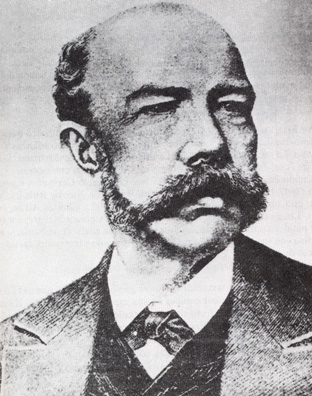 Manuel Saumell 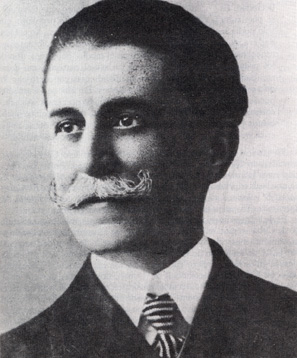 Ignacio Cervantes 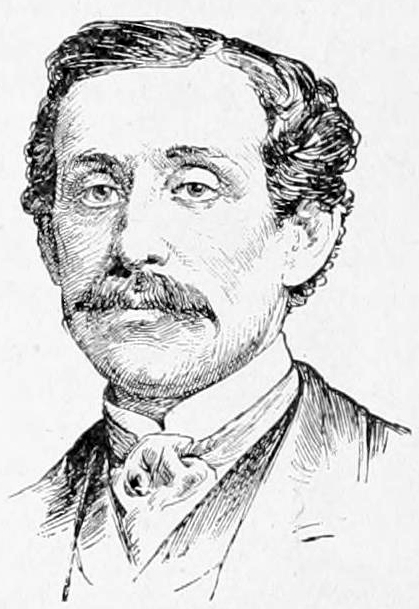 L. M. Gottschalk Among internationally heralded composers of the "serious" genre can be counted the Baroque composer Esteban Salas y Castro (1725–1803), who spent much of his life teaching and writing music for the Church.[7] He was followed in the Cathedral of Santiago de Cuba by the priest Juan París (1759–1845). París was an exceptionally industrious man and an important composer. He encouraged continuous and diverse musical events.[8]p181 Aside from rural music and Afro-Cuban folk music, the most popular kind of urban Creole dance music in the 19th century was the contradanza, which commenced as a local form of the English country dance and the derivative French contredanse and Spanish contradanza. While many contradanzas were written for dance, from the mid-century several were written as light-classical parlor pieces for piano. The first distinguished composer in this style was Manuel Saumell (1818–1870), who is sometimes accordingly hailed as the father of Cuban creole musical development. According to Helio Orovio, "After Saumell's visionary work, all that was left to do was to develop his innovations, all of which profoundly influenced the history of Cuban nationalist musical movements."[9] In the hands of his successor, Ignacio Cervantes Kavanagh, the piano idiom related to the contradanza achieved even greater sophistication. Cervantes was called by Aaron Copland a "Cuban Chopin" because of his Chopinesque piano compositions. Cervantes' reputation today rests almost solely upon his famous forty-one Danzas Cubanas, which Carpentier said, "occupy the place that the Norwegian Dances of Grieg or the Slavic Dances of Dvořák occupy in the music of their respective countries". Cervantes' never-finished opera, Maledetto, is forgotten.[8] In the 1840s, the habanera emerged as a languid vocal song using the contradanza rhythm. (Non-Cubans sometimes called Cuban contradanzas "habaneras.") The habanera went on to become popular in Spain and elsewhere. The Cuban contradanza/Danza was also an important influence on the Puerto Rican Danza, which went on to enjoy its own dynamic and distinctive career lasting through the 1930s. In Cuba, in the 1880s the contradanza/Danza gave birth to the danzón, which effectively superseded it in popularity.[10] Laureano Fuentes (1825–1898) came from a family of musicians and wrote the first opera to be composed on the island, La Hija de Jefté (Jefte's daughter). This was later lengthened and staged under the title Seila. His numerous works spanned all genres. Gaspar Villate (1851–1891) produced abundant and wide-ranging work, all centered on opera.[8]p239 José White (1836–1918), a mulatto of a Spanish father and an Afrocuban mother, was a composer and a violinist of international merit. He learned to play sixteen instruments, and lived, variously, in Cuba, Latin America, and Paris. His most famous work is La Bella Cubana, a habanera. During the middle years of the 19th century, a young American musician Louis Moreau Gottschalk (1829–1869) came to Cuba. Gottschalk's father was a Jewish businessman from London, and his mother a white creole of French Catholic background.[11] Gottschalk was brought up mostly by his black grandmother and nurse Sally, both from Saint-Domingue. He was a piano prodigy who had listened to the music and seen the dancing in Congo Square, New Orleans from childhood. His period in Cuba lasted from 1853 to 1862, with visits to Puerto Rico and Martinique squeezed in. He composed many creolized pieces, such as the habanera Bamboula, Op. 2 (Danse de negres) (1845), the title referring to a bass Afro-Caribbean drum; El cocoye (1853), a version of a rhythmic melody already present in Cuba; the contradanza Ojos criollos (Danse cubaine) (1859) and a version of María de la O, which refers to a Cuban mulatto singer. These numbers made use of typical Cuban rhythmic patterns. At one of his farewell concerts he played his Adiós a Cuba to huge applause and shouts of 'bravo!' Unfortunately, his score for the work has not survived.[12] In February 1860 Gottschalk produced a huge work La nuit des tropiques in Havana. The work used about 250 musicians and a choir of 200 singers plus a tumba francesa group from Santiago de Cuba. He produced another huge concert the following year, with new material. These shows probably dwarfed anything seen in the island before or since, and no doubt were unforgettable for those who attended.[13]p147 |
18世紀と19世紀 マヌエル・サウメル  イグナシオ・セルバンテス  L. M.ゴットシャルク 「シリアスな」ジャンルの国際的に著名な作曲家の中には、バロック時代の作曲家エステバン・サラス・イ・カストロ(1725~1803年)を挙げることがで き、彼は生涯の大半を教会のための教育と作曲に費やした[7]。パリスは非常に勤勉な人物で、重要な作曲家でもあった。農村音楽やアフロ・キューバの民俗 音楽は別として、19世紀の都市クレオールのダンス音楽で最も人気があったのはコントラダンツァであった。コントラダンツァは、イギリスのカントリーダン スや、そこから派生したフランスのコントレダンツァ、スペインのコントラダンツァのローカルな形態として始まった。多くのコントラダンザはダンスのために 書かれたが、世紀半ばからはピアノのための軽いクラシカルなパーラー曲として書かれるようになった。このスタイルの最初の著名な作曲家はマヌエル・サウメ ル(1818-1870)で、彼はキューバ・クレオール音楽発展の父と称されることもある。ヘリオ・オロビオによれば、「サウメルの先見的な仕事の後、残 されたのは彼の革新的な作品を発展させることだけであり、そのすべてがキューバの民族主義音楽運動の歴史に大きな影響を与えた」[9]。 彼の後継者であるイグナシオ・セルバンテス・カヴァナーの手にかかると、コントラフォルツァに関連するピアノのイディオムはさらに洗練されたものとなっ た。セルバンテスは、そのショパン風のピアノ曲から、アーロン・コープランドに「キューバのショパン」と呼ばれた。セルバンテスの今日の名声は、ほとんど 彼の有名な41の「キューバ舞曲」だけにかかっている。この舞曲は、「グリーグのノルウェー舞曲やドヴォルザークのスラブ舞曲がそれぞれの国の音楽で占め る位置を占めている」とカルペンティエは述べている。セルバンテスの未完のオペラ『マレデット』は忘れ去られた[8]。 1840年代には、ハバネラはコントラバンザのリズムを使った物憂げな声楽曲として登場した。(非キューバ人はキューバのコントラフォルツァを「ハバネ ラ」と呼ぶこともあった。キューバのコンコンダンサ/ダンツァは、プエルトリコのダンツァにも重要な影響を与え、1930年代まで続くダイナミックで独特 なキャリアを謳歌した。キューバでは、1880年代にコンディトランサ/ダンツァがダンツォンを誕生させ、事実上ダンツォンに人気が取って代わられた [10]。 ラウレアノ・フエンテス(1825-1898)は音楽家の家系に生まれ、キューバで最初に作曲されたオペラLa Hija de Jefté(ジェフテの娘)を書いた。この作品は後に長大化され、『セイラ』というタイトルで上演された。彼の作品はあらゆるジャンルに及んだ。ホセ・ホ ワイト(1836-1918)は、スペイン人の父とアフロキューバ人の母をもつ混血児で、作曲家であると同時に国際的なヴァイオリニストでもあった。彼は 16の楽器を習得し、キューバ、ラテンアメリカ、パリでさまざまな生活を送った。彼の最も有名な作品は、ハバネラ「ラ・ベッラ・クバーナ」である。 19世紀中頃、若きアメリカ人音楽家ルイ・モロー・ゴットシャルク(1829-1869)がキューバにやってきた。ゴットチョークの父はロンドン出身のユ ダヤ人実業家、母はフランス系カトリックの白人クレオール人であった[11]。ゴットチョークは、主にサン=ドマング出身の黒人の祖母と看護婦のサリーに 育てられた。幼い頃からニューオーリンズのコンゴ・スクエアで音楽を聴き、踊りを見ていたピアノの天才だった。キューバでの生活は1853年から1862 年まで続き、プエルトリコとマルティニークも訪れた。例えば、ハバネラ『バンブーラ』作品2(Danse de negres)(1845年)、『エル・ココイエ』(1853年)、キューバにすでにあったリズムのメロディーのヴァージョン、コントラバンザ『Ojos criollos(Danse cubaine)』(1859年)、キューバの混血歌手マリア・デ・ラ・オーのヴァージョンなどである。これらのナンバーは、典型的なキューバのリズム・ パターンを用いている。1860年2月、ゴットシャルクはハバナで大作La nuit des tropiquesを作曲した。この作品には、約250人の音楽家と200人の合唱団、それにサンティアゴ・デ・クーバのトゥンバ・フランセーサ・グルー プが起用された。翌年もまた、新曲を含む大規模なコンサートを開催した。これらのショーは、おそらくそれ以前にもそれ以降にもキューバで見られたものを凌 ぐものであり、参加した人々にとって忘れがたいものであったことは間違いない[13]p147。 |
20th-century classical and art music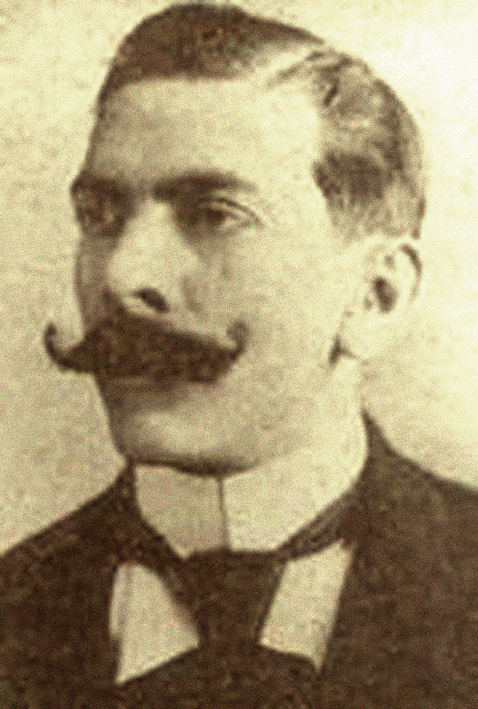 José Marín Varona. Between the end of the 19th century and the beginning of the 20th a number of composers excel within the Cuban music panorama. They cultivated genres such as the popular song and the concert lied, dance music, the zarzuela and the vernacular theatre, as well as symphonic music. Among others, we should mention Hubert de Blanck (1856-1932); José Mauri (1856-1937); Manuel Mauri (1857-1939); José Marín Varona; Eduardo Sánchez de Fuentes (1874-1944); Jorge Anckermann (1877-1941); Luis Casas Romero (1882-1950) and Mario Valdés Costa (1898-1930).[14] 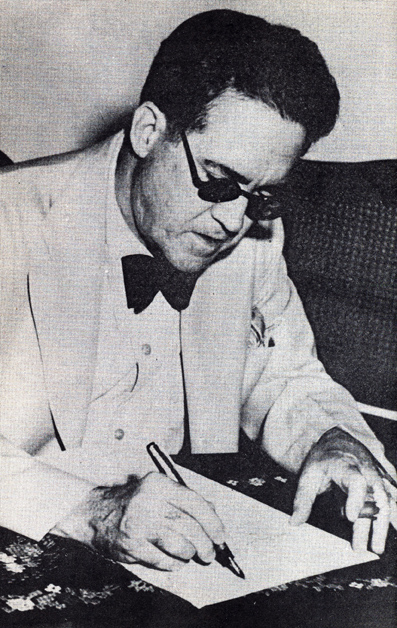 Gonzalo Roig. The work of José Marín Varona links the Cuban musical activity from the end of the 19th century and the beginning of the 20th century. In 1896, the composer included in his zarzuela "El Brujo" the first Cuban guajira which has been historically documented.[15][16] About this piece, composer Eduardo Sánchez de Fuentes said: "The honest critique of a not very far day will bestow the author of the immortal guajira of "El Brujo" the honor to which he is undoubtedly entitled at any time".[17] Gonzalo Roig (1890–1970) was a major force in the first half of the century.[18] A composer and orchestral director, he qualified in piano, violin and composition theory. In 1922 he was one of the founders of the National Symphony Orchestra, which he conducted. In 1927 he was appointed Director of the Havana School of Music. As a composer he specialized in the zarzuela, a musical theatre form, very popular up to World War II. In 1931 he co-founded a bufo company (comic theatre) at the Teatro Martí in Havana. He was the composer of the most well-known Cuban zarzuela, Cecilia Valdés, based on the famous 19th-century novel about a Cuban mulata. It was premiered in 1932. He founded various organizations and wrote frequently on musical topics.[19] One of the greatest Cuban pianist/composers of the 20th century was Ernesto Lecuona (1895–1963).[20] Lecuona composed over six hundred pieces, mostly in the Cuban vein, and was a pianist of exceptional quality. He was a prolific composer of songs and music for stage and film. His works consisted of zarzuela, Afro-Cuban and Cuban rhythms, suites and many songs that became Latin standards. They include Siboney, Malagueña and The Breeze And I (Andalucía). In 1942 his great hit Always in my heart (Siempre en mi Corazon) was nominated for an Oscar for Best Song; it lost out to White Christmas. The Ernesto Lecuona Symphonic Orchestra performed the premiere of Lecuona's Black Rhapsody in the Cuban Liberation Day Concert at Carnegie Hall on 10 October 1943.[21] Although their music is rarely played today, "Amadeo Roldán (1900–1939) and Alejandro García Caturla (1906–1940) were Cuba's symphonic revolutionaries during the first half of the 20th Century.[13] They both played a part in Afrocubanismo: the movement in black-themed Cuban culture with origins in the 1920s, and extensively analysed by Fernando Ortiz. Roldan, born in Paris to a Cuban mulatta and a Spanish father, came to Cuba in 1919 and became the concert-master (first-chair violin) of the new Orquesta Sinfónica de La Habana in 1922. There he met Caturla, at sixteen a second violin. Roldan's compositions included Overture on Cuban themes (1925), and two ballets: La Rebambaramba (1928) and El milagro de Anaquille (1929). There followed a series of Ritmicas and Poema negra (1930) and Tres toques (march, rites, dance) (1931). In Motivos de son (1934) he wrote eight pieces for voice and instruments based on the poet Nicolás Guillén's set of poems with the same title. His last composition was two Piezas infantiles for piano (1937). Roldan died young, at 38, of a disfiguring facial cancer (he had been an inveterate smoker). 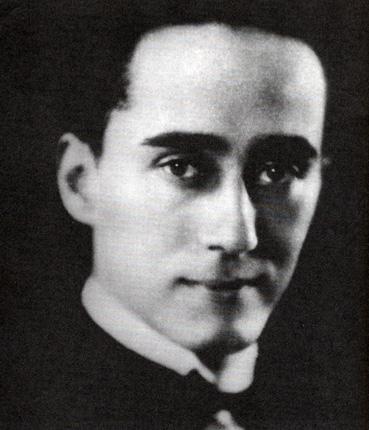 Alejandro García Caturla After his student days, Caturla lived all his life in the small central town of Remedios, where he became a lawyer to support his growing family. His Tres danzas cubanas for symphony orchestra was first performed in Spain in 1929. Bembe was premiered in Havana the same year. His Obertura cubana won first prize in a national contest in 1938. Caturla was murdered at 34 by a young gambler.[8] 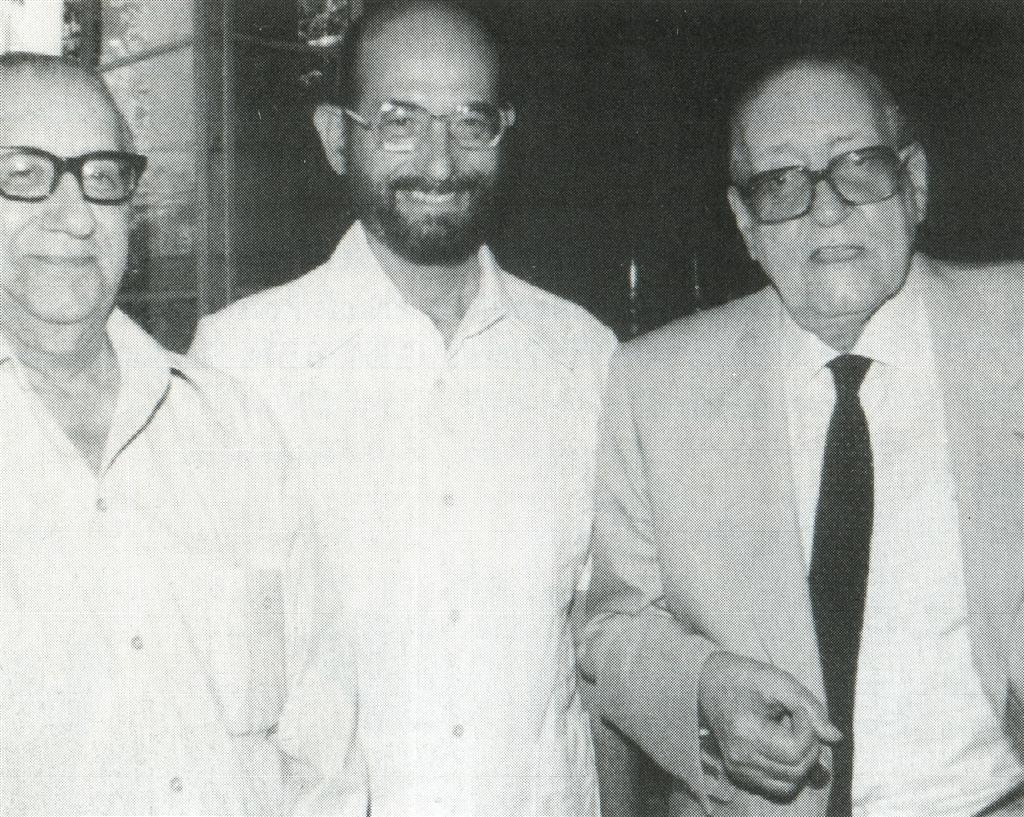 José Ardévol, Harold Gramatges, Alejo Carpentier Founded in 1942 under the guidance of José Ardévol (1911–1981), a Catalan composer established in Cuba since 1930, the "Grupo de Renovación Musical" served as a platform for a group of young composers to develop a proactive movement with the purpose of improving and literally renovating the quality of the Cuban musical environment. During its existence from 1942 to 1948, the group organized numerous concerts at the Havana Lyceum in order to present their avant-garde compositions to the general public and fostered within its members the development of many future conductors, art critics, performers and professors. They also started a process of investigation and reevaluation of the Cuban music in general, discovering the outstanding work of Carlo Borbolla[22] and promoting the compositions of Saumell, Cervantes, Caturla and Roldán. The "Grupo de Renovación Musical" included the following composers: Hilario González, Harold Gramatges, Julián Orbón, Juan Antonio Cámara, Serafín Pro, Virginia Fleites, Gisela Hernández, Enrique Aparicio Bellver, Argeliers León, Dolores Torres and Edgardo Martín.[citation needed] Other contemporary Cuban composers that were little or no related at all to the "Groupo de Renovación Musical" were: Aurelio de la Vega, Joaquín Nin-Culmell, Alfredo Diez Nieto[23] and Natalio Galán.[24] Although, in Cuba, many composers have written both classical and popular creole types of music, the distinction became clearer after 1960, when (at least initially) the regime frowned on popular music and closed most of the night-club venues, whilst providing financial support for classical music rather than creole forms. From then on, most musicians have kept their careers on one side of the invisible line or the other. After the Cuban Revolution in 1959, a new crop of classical musicians came onto the scene. The most important of these is guitarist Leo Brouwer, who have made significant contributions to the technique and repertoire of the modern classical guitar, and has been the director of the National Symphony Orchestra of Cuba. His directorship in the early 1970s of the "Grupo de Experimentacion Sonora del ICAIC" was instrumental in the formation and consolidation of the Nueva trova movement. Other important composers from the early post-revolution period that began in 1959 were: Carlos Fariñas and Juan Blanco, a pioneer of "concrete" and "electroacoustic music" in Cuba.[25] 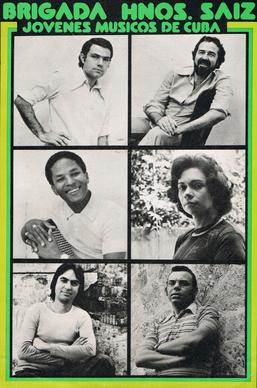 Left column, top to bottom: Armando Rodríguez Ruidíaz, Carlos Malcolm, Juan Piñera. Right column, top to bottom: Flores Chaviano, Magali Ruiz, Danilo Avilés. Closely following the early post-revolution generation, a group of young composers started to attract the attention of the public that attended classical music concerts. Most of them had obtained degrees in reputable Schools outside the country thanks to scholarships granted by the government, like Sergio Fernández Barroso (also known as Sergio Barroso), that received a post-graduate degree from the Superior Academy of Music in Prague,[26] and Roberto Valera, who studied with Witold Rudziński and Andrzej Dobrowolski in Poland.[27] Three other composers belong to this group: Calixto Alvarez,[28] Carlos Malcolm[citation needed] and Héctor Angulo.[29] In 1962, the North American composer Federico Smith arrives in Havana. He embraced the Cuban nation as his own country and became one of the most accomplished musicians living and working in Cuba at that time. He remained in Cuba until his death, and made an important contribution to the Cuban musical patrimony. During the early 1970s, a group of musicians and composers, most of them graduated from the National School of Arts and the Havana Conservatory, gathered around an organization recently created by the government as the junior section of UNEAC (National Union of Writers and Artists of Cuba), the "Brigada Hermanos Saíz.[30][31] Some of its member were composers Juan Piñera (nephew of the renowned Cuban writer Virgilio Piñera),[23] Flores Chaviano, Armando Rodriguez Ruidiaz, Danilo Avilés,[23] Magaly Ruiz, Efraín Amador Piñero and José Loyola . Other contemporary composers less involved with the organization were José María Vitier, Julio Roloff,[23] and Jorge López Marín.[32] 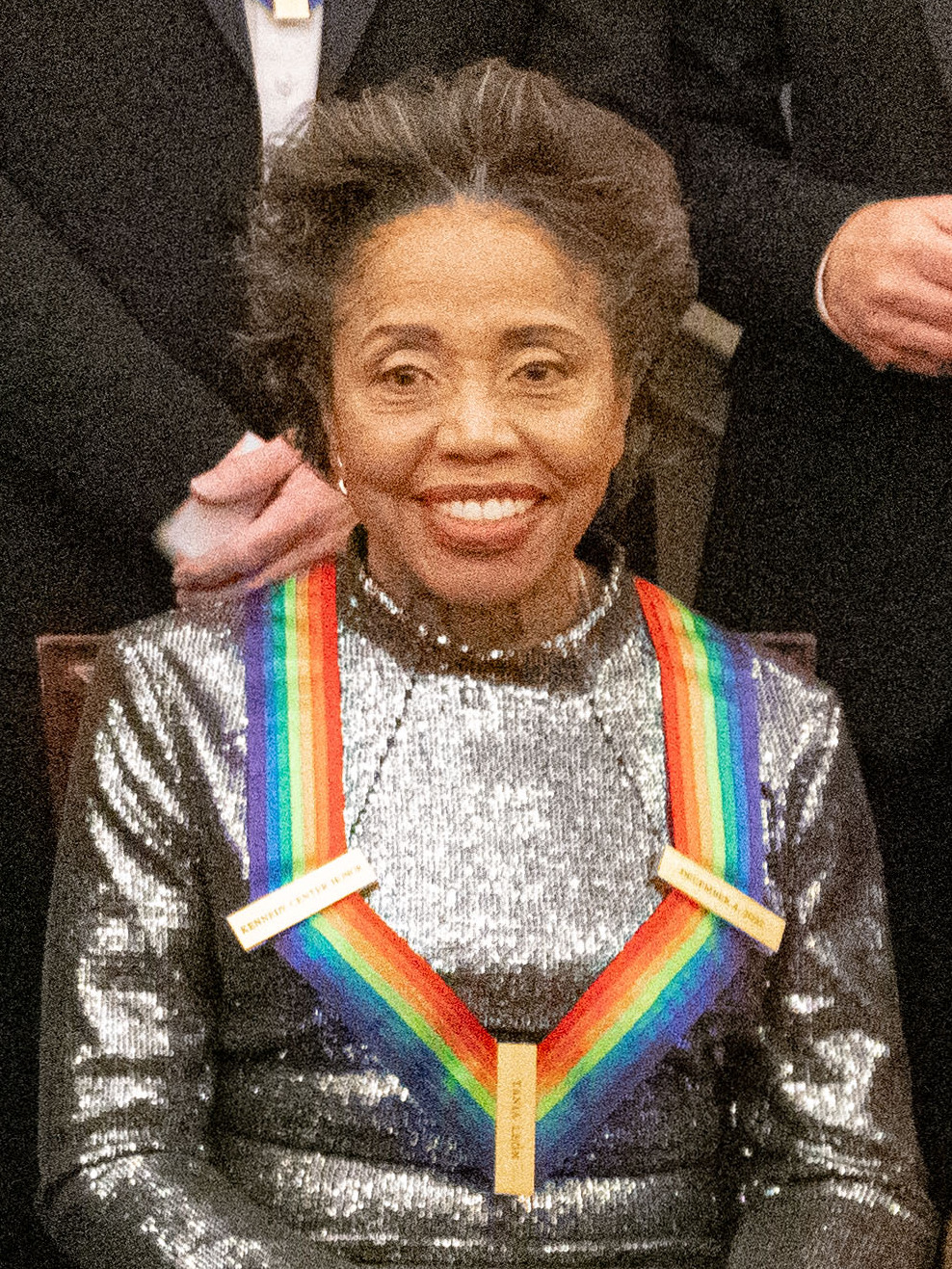 Tania León After the Cuban Revolution (1959), many future Cuban composers emigrated at a very young age and developed most of their careers outside the country. Within this group are the composers Tania León, Orlando Jacinto García, Armando Tranquilino,[23] Odaline de la Martinez, José Raul Bernardo,[32] Jorge Martín (composer) and Raul Murciano.[33] |
20世紀のクラシック音楽と芸術音楽 ホセ・マリーン・ヴァローナ 19世紀末から20世紀初頭にかけて、キューバ音楽界では多くの作曲家が活躍した。彼らは、ポピュラーソング、リート、ダンスミュージック、サルスエラ、 地方演劇、交響曲などのジャンルを開拓した。中でも、ユベール・デ・ブランク(1856~1932)、ホセ・マウリ(1856~1937)、マヌエル・マ ウリ(1857~1939)、ホセ・マリーン・ヴァローナ、エドゥアルド・サンチェス・デ・フエンテス(1874~1944)、ホルヘ・アンカーマン (1877~1941)、ルイス・カサス・ロメロ(1882~1950)、マリオ・バルデス・コスタ(1898~1930)を挙げることができる [14]。  ゴンサロ・ロイグ ホセ・マリーン・ヴァローナの作品は、19世紀末から20世紀初頭にかけてのキューバの音楽活動をつなぐものである。1896年、この作曲家は自身のサルスエラ「エル・ブルホ」に、歴史的に記録されているキューバ初のグアヒーラを取り入れた[15][16]。 この作品について、作曲家のエドゥアルド・サンチェス・デ・フエンテスはこう語っている: 「そう遠くない日の率直な批評は、「エル・ブルホ 」という不朽のグアヒーラの作者に、いつでも間違いなく受けるべき名誉を与えるだろう」[17]。 ゴンサロ・ロイグ(1890-1970)は、今世紀前半の主要人物であった[18]。作曲家、オーケストラのディレクターとして活躍し、ピアノ、ヴァイオ リン、作曲理論の資格を得た。1922年、彼は国立交響楽団の創設者の一人であり、同オーケストラを指揮した。1927年にはハバナ音楽院院長に任命され た。作曲家としては、第二次世界大戦まで人気を博した音楽劇の形式であるサルスエラを専門とした。1931年には、ハバナのマルティ劇場でブフォ・カンパ ニー(喜劇)を共同設立した。キューバで最も有名なサルスエラ『セシリア・バルデス』の作曲者であり、キューバのムラータを題材にした19世紀の有名な小 説が原作である。この作品は1932年に初演された。彼は様々な団体を設立し、音楽的なテーマについて頻繁に執筆した[19]。 20世紀最大のキューバ人ピアニスト/作曲家の一人はエルネスト・ルクオナ(1895-1963)である[20]。歌曲や舞台音楽、映画音楽の作曲家とし ても多作であった。彼の作品は、サルスエラ、アフロ・キューバン、キューバのリズム、組曲、そしてラテンのスタンダードとなった多くの歌曲で構成されてい る。シボニー』、『マラゲーニャ』、『そよ風と私(アンダルシア)』などである。1942年には大ヒット曲「いつも心に(Siempre en mi Corazon)」がアカデミー賞歌曲賞にノミネートされたが、ホワイト・クリスマスに敗れた。エルネスト・レクオーナ交響楽団は、1943年10月10 日にカーネギー・ホールで行われたキューバ解放記念コンサートで、レクオーナの『黒い狂詩曲』を初演した[21]。 今日、彼らの音楽が演奏されることはほとんどないが、「アマデオ・ロルダン(1900-1939)とアレハンドロ・ガルシア・カトゥーラ(1906-1940)は、20世紀前半のキューバの交響楽革命家であった[13]」。 ロルダンはキューバのムラータとスペイン人の父の間にパリで生まれ、1919年にキューバに渡り、1922年に新オルケスタ・シンフォニカ・デ・ラ・ハバ ナのコンサートマスター(首席ヴァイオリン奏者)となった。そこで16歳で第2ヴァイオリンのカトゥーラと出会う。ロルダンの作曲作品には、キューバの主 題による序曲(1925年)、2つのバレエがある: La Rebambaramba(1928年)とEl milagro de Anaquille(1929年)である。続いて、一連のリトミカスとポエマ・ネグラ(1930年)、Tres toques(行進曲、儀式、ダンス)(1931年)がある。Motivos de son』(1934年)では、詩人ニコラス・ギジェンの同タイトルの詩集に基づき、声楽と楽器のための8曲を作曲した。最後に作曲したのは、ピアノのため の2つの幼児向け小品(1937年)である。ロルダンは、38歳の若さで、醜い顔面の癌(彼は常習的な喫煙者であった)で亡くなった。  アレハンドロ・ガルシア・カトゥーラ 学生時代を過ごした後、カトゥーラは中央部の小さな町レメディオスで生涯を過ごし、成長する家族を養うために弁護士となった。交響楽団のための《Tres danzas cubanas》は1929年にスペインで初演された。同年、ハバナで「ベンベ」が初演された。オベルトゥーラ・クバーナは1938年に全国コンクールで 1位を獲得した。カトゥーラは34歳の時に若いギャンブラーに殺害された[8]。  ホセ・アルデヴォル、ハロルド・グラマッジス、アレホ・カルペンティエ 1930年からキューバで活動していたカタルーニャ出身の作曲家、ホセ・アルデヴォル(1911~1981)の指導のもと1942年に設立された 「Grupo de Renovación Musical 」は、キューバの音楽環境の質を向上させ、文字通り刷新することを目的とした積極的な運動を展開する若手作曲家グループのプラットフォームとして機能し た。1942年から1948年までの活動期間中、このグループはハバナ・リセウムで数多くのコンサートを開催し、前衛的な楽曲を一般大衆に披露するととも に、メンバーの中に将来の指揮者、芸術評論家、パフォーマビティ、教授を多数輩出した。彼らはまた、キューバ音楽全般の調査と再評価のプロセスを開始し、 カルロ・ボルボラ[22]の優れた作品を発見し、サウメル、セルバンテス、カトゥーラ、ロルダンの作曲を推進した。音楽改革グループ」には以下の作曲家が 含まれていた: ヒラリオ・ゴンサレス、ハロルド・グラマッジス、フリアン・オルボン、フアン・アントニオ・カマラ、セラフィン・プロ、ヴァージニア・フライテス、ジゼ ラ・エルナンデス、エンリケ・アパリシオ・ベリバー、アルゲリエス・レオン、ドロレス・トーレス、エドガルド・マルティンなどである: アウレリオ・デ・ラ・ベガ、ホアキン・ニン=クルメル、アルフレド・ディエス・ニエト[23]、ナタリオ・ガラン[24]である。 キューバでは、多くの作曲家がクラシックとポピュラー・タイプのクレオール音楽の両方を書いてきたが、1960年以降、(少なくとも当初は)政権がポピュ ラー音楽を嫌悪し、ナイトクラブの会場のほとんどを閉鎖したことで、その区別が明確になった。それ以来、ほとんどの音楽家は、見えない線のどちらか一方に 自分のキャリアを置いている。1959年のキューバ革命後、新しいクラシック音楽家が登場した。その最たるものがギタリストのレオ・ブローウェルで、彼は モダン・クラシック・ギターのテクニックとレパートリーに多大な貢献をし、キューバ国立交響楽団のディレクターも務めている。1970年代初頭に 「ICAICソノラ実験グループ」のディレクターを務めたことは、ヌエバ・トロヴァ・ムーブメントの形成と定着に貢献した。 1959年に始まった革命後初期の重要な作曲家は他にいる: カルロス・ファリニャスと、キューバにおける「具象音楽」と「電子音響音楽」の先駆者であるフアン・ブランコである[25]。  左列、上から下へ: アルマンド・ロドリゲス・ルイディアス、カルロス・マルコム、フアン・ピニェラ。右列、上から下へ: フローレス・チャビアーノ、マガリ・ルイス、ダニーロ・アビレス。 革命後間もない世代に続いて、若い作曲家たちがクラシック音楽コンサートに足を運ぶ人々の注目を集め始めた。彼らのほとんどは、政府から支給された奨学金 のおかげで、国外の評判の高い学校で学位を取得していた。例えば、セルヒオ・フェルナンデス・バロソ(セルヒオ・バロソとしても知られる)は、プラハの高 等音楽アカデミーの大学院で学位を取得し[26]、ロベルト・バレラは、ポーランドでヴィトルド・ルドジンスキとアンジェイ・ドブロヴォルスキに師事した [27]: カリクスト・アルバレス、カルロス・マルコム[要出典]、エクトル・アングーロである[29]。 1962年、北米の作曲家フェデリコ・スミスがハバナに到着する。彼はキューバという国を自分の国として受け入れ、当時キューバに住み、活動していた最も優れた音楽家の一人となった。彼は亡くなるまでキューバに留まり、キューバの音楽遺産に重要な貢献をした。 1970年代初頭、国立芸術学校とハバナ音楽院を卒業した音楽家と作曲家のグループが、UNEAC(キューバ全国作家芸術家連合)のジュニア部門として政 府によって設立されたばかりの組織「ブリガダ・エルマノス・サイス」に集まった。 [30][31]メンバーの中には、作曲家のフアン・ピニェラ(有名なキューバの作家ヴィルジリオ・ピニェラの甥)、[23]フローレス・チャビアーノ、 アルマンド・ロドリゲス・ルイディアス、ダニロ・アビレス、[23]マガリ・ルイス、エフライン・アマドール・ピニェロ、ホセ・ロヨラなどがいた。この組 織との関わりが薄かった現代作曲家としては、ホセ・マリア・ヴィティエ、フリオ・ロロフ[23]、ホルヘ・ロペス・マリンがいる[32]。  タニア・レオン キューバ革命(1959年)後、多くの未来のキューバ人作曲家が若くして移住し、キャリアのほとんどを国外で築いた。このグループの中には、タニア・レオ ン、オルランド・ハシント・ガルシア、アルマンド・トランキリーノ、[23] オダリーヌ・デ・ラ・マルティネス、ホセ・ラウル・ベルナルド、[32] ホルヘ・マルティン(作曲家)、ラウル・ムルシアーノといった作曲家がいる[33]。 |
| 21st-century classical and art music During the last decades of the 20th century and the beginning of the 21st century a new generation of composers emerged into the Cuban classical music panorama. Most of them received a solid musical education provided by the official arts school system created by the Cuban government and graduated from the Instituto Superior de Arte (ISA). Some of those composers are Louis Franz Aguirre,[34] Ileana Pérez Velázquez, Keila María Orozco,[32] Viviana Ruiz,[23] Fernando (Archi) Rodríguez Alpízar,[35] Yalil Guerra, Eduardo Morales Caso,[36] Ailem Carvajal Gómez, Irina Escalante Chernova and Evelin Ramón. All of them have emigrated and currently live and have worked in other countries.[citation needed] |
21世紀のクラシック音楽と芸術音楽 20世紀末から21世紀初頭にかけて、キューバのクラシック音楽界に新しい世代の作曲家が登場した。彼らのほとんどは、キューバ政府によって設立された公 的な芸術学校制度によってしっかりとした音楽教育を受け、高等芸術学院(ISA)を卒業した。それらの作曲家の中には、ルイス・フランツ・アギーレ、 [34] イレアナ・ペレス・ベラスケス、ケイラ・マリア・オロスコ、[32] ビビアナ・ルイス、[23] フェルナンド(アルチ)・ロドリゲス・アルピサル、[35] ヤリル・ゲラ、エドゥアルド・モラレス・カソ、[36] アイレム・カルバハル・ゴメス、イリーナ・エスカランテ・チェルノヴァ、エヴェリン・ラモンなどがいる。彼ら全員が移住し、現在は他国に住み、仕事をして いる[要出典]。 |
| Electroacoustic music in Cuba This section needs additional citations for verification. Please help improve this article by adding citations to reliable sources in this section. Unsourced material may be challenged and removed. (October 2018) (Learn how and when to remove this message) Juan Blanco was the first Cuban composer to create an electroacoustic piece in 1961. This first composition, titled "Musica Para Danza", was produced with just an oscillator and three common tape recorders. However, it was not until 1969 that another Cuban composer, Sergio Barroso, dedicated himself to the creation of electroacoustic musical compositions. In 1970, Juan Blanco began to work as a music advisor for the Department of Propaganda of ICAP (Insituto Cubano de Amistad con Los Pueblos). In this capacity, he created electroacoustic music for all the audiovisual materials produced by ICAP. After nine years working without restitution, Blanco finally obtained financing to set up an Electroacoustic Studio to be used for his work. He was appointed as Director of the Studio, but under the condition that he should be the only one to use the facility. After a few months, and without asking for permission, he opened the Electroacoustic Studio to all composers interested in working with electroacoustic technology, thus creating the ICAP Electroacoustsic Music Workshop (TIME), where he himself provided training to all participants. In 1990, the ICAP Workshop changed its name to Laboratorio Nacional de Música Electroacústica (LNME) and its main objective was to support and promote the work of Cuban electroacoustic composers and sound artists. Some years later, another electroacoustic music studio was created at the Instituto Superior de Arte (ISA). The Estudio de Música Electroacústica y por Computadoras (EMEC), currently named Estudio Carlos Fariñas de Arte Musical (Carlos Fariñas Studio of Musical Electroacoustic Art), is intended to provide electroacoustic music training to the composition students during the last years of their careers. After 1970, Cuban composers such as Leo Brouwer, Jesús Ortega, Carlos Fariñas and Sergio Vitier began also creating electroacoustic pieces; and in the 1980s a group of composers that included Edesio Alejandro, Fernando (Archi) Rodríguez Alpízar, Marietta Véulens, Mirtha de la Torre, Miguel Bonachea and Julio Roloff, started receiving instruction and working at the ICAP Electroacoustic Studio. A list of Cuban composers that have utilized elecotroacoustics technology include Argeliers León, Juan Piñera, Roberto Valera, José Loyola, Ileana Pérez Velázquez and José Angel Pérez Puentes.[37] Most Cuban composers that established their residence outside Cuba have worked with electroacoustic technology. These include composers Aurelio de la Vega, Armando Tranquilino, Tania León, Orlando Jacinto García, Armando Rodriguez Ruidiaz, Ailem Carvajal Gómez and Irina Escalante Chernova.[38] |
キューバの電子音響音楽 このセクションでは、検証のために追加の引用が必要である。このセク ションに信頼できる情報源への引用を追加することで、この記事の改善にご協力いただきたい。ソースのないものは異議申し立てされ、削除される可能性があ る。(2018年10月)(このメッセージを削除する方法とタイミングを学ぶ) フアン・ブランコは1961年、キューバ人作曲家として初めて電子音響作品を制作した。Musica Para Danza」と題されたこの最初の作品は、オシレーターと3台の一般的なテープレコーダーだけで制作された。しかし、同じくキューバの作曲家セルヒオ・バ ローゾが電子音響音楽の創作に専念したのは1969年のことだった。 1970年、フアン・ブランコはICAP(Insituto Cubano de Amistad con Los Pueblos)の宣伝部の音楽アドバイザーとして働き始めた。ICAPが制作するすべての視聴覚資料のための電子音響音楽を制作した。9年間、何の報酬 も得られないまま働き続けたブランコは、ついに資金を得て、自分の仕事に使うための電気音響スタジオを設立した。彼はスタジオのディレクターに任命された が、その施設を使うのは自分だけという条件付きだった。 数ヵ月後、彼は許可を得ることなく、電子音響スタジオを電子音響技術を使った作品に興味のある作曲家全員に開放し、ICAP電子音響音楽ワークショップ (TIME)を創設した。1990年、ICAPワークショップはラボラトリオ・ナシオナル・デ・ムジカ・エレクトロアコースティカ(LNME)と名称を変 え、キューバの電子音響作曲家やサウンド・アーティストの活動を支援・促進することを主な目的とした。 数年後、もうひとつの電子音響音楽スタジオがInstituto Superior de Arte(ISA)に設立された。EMEC(Estudio de Música Electroacústica y por Computadoras)は現在、カルロス・ファリニャス音楽電子音響スタジオ(Estudio Carlos Fariñas de Arte Musical)と名付けられ、作曲を学ぶ学生たちのキャリアの最後の時期に、電子音響音楽のトレーニングを提供することを目的としている。 1970年以降、レオ・ブローウェル、ヘスス・オルテガ、カルロス・ファリニャス、セルジオ・ヴィティエといったキューバの作曲家たちも電子音響作品を作 り始め、1980年代には、エデシオ・アレハンドロ、フェルナンド・ロドリゲス・アルピサル、マリエッタ・ベウレンス、ミルタ・デ・ラ・トーレ、ミゲル・ ボナヘア、フリオ・ロロフといった作曲家たちがICAP電子音響スタジオで指導を受け、活動を始めた。電気音響技術を利用したキューバの作曲家のリストに は、アルゲリエス・レオン、フアン・ピニェラ、ロベルト・バレラ、ホセ・ロヨラ、イレアナ・ペレス・ベラスケス、ホセ・アンヘル・ペレス・プエンテスなど がいる[37]。 キューバ国外に居を構えたキューバ人作曲家のほとんどは、電子音響技術を用いた作品を残している。その中には、アウレリオ・デ・ラ・ベガ、アルマンド・ト ランキリーノ、タニア・レオン、オルランド・ハシント・ガルシア、アルマンド・ロドリゲス・ルイディアス、アイレム・カルバハル・ゴメス、イリーナ・エス カランテ・チェルノヴァなどの作曲家が含まれる[38]。 |
| Classical guitar in Cuba Main article: Classical Guitar in Cuba From the 16th to the 19th century The guitar (as it is known today or in one of its historical versions) has been present in Cuba since the discovery of the island by Spain. As early as the 16th century, a musician named Juan Ortiz, from the village of Trinidad, is mentioned by famous chronicler Bernal Díaz del Castillo as "gran tañedor de vihuela y viola" ("a great performer of the vihuela and the guitar"). Another "vihuelista", Alonso Morón from Bayamo, is also mentioned in the Spanish conquest chronicles during the 16th century.[39][40] A disciple of famous Spanish guitarist Dionisio Aguado, José Prudencio Mungol was the first Cuban guitarist trained in the Spanish guitar tradition. In 1893 he performed at a much acclaimed concert in Havana, after returning from Spain. Mungol actively participated in the musical life of Havana and was a professor at the Hubert de Blanck conservatory.[41] 20th century and beyond Severino López was born in Matanzas. He studied guitar in Cuba with Juan Martín Sabio and Pascual Roch, and in Spain with renowned Catalan guitarist Miguel Llobet. Severino López is considered the initiator in Cuba of the guitar school founded by Francisco Tárrega in Spain.[42] Clara Romero (1888-1951), founder of the modern Cuban School of Guitar, studied in Spain with Nicolás Prats and in Cuba with Félix Guerrero. She inaugurated the guitar department at the Havana Municipal Conservatory in 1931, where she also introduced the teachings of the Cuban folk guitar style. She created the Guitar Society of Cuba (Sociedad Guitarrística de Cuba) in 1940, and also the "Guitar" (Guitarra) magazine, with the purpose of promoting the Society's activities. She was the professor of many Cuban guitarists including her son Isaac Nicola and her daughter Clara (Cuqui) Nicola.[43] After studying with his mother, Clara Romero, at the Havana Municipal Conservatory, Isaac Nicola (1916 – 1997) continued his training in Paris with Emilio Pujol, a disciple of Francisco Tárrega. He also studied the vihuela with Pujol and researched about the guitar's history and literature.[44] Modern Cuban Guitar School 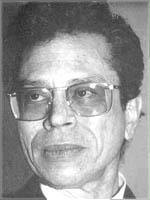 Leo Brouwer After the Cuban revolution in 1959, Isaac Nicola and other professors such as Marta Cuervo, Clara (Cuqui) Nicola, Marianela Bonet and Leopoldina Núñez were integrated to the national music schools system, where a unified didactical method was implemented. This was a nucleus for the later development of a national Cuban Guitar School with which a new generation of guitarists and composers collaborated. Maybe the most important contribution to the modern Cuban guitar technique and repertoire comes from Leo Brouwer (born 1939). The grandson of Ernestina Lecuona, sister of Ernesto Lecuona, Brouwer began studying the guitar with his father and after some time continued with Isaac Nicola. He taught himself harmony, counterpoint, musical forms and orchestration before completing his studies at the Juilliard School and the University of Hartford. New generations Since the 1960s, several generations of guitar performers, professors and composers have been formed under the Cuban Guitar School at educational institutions such as the Havana Municipal Conservatory, the National School of Arts, and the Instituto Superior de Arte. Others, such as Manuel Barrueco, a concertist of international renown, developed their careers outside the country. Among many other guitarists related to the Cuban Guitar School are Carlos Molina, Sergio Vitier, Flores Chaviano, Efraín Amador Piñero, Armando Rodriguez Ruidiaz, Martín Pedreira, Lester Carrodeguas, Mario Daly, José Angel Pérez Puentes and Teresa Madiedo. A younger group includes guitarists Rey Guerra, Aldo Rodríguez Delgado, Pedro Cañas, Leyda Lombard, Ernesto Tamayo, Miguel Bonachea,[45] Joaquín Clerch[46][47] and Yalil Guerra. |
キューバのクラシックギター 主な記事 キューバのクラシック・ギター 16世紀から19世紀まで キューバでは、スペインがキューバを発見して以来、ギター(現在または歴史的に知られているもの)は存在していた。16世紀には、トリニダッド村出身のフ アン・オルティスという音楽家が、有名な年代記作家ベルナル・ディアス・デル・カスティージョによって 「gran tañedor de vihuela y viola」(「ヴィウエラとギターの偉大な演奏者」)として言及されている。また、バヤモ出身のアロンソ・モロンも16世紀のスペイン征服年代記に登場 する[39][40]。 有名なスペイン人ギタリスト、ディオニシオ・アグアドの弟子であるホセ・プルデンシオ・マンゴルは、スペインギターの伝統に習った最初のキューバ人ギタリ ストである。1893年、スペインから帰国した彼はハバナでコンサートを開き、高い評価を得た。ムンゴルはハバナの音楽生活に積極的に参加し、ユベール・ デ・ブランク音楽院の教授も務めた[41]。 20世紀以降 セヴェリーノ・ロペスはマタンサスに生まれる。キューバではフアン・マルティン・サビオとパスクアル・ロッホに、スペインでは著名なカタルーニャ人ギタリ スト、ミゲル・ロベにギターを師事した。セヴェリーノ・ロペスは、スペインのフランシスコ・タルレガが創設したギター・スクールのキューバにおける創始者 とされている[42]。 近代キューバギター学校の創始者であるクララ・ロメロ(1888-1951)は、スペインでニコラス・プラッツに、キューバでフェリックス・ゲレーロに師 事した。1931年にハバナ市立音楽院にギター科を開設し、キューバのフォーク・ギター・スタイルの教えも紹介した。1940年にはキューバ・ギター協会 (Sociedad Guitarrística de Cuba)を設立し、協会の活動を促進する目的で「ギター」(Guitarra)誌も創刊した。彼女は息子のアイザック・ニコラや娘のクララ(クキ)・ニ コラを含む多くのキューバ人ギタリストの教授であった[43]。 ハバナ市立音楽院で母クララ・ロメロに師事した後、イサク・ニコラ(1916年 - 1997年)はパリでフランシスコ・タルレガの弟子エミリオ・プジョルに師事した。また、プジョールのもとでヴィウエラを学び、ギターの歴史や文献についても研究した[44]。 現代キューバギター派  レオ・ブローウェル 1959年のキューバ革命後、イサク・ニコラをはじめ、マルタ・クエルボ、クララ(クキ)・ニコラ、マリアネラ・ボネ、レオポルディナ・ヌニェスといった 教授陣が国立音楽学校のシステムに統合され、統一された教授法が実施された。これは後にキューバ国立ギター学校を発展させる核となり、新しい世代のギタリ ストや作曲家たちが協力することになった。 現代キューバ・ギターのテクニックとレパートリーへの最も重要な貢献は、レオ・ブローウェル(1939年生まれ)だろう。エルネスト・ルクオナの姉エルネ スティナ・ルクオナの孫であるブローウェルは、父にギターを習い始め、しばらくしてアイザック・ニコラに師事した。独学で和声、対位法、音楽形式、オーケ ストレーションを学んだ後、ジュリアード音楽院とハートフォード大学で学んだ。 新しい世代 1960年代以降、ハバナ市立音楽院、国立芸術学校、高等芸術学院などの教育機関で、キューバ・ギター・スクールのもと、数世代のギター演奏家、教授、作 曲家が形成された。また、国際的に有名なコンチェルト奏者マヌエル・バルエコのように、国外でキャリアを積んだ者もいる。キューバ・ギター学校に関係する ギタリストとしては、カルロス・モリーナ、セルジオ・ヴィティエ、フローレス・チャビアーノ、エフライン・アマドール・ピニェーロ、アルマンド・ロドリゲ ス・ルイディアス、マルティン・ペドレイラ、レスター・カロデガス、マリオ・ダリー、ホセ・アンヘル・ペレス・プエンテス、テレサ・マディエドなどがい る。若いグループには、レイ・ゲラ、アルド・ロドリゲス・デルガド、ペドロ・カニャス、レイダ・ロンバード、エルネスト・タマヨ、ミゲル・ボナケア [45]、ホアキン・クレルチ[46][47]、ヤリル・ゲラなどのギタリストがいる。 |
| Classical piano in Cuba Main article: Classical piano in Cuba Ernesto Lecuona After its arrival in Cuba at the end of the 18th century, the pianoforte (commonly called piano) rapidly became one of the favorite instruments among the Cuban population. Along with the humble guitar, the piano accompanied the popular Cuban "guarachas" and "contradanzas" (derived from the European Country Dances) at salons and ballrooms in Havana and all over the country.[48] As early as in 1804, a concert program in Havana announced a vocal concert "accompanied at the fortepiano by a distinguished foreigner recently arrived"[49] and in 1832, Juan Federico Edelmann (1795-1848), a renowned pianist, son of a famous Alsatian composer and pianist, arrived in Havana and gave a very successful concert at the Teatro Principal. Encouraged by the warm welcome, Edelmann decided to stay in Havana, and he was very soon promoted to an important position within the Santa Cecilia Philharmonic Society. In 1836, he opened a music store and publishing company.[50] One of the most prestigious Cuban musicians, Ernesto Lecuona (1895-1963), began studying piano with his sister Ernestina and continued with Peyrellade, Saavedra, Nin and Hubert de Blanck. A child prodigy, Lecuona gave a concert, at just five, at the Círculo Hispano. When he graduated from the National Conservatory, he was awarded the First Prize and the Gold Medal of his class by unanimous decision of the board. He is by far the Cuban composer of greatest international recognition and his contributions to the Cuban piano tradition are considered exceptional.[21] |
キューバのクラシックピアノ 主な記事 キューバのクラシックピアノ エルネスト・レクオナ 18世紀末にキューバに到着したピアノフォルテ(通称ピアノ)は、キューバの人々の間で急速に愛用されるようになった。地味なギターとともに、ピアノはハ バナやキューバ全土のサロンや舞踏場で、キューバで人気のある「グアラチャス」や「コントラヴァンツァス」(ヨーロッパのカントリーダンスに由来する)の 伴奏を務めた。 [また1832年には、アルザスの有名な作曲家兼ピアニストの息子で、著名なピアニストであったフアン・フェデリコ・エデルマン(1795-1848)が ハバナに到着し、テアトロ・プリンシパルでコンサートを開き、大成功を収めた。温かい歓迎に励まされ、エーデルマンはハバナに留まることを決め、すぐにサ ンタ・チェチーリア・フィルハーモニック協会の重要なポジションに昇進した。1836年には、楽器店と出版社を開いた[50]。 キューバで最も有名な音楽家の一人であるエルネスト・ルクオナ(1895-1963)は、姉のエルネスティナにピアノを習い始め、ペイレラード、サーヴェ ドラ、ニン、ユベール・デ・ブランクに師事した。神童だったルクオナは、わずか5歳でシルクロ・イスパノでコンサートを開いた。国立音楽院を卒業した時に は、審査員全員一致で最優秀賞と金賞を受賞した。キューバ人作曲家の中で最も国際的な知名度が高く、キューバのピアノの伝統に対する彼の貢献は並大抵のも のではないと考えられている[21]。 |
| Classical violin in Cuba Main article: Classical violin in Cuba From the 16th to the 18th century Bowed stringed instruments have been present in Cuba since the 16th century. Musician Juan Ortiz from the Ville of Trinidad is mentioned by chronicler Bernal Díaz del Castillo as a "great performer of "vihuela" and "viola".[42] On In 1764, Esteban Salas y Castro, became the new chapel master of the Santiago de Cuba Cathedral, and to fulfill his musical duties he counted with a small vocal-instrumental group that included two violins.[51] In 1793, numerous colonists fleeing from the slave revolt in Saint Domingue arrived in Santiago de Cuba, and an orchestra consisting of a flute, oboe, clarinet, trumpet, three horns, three violins, viola, two violoncellos, and percussion was founded.[52] From the 18th to the 19th century During the transition from the 18th to the 19th centuries, the Havanese Ulpiano Estrada (1777–1847) offered violin lessons and conducted the Teatro Principal orchestra from 1817 to 1820. Apart from his activity as a violinist, Estrada kept a very active musical career as a conductor of numerous orchestras, bands and operas, and composing many contradanzas and other dance pieces, such as minuets and valses.[53] José Vandergutch, Belgian violinist, arrived at Havana along with his father Juan and brother Francisco, also violinists. They returned at a later time to Belgium, but José established his permanent residence in Havana, where he acquired great recognition. Vandergutch offered numerous concerts as a soloist and accompanied by several orchestras, around the mid-19th century. He was a member of the Classical Music Association and also a Director of The "Asociación Musical de Socorro Mutuo de La Habana."[54] Within the universe of the classical Cuban violin during the 19th century, there are two outstanding Masters that may be considered among the greatest violin virtuosos of all time; they are José White Lafitte y Claudio Brindis de Salas Garrido. 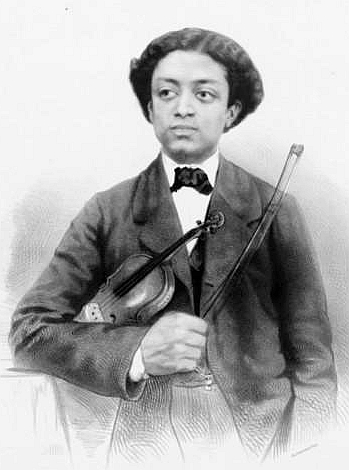 José White in 1856, after receiving ana award from the Conservatoire de Paris After receiving his first musical instruction from his father, the virtuoso Cuban violinist José White Lafitte (1835–1918) offered his first concert in Matanzas on March 21, 1854. In that presentation he was accompanied by the famous American pianist and composer Louis Moreau Gottschalk, whom encouraged him to further his musical instruction in Paris, and also collected funds for that purpose.[55] José White studied musical composition in the Conservatoire de Paris from 1855 to 1871. Just ten months after his arrival he won the first prize in the violin category on the Conservatorie's contest and was highly praised by Gioachino Rossini. At a later time he was a professor of the renowned violinists George Enescu and Jacques Thibaud. From 1877 to 1889, White was appointed as Director of the Imperial Conservatory in Rio de Janeiro, Brasil, where he also served as court musician of the Emperor Pedro II.[56] At a later time he returned to Paris where he stayed until his death. The famous violin named "Swan's song" was his preferred instrument and his most famous composition is the Habanera "La bella cubana". White also composed many other pieces, including a concert for violin and orchestra.[57] 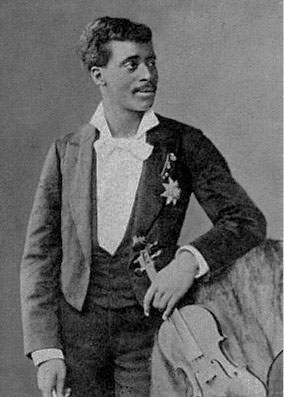 Claudio José Domingo Brindis de Salas y Garrido, called the "Black "Paganini" posing with his famous Stradivarius Claudio José Domingo Brindis de Salas y Garrido (1852–1911) was a renowned Cuban violinist, son of the also famous violinist, double-bassist and conductor Claudio Brindis de Salas (1800-1972), which conducted one of the most popular orchestras of Havana during the first half of the 19th century, named "La Concha de Oro" (The Golden Conch). Claudio José surpassed the fame and expertise of his father and came to acquire international recognition.[58][59][60] Claudio Brindis de Salas Garrido began his musical studies with his father and continued with Maestros José Redondo and the Belgian José Vandergutch. He offered his first concert in Havana in 1863, in which Vandegutch participated as accompanist. The famous pianist and composer Ignacio Cervantes also participated in that event. According with the contemporary critique, Brindis de Salas was considered one of the most outstanding violinists of his time at an international level. Alejo Carpentier referred to him as: "The most outstanding black violinist from the 19th century... something without any precedent in the musical history of the continent".[61] The French government named him member of the Légion d'Honneur, and gave him a nobility title of "Baron". In Buenos Aires he received a genuine Stradivarius, and while living in Berlin he married a German lady, was named Chamber Musician of the Emperor and received an honorary citizenship from that country. Brindis de Salas died poor and forgotten in 1911 from tuberculosis, in Buenos Aires, Argentina. In 1930 his remains were transferred to Havana with great honors.[62] Another outstanding Cuban violinist from the 19th century was Rafael Díaz Albertini (1857–1928). He studied violin with José Vandergutch and Anselmo López (1841-1858), well known Havanese violinist that was dedicated also to music publishing. In 1870, Albertini travelled to Paris with the purpose of perfecting his technique with famous violinist Jean-Delphin Alard, and in 1875 received First prize in the Paris Contest, in which he subsequently participated as a Juror. He toured extensively through the world, accompanied some times by prestigious Masters such as Hugo Wolf and Camille Saint-Saëns. In 1894 he made presentations, along with Ignacion Cervantes, through the most important cities of Cuba.[63] A list of prominent Cuban violinist from the second half of the 19th century and the first of the 20th may include: Manuel Muñoz Cedeño (b. 1813), José Domingo Bousquet (b. 1823), Carlos Anckermann (b. 1829), Antonio Figueroa (b. 1852), Ramón Figueroa (b. 1862), Juan Torroella (b.1874), Casimiro Zertucha (b. 1880), Joaquín Molina (b. 1884), Marta de La Torre (1888), Catalino Arjona (b. 1895) and Diego Bonilla (1898-).[64] From the 20th to the 21st century During the first half of the 20th century the name of Amadeo Roldán stands out (1900–1939), because apart from an excellent violinist, professor and conductor, Roldán is considered one of the most important Cuban composers of all time. After his graduation at the Conservatoire de Paris in 1935 with just 16 years old, the renowned Cuban violinist Ángel Reyes (1919–1988) developed a very successful career as a soloist and also accompanied by prestigious orchestras of many countries. He established his residence in the United States at a very young age, obtained an award in the Ysaÿe Contest in Brussels and was a professor at the Michigan and Northwestern Universities, until his retirement in 1985.[65] Eduardo Hernández Asiaín (1911-2010) was born in Havana, began his musical studies at a very early age and offered his first concert with just seven years old. When he was 14, he obtained the First Award at the Municipal Conservatory of Havana and was appointed as Concertino of the Havana Symphony Orchestra. In 1932, he travelled to Madrid to further his musical education with professors Enrique Fernández Arbós and Antonio Fernández Bordas. Since 1954, Hernández Asiaín performed as a soloist with the orchestras from the Pasdeloup Concert Society and the Radiodiffusion française in Paris, the "Orquesta Nacional de España", the "Orquesta Sinfónica de Bilbao", the "Orquesta de Cámara de Madrid" and the "Orquesta Sinfónica y de Cámara de San Sebastián", of which he is the founder. In 1968, he was appointed as First Violin of the "Cuarteto Clásico" of RTVE, participating with pianist Isabel Picaza González in the "Quinteto Clásico de RNE", with which he offered concerts and made numerous recordings in Spain and other countries. He also toured extensively through the US.[66] Other prominent Cuban violinists from the first half of the 20th century are: Robero Valdés Arnau (1919-1974), Alberto Bolet and Virgilio Diago.[67] After 1959, already in the post revolutionary period, stands out a Cuban violinist that has made a substantial contribution, not just to the development of the violin and the bowed string instruments, but also to the national musical culture in general. Evelio Tieles began to study music in Cuba with his father, Evelio Tieles Soler, when he was just seven years old,[68] and continued at a later time with professor Joaquín Molina. Between 1952 and 1954, Tieles studied violin in Paris, France, with Jacques Thibaud and René Benedetti. In 1955 he returned to Paris and studied at the National Superior Music Conservatory in that city, and in 1958, he continued his musical training at Conservatorio Tchaikovsky in Moscú, where he was a disciple of renowned violinists David Oistrakh and Igor Oistrakh. Tieles graduated in 1963 and by recommendation of the Conservatory he pursued his master's degree from 1963 to 1966, with the same mentioned professors.[68] Tieles received also professional training from the prestigious violinists Henryk Szeryng and Eduardo Hernández Asiaín.[69] Evelio Tieles has offered numerous presentations as a concert performer, in a duo with his brother, pianist Cecilio Tieles, or accompanied by the Cuban National Symphony Orchestra and other symphonic and chamber ensembles. He has performed along with prestigious conductors such as Thomas Sanderling, Boris Brott, Enrique González Mántici y Manuel Duchesne Cuzán, among others.[citation needed] Tieles has established his residence in Spain since 1984, and he teaches violin in the Vila-Seca Conservatory, in the province of Tarragona, where he has been appointed as "Professor Emeritus".[citation needed] He has also served at the Superior Conservatory of the Barcelona Lyceum as Chief of the Chamber Music Department (1991–1998), Head of the Division of Bowed String Instruments (1986-2002) and Academic Director (2000–2002).[69] Apart from his outstanding career as a concert performer and professor, during the Post-Revolutionary period, Tieles promoted and organized in Cuba the bowed string instruments training, fundamentally for the violin.[69] Another prominent violinist is professor Alla Tarán (1941). She was formed as a violinist in her native Ukraine and worked as a professor of Chamber Ensemble Practice. Tarán established her residence in Cuba since 1969.[citation needed] Alfredo Muñoz (1949) began studying the violin at Conservatorio Orbon in Havana, Cuba, and subsequently continued at the National School of Arts and the Instituto Superior de Arte (ISA). He joined the National Symphony Orchestra as a violinist in 1972 and since then has been very active as a soloist and a member of the White Trio, in Cuba and abroad. He is currently a professor at the Instituto Superior de Artes (ISA).[70] Other Cuban violinists that have developed their careers between the 20th and the 21st century are: Armando Toledo (1950), Julián Corrales (1954), Miguel del Castillo and Ricardo Jústiz.[64] 21st century This section needs additional citations for verification. Please help improve this article by adding citations to reliable sources in this section. Unsourced material may be challenged and removed. (October 2018) (Learn how and when to remove this message) Already at the beginning of the 21st century the violinists Ilmar López-Gavilán, Mirelys Morgan Verdecia, Ivonne Rubio Padrón, Patricia Quintero and Rafael Machado are worthy of note. |
キューバのクラシック・ヴァイオリン 主な記事 キューバのクラシック・ヴァイオリン 16世紀から18世紀まで 弓を使った弦楽器は16世紀からキューバに存在していた。1764年、エステバン・サラス・イ・カストロがサンティアゴ・デ・クーバ大聖堂の新しい礼拝堂 司祭となり、音楽的任務を果たすために2台のヴァイオリンを含む小さな声楽と楽器のグループを数えた。 [1793年、サン・ドミンゲの奴隷反乱から逃れてきた多くの植民者たちがサンティアゴ・デ・クーバに到着し、フルート、オーボエ、クラリネット、トラン ペット、3本のホルン、3本のヴァイオリン、ヴィオラ、2本のヴィオロンチェロ、打楽器から成るオーケストラが設立された[52]。 18世紀から19世紀へ 18世紀から19世紀への移行期には、ハヴァネス出身のウルピアーノ・エストラーダ(1777-1847)がヴァイオリンのレッスンを行い、1817年か ら1820年までテアトロ・プリンシパルのオーケストラを指揮した。ヴァイオリニストとしての活動とは別に、エストラーダは数多くのオーケストラ、楽団、 オペラの指揮者として非常に活発な音楽活動を続け、メヌエットやヴァルスのようなコントランサやその他の舞曲を数多く作曲した[53]。 ベルギー人ヴァイオリニストのホセ・ヴァンダーガッチは、同じくヴァイオリニストの父フアンと弟フランシスコとともにハバナに到着した。彼らは後にベル ギーに戻ったが、ホセはハバナに定住し、そこで大きな評価を得た。ヴァンデルガッチは、19世紀半ば頃、ソリストとして、またいくつかのオーケストラの伴 奏者として、数多くのコンサートを開いた。彼はクラシック音楽協会のメンバーであり、ラ・ハバナ音楽協会(Asociación Musical de Socorro Mutuo de La Habana)の理事でもあった[54]。 19世紀におけるキューバのクラシック・ヴァイオリンの世界には、史上最高のヴァイオリン・ヴィルトゥオーゾとみなされる2人の傑出した巨匠がいる。  1856年、パリ国立高等音楽院から勲章を授与されたホセ・ホワイト 父親から初めて音楽の手ほどきを受けたキューバの名ヴァイオリニスト、ホセ・ホワイト・ラフィット(1835-1918)は、1854年3月21日にマタ ンサスで最初のコンサートを開いた。その演奏会では、有名なアメリカ人ピアニスト兼作曲家のルイス・モロー・ゴットシャルクが同伴し、彼は彼にパリで音楽 教育を受けることを勧め、そのための資金も集めた[55]。 ジョゼ・ホワイトは1855年から1871年までパリ音楽院で作曲を学んだ。到着してわずか10ヶ月後、彼はコンセルヴァトワールのコンクールのヴァイオ リン部門で優勝し、ジョアキーノ・ロッシーニに高く評価された。その後、著名なヴァイオリニスト、ジョージ・エネスクとジャック・ティボーの教授を務め た。 1877年から1889年にかけて、ホワイトはブラジルのリオ・デ・ジャネイロにある帝国音楽院の院長に任命され、皇帝ペドロ2世の宮廷音楽家も務めた [56]。白鳥の歌」と名付けられた有名なヴァイオリンは彼の好んだ楽器であり、最も有名な曲はハバネラ「ラ・ベッラ・クバーナ」である。ホワイトは、 ヴァイオリンとオーケストラのための協奏曲など、他にも多くの作品を作曲した[57]。  黒い 「パガニーニ」」と呼ばれたクラウディオ・ホセ・ドミンゴ・ブリンディス・デ・サラス・イ・ガリドは、有名なストラディヴァリウスを手にポーズをとっている。 クラウディオ・ホセ・ドミンゴ・ブリンディス・デ・サラス・イ・ガリード(1852-1911)は、キューバの有名なヴァイオリニストであり、同じく有名 なヴァイオリニスト、コントラバス奏者、指揮者であるクラウディオ・ブリンディス・デ・サラス(1800-1972)の息子である。クラウディオ・ホセ は、父の名声と専門知識を凌駕し、国際的な評価を得るようになった[58][59][60]。 クラウディオ・ブリンディス・デ・サラス・ガリードは父のもとで音楽の勉強を始め、マエストロであるホセ・レドンドとベルギー人のホセ・ヴァンダーガッチ に師事した。1863年にハバナで最初のコンサートを開き、ヴァンデルガッチも伴奏者として参加した。有名なピアニストで作曲家のイグナシオ・セルバンテ スもこのコンサートに参加した。 同時代の批評によると、ブリンディス・デ・サラスは、国際的なレベルで当時最も優れたヴァイオリニストの一人とみなされていた。アレホ・カルペンティエは彼をこう呼んだ: 「19世紀で最も傑出した黒人ヴァイオリニスト......大陸の音楽史上、前例がない」[61]。 フランス政府は彼にレジオン・ドヌール勲章を授与し、「男爵」の貴族称号を与えた。ブエノスアイレスでは本物のストラディヴァリウスを手に入れ、ベルリン 在住時にはドイツ人女性と結婚し、皇帝の室内楽奏者に任命され、同国の名誉市民権を得た。ブリンディス・デ・サラスは1911年、アルゼンチンのブエノス アイレスで結核のため貧しく忘れられた存在となっていた。1930年、彼の遺骨はハバナに移された。 19世紀に活躍したもう一人の傑出したキューバのヴァイオリニストは、ラファエル・ディアス・アルベルティーニ(1857-1928)である。アルベル ティーニは、ホセ・ヴァンデルガッチとアンセルモ・ロペス(1841-1858)にヴァイオリンを師事した。1870年、アルベルティーニは、有名なヴァ イオリニスト、ジャン・デルフィン・アラールのもとで技巧を磨くためにパリに渡り、1875年にはパリ・コンクールで一等賞を受賞、その後審査員として参 加した。ユーゴ・ウルフやカミーユ・サン=サーンスといった一流の巨匠の伴奏で世界各地を演奏旅行した。1894年には、イグナシオン・セルバンテスとと もにキューバの主要都市で公演を行った[63]。 19世紀後半から20世紀初頭にかけてのキューバの著名なヴァイオリニストのリストには、以下のようなものがある: マヌエル・ムニョス・セデーニョ(1813年生まれ)、ホセ・ドミンゴ・ブスケ(1823年生まれ)、カルロス・アンケルマン(1829年生まれ)、アン トニオ・フィゲロア(1852年生まれ)、ラモン・フィゲロア(1862年生まれ)、フアン・トロエラ(1874年生まれ )、カジミロ・ゼルチャ(1880年生)、ホアキン・モリナ(1884年生)、マルタ・デ・ラ・トーレ(1888年生)、カタリノ・アルホナ(1895年 生)、ディエゴ・ボニーリャ(1898-)である[64]。 20世紀から21世紀 20世紀前半には、アマデオ・ロルダン(1900-1939)の名が際立っている。優れたヴァイオリニスト、教授、指揮者であると同時に、ロルダンはキューバで最も重要な作曲家の一人とみなされているからである。 キューバの著名なヴァイオリニスト、アンヘル・レイエス(1919-1988)は、1935年にわずか16歳でパリ音楽院を卒業した後、ソリストとして、 また各国の一流オーケストラの伴奏者として大成功を収めた。彼は若くしてアメリカに居を構え、ブリュッセルのイザイ・コンテストで受賞し、1985年に引 退するまでミシガン大学とノースウェスタン大学で教授を務めた[65]。 エドゥアルド・エルナンデス・アジアイン(1911-2010)はハバナで生まれ、幼い頃から音楽の勉強を始め、わずか7歳で最初のコンサートを開いた。 14歳の時、ハバナ市立音楽院で一等賞を受賞し、ハバナ交響楽団のコンチェルティーノに任命された。1932年、マドリードに渡り、エンリケ・フェルナン デス・アルボスとアントニオ・フェルナンデス・ボルダスの両教授のもとで音楽教育を受ける。1954年以来、エルナンデス・アジアインは、ソリストとして パリのパスデループ・コンサート協会やラジオディフュージョン・フランセーズ、スペイン国立管弦楽団、ビルバオ交響楽団、マドリッド・カマラ管弦楽団、そ して自身が創設者であるサン・セバスティアン・シンフォニカ管弦楽団と共演している。1968年、RTVEの 「クァルテート・クラシコ 」のファースト・ヴァイオリンに任命され、ピアニストのイサベル・ピカサ・ゴンサレスとともに 「クインテート・クラシコ・デ・RNE 」に参加し、スペインやその他の国々でコンサートを開き、数多くのレコーディングを行った。また、アメリカ国内でも大規模なツアーを行った[66]。 20世紀前半に活躍した他の著名なキューバ人ヴァイオリニストは以下の通りである: ロベロ・バルデス・アルナウ(1919-1974)、アルベルト・ボレット、ヴィルジリオ・ディアゴなどがいる[67]。 1959年以降、革命後の時代にはすでに、ヴァイオリンと弦楽器の発展だけでなく、国の音楽文化全般に多大な貢献をしたキューバのヴァイオリニストがいる。 エヴェリオ・ティエレスは、わずか7歳の時に父であるエヴェリオ・ティエレス・ソレールにキューバで音楽を習い始め[68]、その後、ホアキン・モリーナ 教授に師事した。1952年から1954年にかけて、ティエレスはフランスのパリでジャック・ティボーとルネ・ベネデッティにヴァイオリンを師事した。 1955年にパリに戻り、同市の国立高等音楽院で学び、1958年にはモスクーのチャイコフスキー音楽院で音楽教育を受け、著名なヴァイオリニスト、ダ ヴィッド・オイストラフとイーゴリ・オイストラフの弟子となった。ティエルスは1963年に卒業し、音楽院の推薦により、1963年から1966年まで修 士課程に進み、同じ教授陣のもとで研鑽を積んだ[68]。ティエルスは、著名なヴァイオリニスト、ヘンリク・セリンとエドゥアルド・エルナンデス・アジア インからも専門的な指導を受けた[69]。 弟でピアニストのセシリオ・ティエレスとのデュオや、キューバ国立交響楽団をはじめとする交響楽団や室内楽団との共演など、コンサートパフォーマーとして 数多くの作品を発表している。トーマス・サンデルリング、ボリス・ブロット、エンリケ・ゴンサレス・マーンティチ、マヌエル・ドゥチェスネ・クザンなど一 流の指揮者と共演している[要出典]。 ティエルスは1984年からスペインに居を構え、タラゴナ県にあるヴィラ=セカ音楽院でヴァイオリンを教えており、「名誉教授」に任命されている[要出 典]。また、バルセロナ高等音楽院では、室内楽科主任(1991-1998)、弓奏弦楽器科主任(1986-2002)、アカデミック・ディレクター (2000-2002)を務めている[69]。 コンサート演奏家、教授としての卓越したキャリアとは別に、革命後のキューバでは、ティエルスは、基本的にヴァイオリンのための弓付き弦楽器の訓練を推進し、組織した[69]。 もう一人の著名なヴァイオリニストは、アラ・タラン教授(1941年)である。彼女は母国ウクライナでヴァイオリニストとして結成され、室内アンサンブルの教授として活動していた。タランは1969年からキューバに居を構えている[要出典]。 アルフレード・ムニョス(1949年)は、キューバ・ハバナのオルボン音楽院でヴァイオリンを学び始め、国立芸術学校と高等芸術学院(ISA)で学んだ。 1972年に国立交響楽団にヴァイオリニストとして入団して以来、ソリストとして、またホワイト・トリオのメンバーとして、キューバ国内外で精力的に活動 している。現在はISA(Instituto Superior de Artes)の教授を務めている[70]。 20世紀から21世紀にかけてキャリアを積んだキューバのヴァイオリニストは他にもいる: アルマンド・トレド(1950年)、フリアン・コラレス(1954年)、ミゲル・デル・カスティーリョ、リカルド・フスティスである[64]。 21世紀 このセクションは、検証のために追加の引用が必要である。このセクションに信頼できる情報源への引用を追加することで、この記事の改善にご協力いただきた い。ソースのないものは異議申し立てされ、削除される可能性がある。(2018年10月)(このメッセージを削除する方法とタイミングを学ぶ) 21世紀初頭にはすでに、イルマール・ロペス=ガビラン、ミレリス・モルガン・ベルデシア、イヴォンヌ・ルビオ・パドロン、パトリシア・キンテロ、ラファエル・マチャドのヴァイオリニストが注目に値する。 |
| Opera in Cuba Main article: Opera in Cuba Opera has been present in Cuba since the latest part of the 18th century, when the first full-fledged theater, called Coliseo, was built. Since then to present times, the Cuban people have highly enjoyed opera, and many Cuban composers have cultivated the operatic genre, sometimes with great success at an international level. The best Cuban lyrical singer in the 20th century was the operatic tenor Francisco Fernandez Dominicis (Italian name: Francesco Dominici) (1885-1968). The best Cuban female lyrical singer in the 20th century was the mezzo-soprano Marta Perez (1924-2009). She sang at La Scala in Milan, Italy in 1955.[71] The 19th century The first documented operatic event in Havana took place in 1776. That presentation was mentioned in a note published in the newspaper Diario de La Habana on December 19, 1815: "Today, Wednesday 19th of the current, if the weather allows, the new tragic opera of merit in three acts that contains 17 pieces of music, titled Dido Abandoned will be performed ... This is one of the premiere dramas from the French theater. In Italy, the one composed by renowned Metastasio deserved a singular applause, and was sung in this city on October 12, 1776."[72] Cristóbal Martínez Corrés was the first Cuban opera composer, but his Works, such as El diablo contrabandista and Don papanero were never premiered and have not been preserved until the present time. Born in Havana, in 1822, composer and pianist Martínez Corrés established his residence together with his family in France when he was just nine years old; and at a later tame they went to Italy. Due to his premature death, a third opera named Safo, never surpassed an early creative stage. Martínez Corrés died in Genoa, in 1842.[16] Gaspar Villate y Montes was born in Havana, in 1851 and since an early age he showed a great musical talent. As a child, he began to study piano with Nicolás Ruiz Espadero and in 1867, when he was just 16 years old, he composed his first opera on a drama by Victor Hugo, titled Angelo, tirano de Padua. A year later, at the beginning of the 1868 war, he travelled to the United States with his family and upon his return to Havana in 1871 he wrote another opera called Las primeras armas de Richelieu. Villate travelled to France with the purpose to continue his music studies in the Paris Conservatory, where he received classes from François Bazin, Victorien de Joncieres and Adolphe Danhauser. He composed numerous instrumental pieces such as contradanzas, habaneras, romances and waltzes, and in 1877 he premiered with great audience acclaim his opera Zilia in Paris, which was presented in Havana in 1881. Since then, Villate focused his efforts mainly in opera and composed pieces such as La Zarina and Baltazar, premiered at La Haya and Teatro Real de Madrid respectively. It is known that he worked on an opera with a Cuban theme called Cristóbal Colón, but its manuscript has been lost. Villate died in Paris in 1891, soon after starting to compose a lyrical drama called Lucifer, from which some fragments have been preserved.[73] From 1901 to 1959 Eduardo Sánchez de Fuentes was born in Havana, in 1874, within an artistic family; his father was a writer and his mother a pianist and singer. He began his musical studies at Conservatorio Hubert de Blanck and at a later time took classes from Carlos Anckermann. He received also a Law Degree in 1894.[74] When Sánchez de Fuentes was just 18 years old, he composed the famous Habanera "Tú", which became an extraordinary international success. Alejo Carpentier said it was: "the most famous Habanera".[75] On October 26, 1898, Sánchez de Fuentes premiered at the Albisu Theater in Havana his first opera called Yumuri, based on the Island's colonization theme. In it, an aborigine princess falls in love with a handsome Spanish conqueror, which abducts her at the wedding ceremony with another indigenous character. At the end, while escaping, both suffer a tragic death during an earthquake.[76] Sánchez de Fuentes would go on to compose another five operas: El Náufrago (1901), Dolorosa (1910), Doreya (1918), El Caminante (1921) and Kabelia (1942).[77] From 1960 to present time This section needs additional citations for verification. Please help improve this article by adding citations to reliable sources in this section. Unsourced material may be challenged and removed. (October 2018) (Learn how and when to remove this message) One of the most active and outstanding composers of his generation, Sergio Fernández Barroso (also known as Sergio Barroso) (1946), is the author of an opera called La forma del camino, which also possesses the complementary title of s-XIV-69 (which means Siglo XIV – 1969). With an approximate duration of 60 minutes, this piece utilizes as a script a story from the Popol Vuh (the sacred text of the Maya culture) about the mythic brothers Hunahpu and Ixbalanqué. The score includes soloists and a choir of nine mixed voices, accompanied by an instrumental group and an electro-acoustic quadraphonic system. The scene requires a stage elevated over the choir spatial position, which members wear dinner jackets, in opposition to the more casual attire of the soloists. All singers wear Indian masks.[78] Most recently the work of two young Cuban composers stand out, Jorge Martín (composer) and Louis Franz Aguirre. Jorge Martín (1959) was born in Santiago de Cuba and established his residence in the US at a very young age. He studied musical composition at the Yale and Columbia Universities. He has composed three lyric pieces: Beast and Superbeast, a series of four operas in one act each, based on short stories by Saki; Tobermory, opera in one act that obtained first prize in the Fifth Biennial of the National Opera Association (USA), and has been presented in several cities of the United States; and Before Night Falls, an opera based on the famous autobiography of the Cuban novelist, playwright and poet Reinaldo Arenas, renowned dissident from the Fidel Castro government.[79] Louis Franz Aguirre (1968) is currently one of the most prolific and renowned Cuban composers at an international level. His catalog includes four operatic works: Ebbó (1998), premiered on January 17, 1999, at the Brotfabrik Theater in Bonn, Germany; Ogguanilebbe (Liturgy of the divine word) (2005), premiered in the Salla dil Parlamento d'il Castello di Udine, Italy. Yo el Supremo (Comic play with Dictator in one Act), premiered on October 27, 2015, in the Teatro Galileo, Madrid, Spain and The way the dead love (Theogony: an operatic manifest), commissioned by the Lydenskab Ensemble and financed by KODA, Denmark. Premiered on February 24, 2017, in Godsbanen, Aarhus, Denmark, as part of the Århus European Capital of Culture 2017. |
キューバのオペラ 主な記事 キューバのオペラ キューバには、18世紀末にコリセオと呼ばれる本格的な劇場が建設されて以来、オペラが存在している。それ以来現在に至るまで、キューバ国民はオペラを大 いに楽しみ、多くのキューバ人作曲家がオペラのジャンルを開拓し、時には国際的なレベルで大成功を収めている。20世紀最高のキューバ人叙情歌手は、オペ ラのテノール歌手フランシスコ・フェルナンデス・ドミニチ(イタリア名:フランチェスコ・ドミニチ)(1885-1968)である。20世紀最高のキュー バ人女性叙情歌手は、メゾ・ソプラノのマルタ・ペレス(1924-2009)である。彼女は1955年にイタリアのミラノ・スカラ座で歌っている [71]。 19世紀 ハバナで初めてオペラが上演されたのは1776年のことである。その上演は、1815年12月19日にDiario de La Habana紙に掲載されたメモに記載されている: 本日19日水曜日、天候が許せば、17曲からなる3幕の悲劇的オペラ『見捨てられたディド』が上演される。これはフランス演劇の初演作品のひとつである。 イタリアでは、高名なメタスタシオが作曲したものが特筆すべき喝采を浴び、1776年10月12日にこの街で歌われた」[72]。 クリストバル・マルティネス・コレスはキューバ初のオペラ作曲家であったが、彼の作品であるEl diablo contrabandistaやDon papaneroは初演されることなく、現在まで保存されていない。1822年にハバナで生まれた作曲家でピアニストのマルティネス・コレスは、わずか9 歳の時に家族とともにフランスに居を構え、その後イタリアに渡った。夭折のため、サフォと名付けられた3作目のオペラは、初期の創作段階を超えることはな かった。マルティネス・コレスは1842年にジェノヴァで死去した[16]。 ガスパル・ビジャテ・イ・モンテスは1851年にハバナで生まれ、幼い頃から音楽の才能を発揮した。幼い頃からニコラス・ルイス・エスパデロにピアノを習 い、1867年、弱冠16歳でヴィクトル・ユーゴーの戯曲を題材にした最初のオペラ『パドヴァのティラノ、アンジェロ』を作曲した。その1年後、1868 年の戦争が始まると、彼は家族とともにアメリカに渡り、1871年にハバナに戻ると、また『リシュリューの武器』というオペラを作曲した。 ヴィラートは、パリ音楽院で音楽の勉強を続けるためにフランスに渡り、フランソワ・バザン、ヴィクトリアン・ド・ヨンシエール、アドルフ・ダンハウザーか ら指導を受けた。1877年、オペラ『ジリア』をパリで初演し、聴衆の大喝采を浴びた。それ以来、ビジャテは主にオペラに力を入れ、『ラ・ザリーナ』や 『バルタザール』といった作品を作曲し、それぞれラ・ハヤやマドリード・レアル劇場で初演された。クリストバル・コロン(Cristóbal Colón)というキューバをテーマにしたオペラに取り組んだことも知られているが、その原稿は失われている。 1891年、ヴィラートは『ルシファー』という叙情劇の作曲に着手した直後にパリで死去したが、その断片が残っている[73]。 1901年から1959年まで 父は作家で、母はピアニスト兼歌手であった。父は作家、母はピアニストで歌手であった。フベール・デ・ブランク音楽院で音楽の勉強を始め、後にカルロス・ アンカーマンのレッスンを受ける。1894年には法律の学位も取得した[74]。サンチェス・デ・フエンテスがまだ18歳のとき、有名なハバネラ「Tú」 を作曲し、世界的に大成功を収めた。アレホ・カルペンティエはこの曲をこう評した: 「最も有名なハバネラである」と述べている[75]。 1898年10月26日、サンチェス・デ・フエンテスはハバナのアルビス劇場で、島の植民地化をテーマにした最初のオペラ「ユムリ」を初演した。このオペ ラでは、原住民の王女がハンサムなスペイン人征服者と恋に落ちるが、そのスペイン人征服者は、別の原住民との結婚式で彼女を誘拐する。サンチェス・デ・フ エンテスはその後も5つのオペラを作曲する: El Náufrago』(1901年)、『Dolorosa』(1910年)、『Doreya』(1918年)、『El Caminante』(1921年)、『Kabelia』(1942年)である[77]。 1960年から現在まで このセクションは、検証のために追加の引用が必要である。このセクションに信頼できる情報源への引用を追加することで、この記事の改善にご協力いただきた い。ソースのないものは異議申し立てされ、削除される可能性がある。(2018年10月)(このメッセージを削除する方法とタイミングを学ぶ) 同世代で最も活動的で傑出した作曲家の一人であるセルヒオ・フェルナンデス・バローゾ(セルヒオ・バローゾとしても知られる)(1946年)は、「La forma del camino」というオペラの作者であり、s-XIV-69(Siglo XIV - 1969の意)という補完的なタイトルも持っている。約60分のこの作品は、ポポル・ヴフ(マヤ文化の聖典)にある神話の兄弟フナプとイクスバランケの物 語を台本としている。楽譜にはソリストと9人の混声合唱団が含まれ、楽器隊と電子音響クアドラフォニック・システムが伴う。この場面では、合唱団の空間的 な位置よりも高いステージが必要で、メンバーはディナージャケットを着ており、ソリストたちのカジュアルな服装とは対照的である。歌手は全員インドの仮面 をつけている[78]。 最近では、ホルヘ・マルティン(作曲家)とルイス・フランツ・アギーレという2人の若いキューバの作曲家の作品が際立っている。 ホルヘ・マルティン(1959)はサンティアゴ・デ・クーバで生まれ、若くしてアメリカに居を構えた。エール大学とコロンビア大学で作曲を学ぶ。これまで に3曲の抒情詩を作曲している: サキの短編小説をもとにした1幕完結の4つのオペラからなる《野獣》と《超野獣》、全米オペラ協会第5回ビエンナーレで1位を獲得し、アメリカ国内のいく つかの都市で上演された1幕完結のオペラ《トバモリー》、フィデル・カストロ政権の反体制派として知られるキューバの小説家、劇作家、詩人レイナルド・ア レナスの有名な自伝をもとにしたオペラ《Before Night Falls》である[79]。 ルイス・フランツ・アギーレ(1968)は、現在、国際的に最も多作で有名なキューバの作曲家の一人である。彼のカタログには4つのオペラ作品が含まれて いる: 1999年1月17日にドイツのボンのブロートファブリーク劇場で初演された「エッボー」(1998年)、イタリアのウディネのカステッロ劇場で初演され た「オグワニレッベ」(2005年)、「神の言葉の典礼」(2005年)である。Yo el Supremo(一幕の独裁者を伴う喜劇)』(2015年10月27日、スペイン、マドリードのガリレオ劇場で初演)、『The way the dead love(テオゴニー:オペラ的マニフェスト)』(ライデンスカブ・アンサンブルの委嘱、デンマークのKODAの出資)。2017年2月24日、オーフス 欧州文化首都2017の一環として、デンマーク、オーフスのGodsbanenで初演された。 |
| Musicology in Cuba Main article: Musicology in Cuba 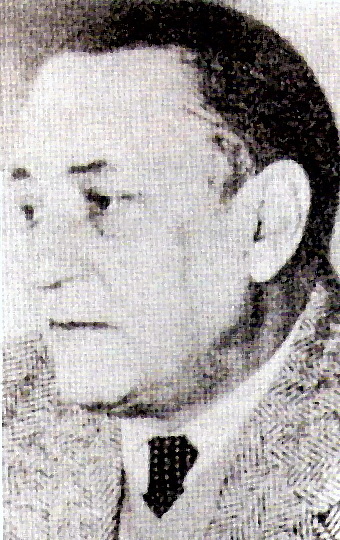 Alejo Carpentier Throughout the years, the Cuban nation has developed a wealth of musicological material created by numerous investigators and experts on this subject. The work of some authors who provided information about the music in Cuba during the 19th century was usually included in chronicles covering a more general subject. The first investigations and studies specifically dedicated to the musical art and practice did not appear in Cuba until the beginning of the 20th century.[80] A list of important personalities that have contributed to musicological studies in Cuba includes Fernando Ortiz, Eduardo Sánchez de Fuentes, Emilio Grenet, Alejo Carpentier, Argeliers León, Maria Teresa Linares, Pablo Hernández Balaguer, Alberto Muguercia and Zoila Lapique. A second generation of musicologists formed after de Cuban revolution of 1959 include: Zoila Gómez, Victoria Elí, Alberto Alén Pérez, Rolando Antonio Pérez Fernández and Leonardo Acosta. Most recently, a group of young Cuban musicologists have earned a well deserved reputation within the international academic field, due to their solid investigative work. Some of the most prominent members of this group are: Miriam Escudero Suástegui, Liliana González Moreno,[citation needed] Iván César Morales Flores[81] and Pablo Alejandro Suárez Marrero.[82] |
キューバの音楽学 主な記事 キューバの音楽学  アレホ・カルペンティエ キューバでは長年にわたり、音楽学に関する多くの研究者や専門家によって、豊富な音楽学的資料が作成されてきた。19世紀にキューバの音楽に関する情報を 提供した何人かの著者の仕事は、通常、より一般的なテーマを扱った年代記の中に含まれていた。音楽芸術と実践に特化した最初の調査や研究は、20世紀初頭 までキューバに現れなかった[80]。 キューバの音楽学研究に貢献した重要な人物のリストには、フェルナンド・オルティス、エドゥアルド・サンチェス・デ・フエンテス、エミリオ・グレネ、アレ ホ・カルペンティエ、アルゲリエス・レオン、マリア・テレサ・リナレス、パブロ・エルナンデス・バラゲール、アルベルト・ムゲルシア、ゾイラ・ラピケなど がいる。 1959年のキューバ革命後に結成された第二世代の音楽学者には、次のような人々がいる: ゾイラ・ゴメス、ビクトリア・エリ、アルベルト・アレン・ペレス、ロランド・アントニオ・ペレス・フェルナンデス、レオナルド・アコスタなどである。 最近では、キューバの若手音楽学者のグループが、その堅実な調査活動により、国際的な学術分野で正当な評価を得ている。このグループの最も著名なメンバー は以下の通りである: ミリアム・エスクデロ・スアステギ、リリアナ・ゴンサレス・モレノ、イバン・セサル・モラレス・フローレス[81]、パブロ・アレハンドロ・スアレス・マ レーロ[82]である。 |
| Popular music Hispanic heritage The first popular music played in Cuba after the Spanish conquest was brought by the Spanish conquerors themselves, and was most likely borrowed from the Spanish popular music in vogue during the 16th century. From the 16th to the 18th century some danceable songs that emerged in Spain were associated with Hispanic America, or considered to have originated in America. Some of these songs with picturesque names such as Sarabande, Chaconne, Zambapalo, Retambico and Gurumbé, among others,[83] shared a common trait, its characteristic rhythm called Hemiola or Sesquiáltera (in Spain). 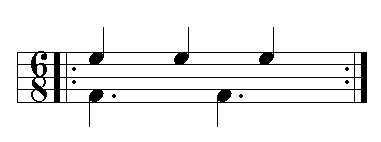 Vertical hemiola. Playⓘ This rhythm has been described as the alternation or superposition of a duple meter and a triple meter (6/8 + 3/4), and its utilization was widespread in the Spanish territory since at least the 13th century, where it appears in one of the Cantigas de Santa María (Como poden per sas culpas).[84] Hemiola or Sesquiáltera is also a typical rhythm within the African musical traditions, both from the North of the Continent as from the South.[85] Therefore, it is quite probable that the original song-dances brought by the Spanish to America already included elements from the African culture with which the enslaved Africans that arrived to the Island were familiar; and they further utilized them in order to create new creole genres.[86] The well known Son de la Ma Teodora, an ancient Cuban song, as well as the first Cuban autochthonous genres, Punto and Zapateo, show the Sesquiáltera rhythm on their accompaniment, which greatly associate those genres to the Spanish song-dances from the 16th to the 18th centuries.[87] |
ポピュラー音楽 ヒスパニックの遺産 スペインによる征服後、キューバで最初に演奏されたポピュラー音楽は、スペイン人征服者たち自身によってもたらされたもので、16世紀に流行したスペイン のポピュラー音楽を借用した可能性が高い。16世紀から18世紀にかけて、スペインで生まれたダンサブルな曲の中には、ヒスパニック・アメリカにちなんだ ものや、アメリカ発祥と思われるものもあった。サラバンド、シャコンヌ、ザンバパロ、レタンビコ、グルンベなど、絵に描いたような名前のこれらの曲のいく つか[83]には、ヘミオラまたはセスキアルテラ(スペイン語)と呼ばれる特徴的なリズムという共通の特徴があった。  縦のヘミオラ プレイⓘ。 このリズムは二重拍子と三重拍子(6/8+3/4)の交互または重ね合わせとして説明され、その利用は少なくとも13世紀以降スペイン領内で広まり、サンタ・マリアのカンティーガのひとつ(Como poden per sas culpas)に登場する[84]。 ヘミオラまたはセスキアルテラもまた、アフリカ大陸の北部と南部の両方のアフリカ音楽の伝統における典型的なリズムである[85]。したがって、スペイン 人がアメリカに持ち込んだオリジナルの歌舞曲には、島に到着した奴隷にされたアフリカ人が慣れ親しんでいたアフリカ文化の要素がすでに含まれていた可能性 が高く、彼らは新しいクレオールのジャンルを作り出すためにそれらをさらに利用した[86]。 よく知られているキューバ古来の歌であるソン・デ・ラ・マ・テオドラや、キューバ初の自国語ジャンルであるプントやサパテオには、伴奏にセスキアルテラの リズムが使われており、これらのジャンルは16世紀から18世紀にかけてのスペインの歌舞曲に大きく関連している[87]。 |
Música campesina (peasant music)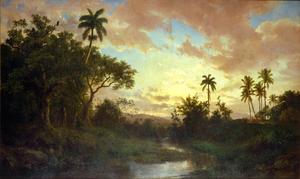 Cuban rural landscape It seems that Punto and Zapateo Cubano were the first autochthonous musical genres of the Cuban nation. Although the first printed sample of a Cuban Creole Zapateo (Zapateo Criollo) was not published until 1855 in the "Álbum Regio of Vicente Díaz de Comas",[88] it is possible to find references about the existence of those genres since long time before.[89] Its structural characteristics have survived almost unaltered through a period of more than two hundred years and they are usually considered the most typically Hispanic Cuban popular music genres. Cuban musicologists María Teresa Linares, Argeliers León and Rolando Antonio Pérez coincide in thinking that Punto and Zapateo are based on Spanish dance –songs (such as chacone and sarabande) that arrived first at the most important population centers such as Havana and Santiago de Cuba and then spread throughout the surrounding rural areas where they were adopted and modified by the peasant (campesino) population at a later time.[88] Punto guajiro Punto guajiro or Punto Cubano, or simply Punto is a sung genre of Cuban music, an improvised poetic-music art that emerged in the western and central regions of Cuba during the 19th century.[90] Although Punto appears to come from an Andalusian origin, it is a true Cuban genre because of its creole modifications.[91] Punto is played by a group with various types of plucked string instruments: the tiple (a treble guitar currently in disuse), the Spanish guitar, the Cuban tres, and the laúd. The word punto refers to the use of a plucked technique (punteado), rather than strumming (rasgueado). Also some percussion instruments have been utilized such as the clave, the güiro and the guayo ( a metallic scraper). Singers gather themselves in contending teams, and improvise their lines. They sing fixed melodies called "tonadas" which are based on a meter of ten strophe verses called "décimas", with intervals between stanzas to give the singers some time to prepare the next verse.[92] Early compositions were sometimes recorded and published, as were the names of some of the singers and composers. Beginning around 1935, Punto reached a peak of popularity on Cuban radio. Punto was one of the first Cuban genres recorded by American companies at the beginning of the 20th century, but at a later time the interest decayed and little effort was made to continue recording the live radio performances. A fan of this genre, stenographer Aida Bode, wrote down many verses as they were broadcast and finally, in 1997, her transcriptions were published in book form.[93] Celina González and Albita Rodríguez both sang Punto at the beginning of their careers, proving that the genre is still alive. Celina had one of the greatest voices in popular music, and her supporting group Campo Alegre was outstanding. For aficionados, however, Indio Naborí (Sabio Jesús Orta Ruiz, b. 30 September 1922) is the greatest name in Punto for his "decima" poetry, which he wrote daily for the radio and newspapers. He is also a published author with several collections of his poetry, much of which has a political nueva trova edge.[94] Zapateo Main article: Zapateo 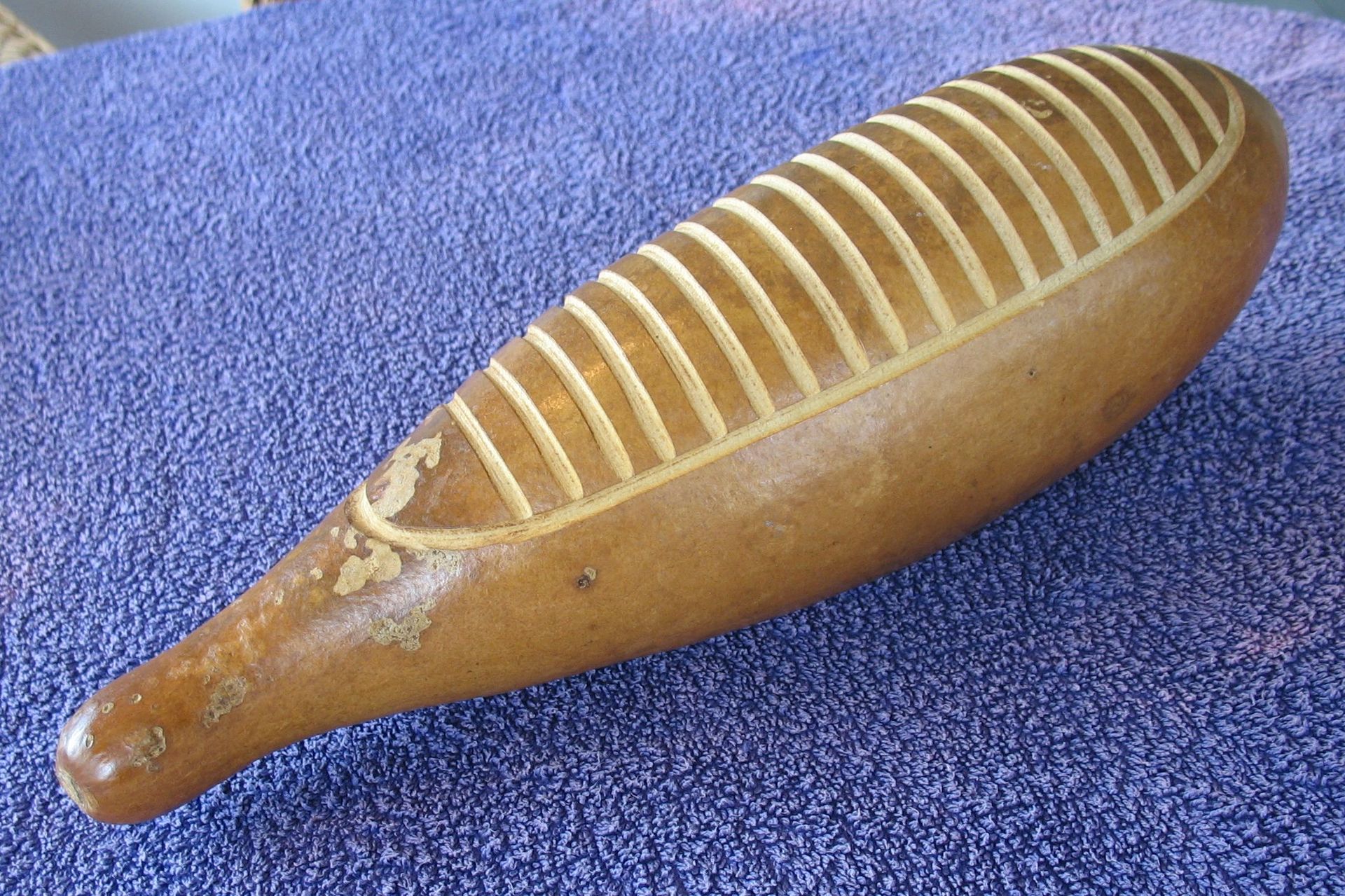 Cuban güiro Zapateo is a typical dance of the Cuban "campesino" or "guajiro," of Spanish origin. It is a dance of pairs, involving tapping of the feet, mostly performed by the male partner. Illustrations exist from previous centuries and today it survives cultivated by Folk Music Groups as a fossil genre. It was accompanied by tiple, guitar and güiro, in combined 6/8 and 3/4 rhythm (hemiola), accented on the first of every three quavers. Guajira Main article: Guajira (music) A genre of Cuban song similar to the Punto cubano and the Criolla.[95] It contains bucolic countryside lyrics, similar to décima poetry. Its music shows a mixture of 6/8 and 3/4 rhythms called Hemiola. According to Sánchez de Fuentes, its first section is usually presented in a minor key, and its second section in its direct major relative key.[96] The term Guajira is now used mostly to describe a slow dance music in 4/4 time, a fusion of the Guajira and the Son (called Guajira-Son). Singer and guitarist Guillermo Portabales was the most outstanding representative of this genre. Criolla Main article: Criolla Criolla is a genre of Cuban music which is closely related to the music of the Cuban Coros de Clave and a genre of Cuban popular music called Clave. The Clave became a very popular genre in the Cuban vernacular theater and was created by composer Jorge Anckermann based on the style of the Coros de Clave.[97] The Clave served, in turn, as a model for the creation of a new genre called Criolla. According to musicologist Helio Orovio, "Carmela", the first Criolla, was composed by Luis Casas Romero in 1909, which also created one of the most famous Criollas of all time, "El Mambí".[98] |
カンペシーナ音楽(農民音楽) キューバの田園風景 プントとサパテオ・クバーノは、キューバ民族の最初の自国音楽ジャンルだったようだ。キューバ・クレオールのサパテオ(サパテオ・クリオーリョ)の最初の 印刷サンプルは、1855年の 「Álbum Regio of Vicente Díaz de Comas 」に掲載されるまで出版されなかったが[88]、これらのジャンルの存在に関する文献を見つけることは可能である。キューバの音楽学者であるマリア・テレ サ・リナレス、アルゲリエス・レオン、ロランド・アントニオ・ペレスの見解は一致しており、プントとサパテオは、ハバナやサンティアゴ・デ・クーバといっ た最も重要な人口の中心地に最初に到着したスペインのダンス・ソング(チャコーンやサラバンドなど)を基にしており、その後、周辺の農村地域全体に広ま り、後に農民(カンペシーノ)によって取り入れられ、修正されたものであるとしている[88]。 プント・グアヒーロ プント・グアヒーロ(Punto guajiro)またはプント・クバーノ(Punto Cubano)、あるいは単にプント(Punto)は、キューバ音楽の歌唱ジャンルであり、19世紀にキューバの西部および中部地方で生まれた即興の詩的音楽芸術である[90]。 プントは、ティプル(現在では使われなくなった高音ギター)、スパニッシュ・ギター、キューバ・トレス、ラウードといった様々な種類の撥弦楽器を持ったグ ループによって演奏される。プントという言葉は、打ち込み(ラスゲアード)ではなく、撥弦楽器(プンテアード)の奏法を指す。また、クラーベ、グイロ、グ アヨ(金属製スクレーパー)などの打楽器も使われる。歌い手たちはチーム対抗で集まり、即興で歌う。 トナーダ」と呼ばれる決まったメロディーを歌うが、これは「デシマス」と呼ばれる10節からなる拍子に基づくもので、節と節の間には次の節を準備する時間を与えるためのインターバルがある[92]。1935年頃から、プントはキューバのラジオで人気のピークに達した。 プントは、20世紀初頭にアメリカの会社によって録音された最初のキューバジャンルのひとつであったが、その後、関心は薄れ、ラジオの生演奏を録音し続け る努力はほとんどなされなかった。このジャンルのファンであった速記者のアイーダ・ボデは、放送されるたびに多くの詩を書き留め、1997年、ついに彼女 の書き起こしが本の形で出版された[93]。 セリーナ・ゴンサレスとアルビータ・ロドリゲスは、キャリアの初期にプントを歌い、このジャンルがまだ生きていることを証明した。セリーナはポピュラー音 楽界で最も素晴らしい声の持ち主で、彼女のサポート・グループであるカンポ・アレグレは傑出していた。しかし、愛好家にとっては、インディオ・ナボリ(サ ビオ・ヘスス・オルタ・ルイス、1922年9月30日生まれ)は、ラジオや新聞に毎日書いた「デシマ」の詩で、プントで最も偉大な名前である。彼はまた、 いくつかの詩集を出版している作家でもあり、その多くは政治的なヌエバ・トロヴァのエッジを持っている[94]。 サパテオ 主な記事 サパテオ  キューバのグイロ サパテオはキューバの「カンペシーノ」または「グアヒーロ」の典型的なダンスで、スペインに起源を持つ。2人1組で踊るもので、足をたたくのが特徴で、主 に男性のパートナーが踊る。何世紀も前の挿絵が残っており、今日でも化石的なジャンルとして民族音楽グループによって育てられている。ティプル、ギター、 グイロの伴奏で、6/8と3/4の複合リズム(ヘミオラ)で、3つのクォーバーのうち最初のクォーバーにアクセントがある。 グアヒーラ 主な記事 グアヒーラ(音楽) プント・クバーノ(Punto cubano)やクリオージャ(Criolla)に似たキューバの歌のジャンル[95]。ヘミオラと呼ばれる8分の6拍子と4分の3拍子のリズムが混ざっ た音楽である。サンチェス・デ・フエンテスによると、その第1部は通常短調で、第2部は直接長調の相対調で演奏される[96]。グアヒーラという用語は、 現在では主に、グアヒーラとソン(グアヒーラ・ソンと呼ばれる)の融合である4/4拍子のスロー・ダンス・ミュージックを表すのに使われる。歌手でギタリ ストのギジェルモ・ポルタバレスは、このジャンルの最も傑出した代表者である。 クリオージャ 主な記事 クリオージャ クリオージャはキューバ音楽のジャンルのひとつで、キューバのコーロス・デ・クラーヴェの音楽や、クラーヴェと呼ばれるキューバのポピュラー音楽のジャンルと密接な関係がある。 クラーベはキューバの地方演劇で非常に人気のあるジャンルとなり、作曲家のホルヘ・アンカーマンによってコーロス・デ・クラーベのスタイルに基づいて創作 された[97]。音楽学者のヘリオ・オロビオによれば、最初のクリオージャである「カルメラ」はルイス・カサス・ロメロによって1909年に作曲され、ク リオージャの中で最も有名な曲のひとつである「エル・マンビ」もこの曲によって生み出された[98]。 |
| African heritage Main article: Music of African Heritage in Cuba Origins of Cuban African groups Clearly, the origin of African groups in Cuba is due to the island's long history of slavery. Compared to the US, slavery started in Cuba much earlier and continued for decades afterwards. Cuba was the last country in the Americas to abolish the importation of slaves, and the second last to free the slaves. In 1807 the British Parliament outlawed slavery, and from then on the British Navy acted to intercept Portuguese and Spanish slave ships. By 1860 the trade with Cuba was almost extinguished; the last slave ship to Cuba was in 1873. The abolition of slavery was announced by the Spanish Crown in 1880, and put into effect in 1886. Two years later, Brazil abolished slavery.[99] Subsequent organization The roots of most Afro-Cuban musical forms lie in the cabildos, self-organized social clubs for the African slaves, separate cabildos for separate cultures. The cabildos were formed mainly from four groups: the Yoruba (the Lucumi in Cuba); the Congolese (Palo in Cuba); Dahomey (the Fon or Arará). Other cultures were undoubtedly present, more even than listed above, but in smaller numbers, and they did not leave such a distinctive presence. Cabildos preserved African cultural traditions, even after the abolition of slavery in 1886. At the same time, African religions were transmitted from generation to generation throughout Cuba, Haiti, other islands and Brazil. These religions, which had a similar but not identical structure, were known as Lucumi or Regla de Ocha if they derived from the Yoruba, Palo from Central Africa, Vodú from Haiti, and so on. The term Santería was first introduced to account for the way African spirits were joined to Catholic saints, especially by people who were both baptized and initiated, and so were genuinely members of both groups. Outsiders picked up the word and have tended to use it somewhat indiscriminately. It has become a kind of catch-all word, rather like salsa in music.[13]p171; p258 African sacred music in Cuba This section needs additional citations for verification. Please help improve this article by adding citations to reliable sources in this section. Unsourced material may be challenged and removed. (October 2018) (Learn how and when to remove this message) All these African cultures had musical traditions, which survive erratically to the present day, not always in detail, but in general style. The best preserved are the African polytheistic religions, where, in Cuba at least, the instruments, the language, the chants, the dances and their interpretations are quite well preserved. In what other American countries are the religious ceremonies conducted in the old language(s) of Africa? They certainly are in Lucumí ceremonies, though of course, back in Africa the language has moved on. What unifies all genuine forms of African music is the unity of polyrhythmic percussion, voice (call-and-response) and dance in well-defined social settings, and the absence of melodic instruments of an Arabic or European kind. Yoruba and Congolese rituals Main articles: Yoruba people, Lucumi religion, Kongo people, Palo (religion), and Batá Religious traditions of African origin have survived in Cuba, and are the basis of ritual music, song and dance quite distinct from the secular music and dance. The religion of Yoruban origin is known as Lucumí or Regla de Ocha; the religion of Congolese origin is known as Palo, as in palos del monte.[100] There are also, in the Oriente region, forms of Haitian ritual together with its own instruments, music etc. Clave Main article: clave (rhythm) 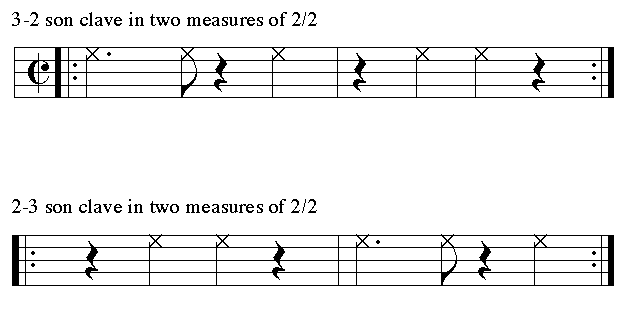 3-2 clave (Playⓘ) and 2-3 clave (Playⓘ) written in cut-time The clave rhythmic pattern is used as a tool for temporal organization in Afro-Cuban music, such as rumba, conga de comparsa, son, mambo (music), salsa, Latin jazz, songo and timba. The five-stroke clave pattern (distributed in groups of 3 + 2 or 2 + 3 beats) represents the structural core of many Afro-Cuban rhythms.[101] Just as a keystone holds an arch in place, the clave pattern holds the rhythm together in Afro-Cuban music.[102] The clave pattern originated in sub-Saharan African music traditions, where it serves essentially the same function as it does in Cuba. The pattern is also found in the African diaspora musics of Haitian Vodou drumming and Afro-Brazilian music. The clave pattern is used in North American popular music as a rhythmic motif or ostinato, or simply a form of rhythmic decoration. Cuban Carnival Main article: Cuban Carnival In Cuba, the word comparsa refers to the "Cabildos de Nación" neighbourhood groups that took part in the carnival authorized by the Spanish government on the Three Kings Day (Día de Reyes) during the colonial period. Conga is of African origin, and derives from street celebrations of the African spirits. The distinction is blurred today, but in the past the congas have been prohibited from time to time. Carnival as a whole was banned by the revolutionary government for many years, and still does not take place with the regularity of old. Conga drums are played (along with other typical instruments) in comparsas of all kinds. Santiago de Cuba and Havana were the two main centers for street carnivals. Two types of dance music (at least) owe their origin to comparsa music: Conga: an adaptation of comparsa music and dance for social dances. Eliseo Grenet may be the person who first created this music,[13]p408 but it was the Lecuona Cuban Boys who took it around the world. The conga became, and perhaps still is, the best-known Cuban music and dance style for non-latins. Mozambique is a comparsa-type dance music developed by Pello el Afrokan (Pedro Izquierdo) in 1963. It had a brief period of high popularity, peaked in 1965, and was soon forgotten. Apparently, to make it work properly, it needed 16 drums plus other percussion and dancers.[103] Tumba francesa This section needs additional citations for verification. Please help improve this article by adding citations to reliable sources in this section. Unsourced material may be challenged and removed. (October 2018) (Learn how and when to remove this message) Main article: Tumba francesa Immigrants from Haiti settled in Oriente and established their style of music, called Tumba Francesa, which uses its own type of drum, dance and song. It embodies one of the oldest and most tangible links to the Afro-Haitian heritage of Cuba's Oriente province and developed from an 18th-century fusion of music from Dahomey in West Africa and traditional French dances. This fossil genre survives to the present day in Santiago de Cuba and Haiti, performed by specialized folk ensembles. |
アフリカの遺産 主な記事 キューバのアフリカ系音楽 キューバのアフリカ系グループの起源 キューバにおけるアフリカ系グループの起源は、明らかにこの島の長い奴隷制度の歴史に起因している。アメリカと比べると、キューバで奴隷制度が始まったの はずっと早く、その後何十年も続いた。キューバはアメリカ大陸で奴隷の輸入を廃止した最後の国であり、奴隷を解放した2番目の国でもある。1807年、英 国議会は奴隷制度を違法とし、それ以降、英国海軍はポルトガルやスペインの奴隷船を阻止するために行動した。1860年までにキューバとの貿易はほぼ消滅 し、キューバへの最後の奴隷船は1873年に就航した。1880年にスペイン王室が奴隷制度の廃止を発表し、1886年に施行された。その2年後、ブラジ ルも奴隷制度を廃止した[99]。 その後の組織 ほとんどのアフロ・キューバン・ミュージックのルーツは、アフリカ人奴隷のための自主的な社交クラブであるカビルドにある。カビルドは主に、ヨルバ人 (キューバのルクミ)、コンゴ人(キューバのパロ)、ダホメイ人(フォンまたはアララ)の4つのグループから形成された。他の文化も存在したことは間違い なく、上記以外にも存在したが、その数は少なく、それほど際立った存在感を残すことはなかった。 1886年に奴隷制度が廃止された後も、カビルド人はアフリカ文化の伝統を守ってきた。同時に、アフリカの宗教はキューバ、ハイチ、他の島々、ブラジルの 至る所で世代から世代へと伝えられていった。これらの宗教は、ヨルバに由来するものはルクミやレグラ・デ・オチャ、中央アフリカに由来するものはパロ、ハ イチに由来するものはヴォドゥなどと呼ばれていた。サンテリアという言葉は、アフリカの精霊がカトリックの聖人と結びついたことを説明するために使われ始 めた。部外者がこの言葉を拾い上げ、やや無差別に使う傾向がある。この言葉は、音楽におけるサルサのような、一種のキャッチオール・ワードとなった [13]p171; p258 キューバにおけるアフリカの聖なる音楽 このセクションでは、検証のために追加の引用が必要である。このセクションに信頼できる情報源への引用を追加することで、この記事の改善にご協力いただき たい。ソースのないものは異議申し立てされ、削除される可能性がある。(2018年10月)(このメッセージを削除する方法とタイミングを学ぶ) これらのアフリカ文化にはすべて音楽の伝統があり、それは現代まで不規則に残っている。最もよく保存されているのはアフリカの多神教で、少なくともキュー バでは、楽器、言語、聖歌、踊り、そしてそれらの解釈がかなりよく保存されている。アフリカの古い言語で宗教儀式が行われている国が、他にあるだろうか? ルクミの儀式では確かにそうだが、もちろんアフリカに戻れば言葉は移り変わっている。アフリカ音楽のすべての本物の形式を統一しているのは、ポリリズムの パーカッション、声(コール・アンド・レスポンス)、明確な社会的設定でのダンスが一体となっていること、そしてアラビアやヨーロッパのようなメロディ楽 器がないことである。 ヨルバとコンゴの儀式 主な記事 ヨルバ人、ルクミ宗教、コンゴ人、パロ(宗教)、バタ アフリカ起源の宗教的伝統はキューバにも残っており、世俗の音楽や踊りとはまったく異なる儀式用の音楽、歌、踊りの基礎となっている。ヨルバ起源の宗教は ルクミまたはレグラ・デ・オチャとして知られ、コンゴ起源の宗教はパロ・デル・モンテのようにパロとして知られている[100]。また、オリエンテ地方に はハイチ儀礼の形式が独自の楽器や音楽などとともに残っている。 クラーヴェ 主な記事:クラーヴェ(リズム)  カットタイムで書かれた3-2クラーヴェ(プレイⓘ)と2-3クラーヴェ(プレイⓘ)。 クラーベのリズムパターンは、ルンバ、コンガ・デ・コンパルサ、ソン、マンボ(音楽)、サルサ、ラテン・ジャズ、ソンゴ、ティンバなどのアフロ・キューバ ン・ミュージックにおいて、時間編成のツールとして用いられる。5打のクラーベ・パターン(3+2または2+3拍のグループに分配される)は、多くのアフ ロ・キューバン・リズムの構造的な核を表している[101]。ちょうど要石がアーチを支えるように、クラーベ・パターンはアフロ・キューバン・ミュージッ クにおいてリズムを支えている[102]。クラーベ・パターンはサハラ以南のアフリカ音楽の伝統に起源を持ち、そこではキューバと基本的に同じ機能を果た している。このパターンは、ハイチのヴォドゥー・ドラムやアフロ・ブラジル音楽などのアフリカン・ディアスポラ音楽にも見られる。クラーベ・パターンは、 北米のポピュラー音楽では、リズムのモチーフやオスティナートとして、あるいは単にリズムの装飾の一形態として使われている。 キューバのカーニバル 主な記事 キューバのカーニバル キューバでは、コンパーサ(comparsa)という言葉は、植民地時代に3人の王の日(Día de Reyes)にスペイン政府によって公認されたカーニバルに参加した「Cabildos de Nación(カビルドス・デ・ナシオン)」という隣人グループを指す。コンガはアフリカに起源を持ち、アフリカの精霊のストリート・セレブレーションに 由来する。現在ではその区別は曖昧だが、過去にはコンガが禁止されたこともあった。カーニバル全体は、革命政府によって長年禁止されており、今でも昔のよ うに定期的に開催されることはない。コンガ・ドラムは、あらゆる種類のコンパーサで(他の代表的な楽器とともに)演奏される。サンティアゴ・デ・クーバと ハバナは、ストリート・カーニバルの2大中心地だった。少なくとも)2種類のダンス音楽は、コンパルサ音楽を起源としている: コンガ:コンパルサの音楽とダンスを社交ダンス用にアレンジしたもの。エリセオ・グレネがこの音楽を最初に創作した人物かもしれないが[13]、それを世 界中に広めたのはレクオーナ・キューバン・ボーイズだった。コンガは、ラテン系以外の人々にとって、キューバで最もよく知られた音楽であり、ダンス・スタ イルである。 モザンビークは、ペロ・エル・アフロカン(ペドロ・イズキエルド)が1963年に開発したコンパーサ・タイプのダンス音楽である。一時期、高い人気を博し たが、1965年にピークを迎え、すぐに忘れ去られた。正しく機能させるためには、16台のドラムと他のパーカッション、ダンサーが必要だったようだ [103]。 トゥンバ・フランセーサ このセクションは検証のために追加の引用が必要である。このセクションに信頼できる情報源への引用を追加することで、この記事の改善にご協力いただきた い。ソースのないものは異議申し立てされ、削除されることがある。(2018年10月)(このメッセージを削除する方法とタイミングを学ぶ) 主な記事 トゥンバ・フランセーサ ハイチからの移民がオリエンテに定住し、独自のドラム、ダンス、歌を用いるトゥンバ・フランセーサと呼ばれる音楽スタイルを確立した。これは、キューバ・ オリエンテ州のアフロ・ハイチの遺産との最も古く、最も具体的なつながりのひとつであり、18世紀に西アフリカのダホメイの音楽とフランスの伝統舞踊が融 合して発展したものである。この化石のようなジャンルは、現在もサンティアゴ・デ・クーバとハイチで存続しており、専門の民族アンサンブルによって演奏さ れている。 |
| Contradanza Main article: Contradanza The Contradanza is an important precursor of several later popular dances. It arrived in Cuba in the late 18th century from Europe where it had been developed first as the English country dance, and then as the French contradanse. The origin of the word is a corruption of the English term "country dance".[104] Manuel Saumell wrote over fifty contradanzas (in 2/4 or 6/8 time), in which his rhythmic and melodic inventiveness was astonishing. The Contradanza is a communal sequence dance, with the dance figures conforming to a set pattern. The selection of figures for a particular dance was usually set by a master of ceremonies or dance leader. There were two parts of 16 bars each, danced in a line or square format. The tempo and style of the music was bright and fairly fast. The earliest Cuban creole composition of a Contradanza appeared published in Havana in 1803 and was named San Pascual bailón. This version shows for the first time the well known rhythm of "Tango" or "Habanera" which differentiates it from the European contradance. The Cubans developed a number of creolized version, such as the "paseo", "cadena", "sostenido" and "cedazo". This creolization is an early example of the influence of the African traditions in the Caribbean. Most of the musicians were black or mulatto (even early in the 19th century there were many freed slaves and mixed race persons living in Cuban towns). "The women of Havana have a furious taste for dancing; they spend entire nights elevated, agitated, crazy and pouring sweat until they fall spent."[105]  Rhythm of Tango or Habanera. Playⓘ The contradanza supplanted the minuet as the most popular dance until from 1842 on, it gave way to the habanera, a quite different style.[106] |
コントラダンツァ(コントラダンサ) 主な記事 コントラダンツァ(コントラダンサ) コントラダンツァは、後のいくつかのポピュラーダンスの重要な先駆けである。18世紀後半にヨーロッパからキューバに伝わり、最初はイギリスのカントリー ダンスとして、その後フランスのコントラダンツァとして発展した。マヌエル・サウメルは50以上のコントラダンツァ(4分の2拍子または8分の6拍子)を 作曲しており、そのリズムと旋律の独創性には驚かされる。 コントラダンツァは共同体的なシークエンス・ダンスであり、踊りの図形は決められたパターンに従っている。特定の踊りのフィギュアの選択は、通常、儀式長 かダンス・リーダーが決めた。16小節ずつの2つのパートがあり、ラインまたはスクエア形式で踊られる。音楽のテンポとスタイルは明るく、かなり速かっ た。 最古のキューバ人クレオール作曲のコントラダンツァは、1803年にハバナで出版され、サン・パスクアル・ベイロンと名付けられた。このバージョンは、よ く知られた「タンゴ」や「ハバネラ」のリズムを初めて示しており、ヨーロッパのコントラダンスとは一線を画している。キューバ人は、「パセオ」、「カデ ナ」、「ソステニード」、「セダソ 」などのクレオール化されたバージョンを開発した。このクレオール化は、カリブ海におけるアフリカの伝統の影響を示す初期の例である。音楽家のほとんどは 黒人か混血であった(19世紀初頭にも、キューバの町には解放奴隷や混血の人々が多く住んでいた)。「ハバナの女性たちは踊りを猛烈に好み、夜通し高揚 し、興奮し、気が狂い、汗を流しながら、疲れ果てるまで過ごす」[105]。  タンゴやハバネラのリズム。Playⓘ コントラダンツァはメヌエットに取って代わり、1842年以降は全く異なるスタイルのハバネラへと移行した[106]。 |
| Danza This genere, the offspring of the contradanza, was also danced in lines or squares. It was also a brisk form of music and dance in double or triple time. A repeated 8-bar paseo was followed by two 16-bar sections called the primera and segunda. One famous composer of danzas was Ignacio Cervantes, whose forty-one danzas cubanas were a landmark in musical nationalism. This type of dance was eventually replaced by the danzón, which was, like the habanera, much slower and more sedate.[107] |
ダンツァ(ダンサ) コントラダンツァの子孫であるこのジェネレも、ラインやスクエアで踊られた。また、二重拍子や三重拍子の音楽と踊りで、小気味よい形式であった。8小節の パセオが繰り返された後、プリメーラとセグンダと呼ばれる2つの16小節のセクションが続く。有名な作曲家の一人にイグナシオ・セルバンテスがおり、彼の 41のダンス・クバーナスは音楽的ナショナリズムの画期的な作品となった。このタイプのダンスは、やがてハバネラ同様、よりゆっくりと落ち着いたダンソン に取って代わられた[107]。 |
| Habanera Main article: Habanera (music) The habanera developed out of the contradanza in the early 19th century. Its great novelty was that it was sung, as well as played and danced. Written in 2/4 meter, the Habanera is characterized by an expressive and languid melodious development and its characteristic rhythm called "Habanera Rhythm." The dance style of the habanera is slower and more stately than the danza. By the 1840s habaneras were written, sung, and danced in Mexico, Venezuela, Puerto Rico, and Spain.[108] Since about 1900 the habanera has been a relic dance; but the music has a period charm, and there are some famous compositions, such as Tú from Eduardo Sánchez de Fuentes, which has been recorded in many versions. Versions of habanera-type compositions have appeared in the music of Ravel, Bizet, Saint-Saëns, Debussy, Fauré, Albeniz. The rhythm is similar to that of the tango, and some believe the habanera is the musical father of the tango.[109] |
ハバネラ 主な記事 ハバネラ(音楽) ハバネラは19世紀初頭にコントラバンザから発展した。ハバネラの大きな特徴は、演奏したり踊ったりするだけでなく、歌も歌われることである。4分の2拍 子で書かれたハバネラは、表情豊かでゆったりとしたメロディアスな展開と、「ハバネラリズム 」と呼ばれる特徴的なリズムが特徴である。 ハバネラのダンススタイルは、ダンツァよりもゆっくりで、より荘厳である。1840年代までにハバネラはメキシコ、ベネズエラ、プエルトリコ、スペインで 作曲され、歌われ、踊られた[108]。1900年頃からハバネラは遺物のような踊りになったが、音楽には時代を感じさせる魅力があり、エドゥアルド・サ ンチェス・デ・フエンテスの「Tú」など有名な曲もあり、多くのバージョンが録音されている。 ラヴェル、ビゼー、サン=サーンス、ドビュッシー、フォーレ、アルベニスの音楽にも、ハバネラ系のバージョンがある。リズムはタンゴのリズムに似ており、ハバネラはタンゴの音楽的父であるという説もある[109]。 |
| Danzón Main articles: Danzón and Charanga (Cuba) 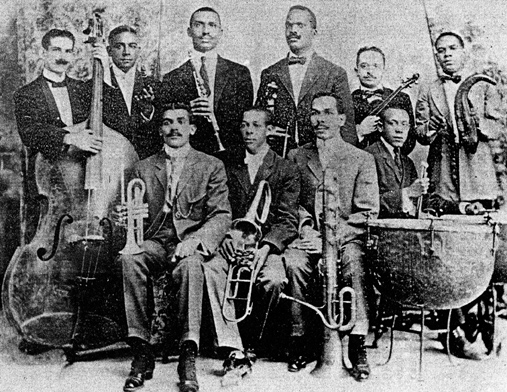 Orquesta Enrique Peña. Peña seated left, Barreto (violin) and Urfé (clarinet) The European influence on Cuba's later musical development is represented by danzón, an elegant musical form that was once more popular than the Son in Cuba. It is a descendant of the creolized Cuban contradanza. The danzón marks the change from the communal sequence dance style of the late 18th century to the couple dances of later times. The stimulus for this was the success of the once-scandalous walz, where couples danced facing each other, independently from other couples and not as part of a pre-set structure. The danzón was the first Cuban dance to adopt such methods, though there is a difference between the two dances. The walz is a progressive ballroom dance where couples move round the floor in an anti-clockwise direction; the danzón is a 'pocket-handkerchief' dance where a couple stays within a small area of the floor.[110] The danzón was developed by Miguel Faílde in Matanzas, the official date of origin being 1879.[111] Failde's was an orquesta típica, a form derived from military bands, using brass, kettle-drums etc. The later development of the charanga was more suited to the indoor salon and is an orchestral format still popular today in Cuba and some other countries. The charanga uses double bass, cello, violins, flute, piano, paila criolla and güiro. This change in instrumental set-up is illustrated in Early Cuban bands. 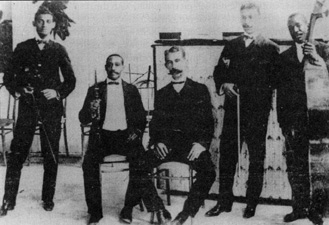 Charanga de Antonio (Papaíto) Torroella (1856–1934) From time to time in its 'career', the danzón acquired African influences in its musical structure. It became more syncopated, especially in its third part. The credit for this is given to José Urfé, who worked elements of the son into the last part of the danzón in his composition El bombin de Barreto (1910).[112] Both the danzón and the charanga line-up have been strongly influential in later developments. The danzón was exported to popular acclaim throughout Latin America, especially Mexico. It is now a relic, both in music and in dance, but its highly orchestrated descendants live on in charangas that Faílde and Urfé would likely not recognize. Juan Formell has had a huge influence through his reorganization of first Orquesta Revé, and later Los Van Van. |
ダンソン 主な記事 ダンソンとチャランガ(キューバ)  オルケスタ・エンリケ・ペーニャ。左がペーニャ、右がバレト(ヴァイオリン)、右がウルフェ(クラリネット)。 キューバのその後の音楽発展におけるヨーロッパの影響は、かつてキューバでソンよりも人気があったエレガントな音楽形式であるダンソンに代表される。これ は、クレオール化したキューバのコンディバンツァの子孫である。ダンソンは、18世紀後半の共同体的なシークエンス・ダンス・スタイルから、後の時代の カップル・ダンスへの変化を示している。そのきっかけとなったのは、かつてスキャンダラスだったワルツが成功したことである。ワルツでは、カップルは他の カップルとは無関係に、あらかじめ決められた構造の一部としてではなく、向かい合って踊る。ダンソンは、キューバで初めてこのような手法を取り入れたダン スだが、2つのダンスには違いがある。ワルツは、カップルが反時計回りにフロアを一周するプログレッシブな社交ダンスであり、ダンソンは、カップルがフロ アの狭い範囲にとどまる「ポケット・ハンカチーフ」ダンスである[110]。 ダンソンはミゲル・フェイルデがマタンサスで開発したもので、正式な起源は1879年である[111]。フェイルデのものはオルケスタ・ティピカで、金管 楽器やケトルドラムなどを使用した軍楽隊に由来する形式であった。後に発展したチャランガは、屋内サロンにより適しており、今日でもキューバや他のいくつ かの国で人気のあるオーケストラ形式である。チャランガでは、コントラバス、チェロ、ヴァイオリン、フルート、ピアノ、パイラ・クリオージャ、グイロが使 われる。このような楽器編成の変化は、初期のキューバ楽団に見られる。  アントニオ・トロエラ(1856-1934)のチャランガ その 「キャリア 」の中で、ダンソンはその音楽構造にアフリカの影響を受けた。特に第3部では、よりシンコペーションが強くなった。この功績は、ホセ・ウルフェ(José Urfé)がEl bombin de Barreto(1910)という曲の中で、ダンソンの最後の部分にシンコペーションの要素を取り入れたことによる。 ダンソンはラテンアメリカ、特にメキシコに輸出され、人気を博した。現在では、音楽においてもダンスにおいても遺物となったが、高度にオーケストレーショ ンされたその子孫は、フェイルデやウルフェがおそらく認めないであろうチャランガで生き続けている。フアン・フォルメルは、最初のオルケスタ・レヴェ、後 のロス・ヴァン・ヴァンの再編成を通じて大きな影響を与えた。 |
| Danzonete This section needs additional citations for verification. Please help improve this article by adding citations to reliable sources in this section. Unsourced material may be challenged and removed. (October 2018) (Learn how and when to remove this message) Early Danzons were purely instrumental. The first to introduce a vocal part in a Danzón was Aniceto Díaz (in 1927 in Matanzas), that was called Rompiendo la rutina, thereby creating a new genre called the Danzonete. Later, the black singer Barbarito Diez joined the charanga of Antonio María Romeu in 1935 and, over the years, recorded eleven albums of Danzonetes. All later forms of the Danzón have included vocals. |
ダンゾネテ このセクションの検証には追加の引用が必要である。このセクションに信 頼できる情報源への引用を追加することで、この記事の改善にご協力いただきたい。ソースのないものは異議申し立てされ、削除される可能性がある。 (2018年10月)(このメッセージを削除する方法とタイミングを学ぶ) 初期のダンツォンは純粋な器楽曲だった。ダンソンに初めてボーカルパートを導入したのはアニセト・ディアス(1927年マタンサス)で、 Rompiendo la rutinaと呼ばれ、ダンソネーテという新しいジャンルを生み出した。その後、黒人歌手バルバリート・ディエスが1935年にアントニオ・マリア・ロメ ウのチャランガに参加し、長年にわたって11枚のダンソネテのアルバムを録音した。その後のダンソンはすべてヴォーカル入りである。 |
| Guaracha Main article: Guaracha 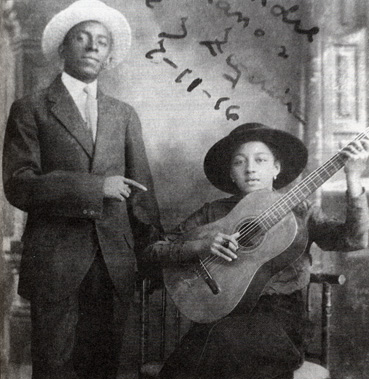 María Teresa Vera & Rafael Zequeira On January 20, 1801, Buenaventura Pascual Ferrer published a note in a newspaper called "El Regañón de La Habana", in which he refers to certain chants that "run outside there through vulgar voices". Between them he mentioned a "guaracha" named "La Guabina", about which he says: "in the voice of those that sings it, tastes like any thing dirty, indecent or disgusting that you can think about." At a later time, in an undetermined date, "La Guabina" appears published between the first musical scores printed in Havana at the beginning of the 19th century.[113] According to the commentaries published in "El Regañón de La Habana", it can be concluded that those "guarachas" were very popular within the Havana population at that time, because in the same previously mentioned article the author says: "but most importantly, what bothers me most is the liberty with which a number of chants are sung throughout the streets and town homes, where innocence is insulted and morals offended ... by many individuals, not just of the lowest class, but also by some people that are supposed to be called well educated." Therefore, it can be said that those "guarachas" of a very audacious content, were apparently already sung within a wide social sector of the Havana population.[113] According to Alejo Carpentier (quoting Buenaventura Pascual Ferrer), at the beginning of the 19th century there were held in Havana up to fifty dance parties every day, where the famous "guaracha" was sung and danced, among other popular pieces.[114] The guaracha is a genre of rapid tempo and comic or picaresque lyrics.[115] It originated at the end of the 18th century, and during the early 20th century was still often played in the brothels and other places in Havana.[116][117] The lyrics were full of slang, and dwelt on events and people in the news. Rhythmically, guaracha exhibits a series of rhythm combinations, such as 6/8 with 2/4.[118] Many of the early trovadores, such as Manuel Corona (who worked in a brothel area of Havana), composed and sang guarachas as a balance for the slower boleros and canciones. The satirical lyric content also fitted well with the son, and many bands played both genres. In the mid-20th century the style was taken up by the conjuntos and big bands as a type of up-tempo music. Today it seems no longer to exist as a distinct musical form; it has been absorbed into the vast maw of Salsa. Singers who can handle the fast lyrics and are good improvisors are called guaracheros or guaracheras. |
グアラチャ 主な記事 グアラチャ  マリア・テレサ・ベラとラファエル・ゼケイラ 1801年1月20日、ブエナベントゥーラ・パスクアル・フェレールは、「El Regañón de La Habana 」という新聞に、「下品な声で外を流れている 」ある聖歌について言及している。その中で彼は、「ラ・グアビーナ 」という名の 「グアラチャ 」について触れている。「それを歌う人の声には、あなたが考えつくどんな汚いもの、卑猥なもの、嫌なもののような味がする 」と彼は言う。その後、年代は定かではないが、「ラ・グアビーナ」は19世紀初頭にハバナで印刷された最初の楽譜の間に出版されている[113]。 El Regañón de La Habana 「に掲載された解説によれば、それらの 」guarachas "は当時のハバナの人々の間で非常に人気があったと結論づけることができる。したがって、非常に大胆な内容のこれらの「グアラチャ」は、ハバナの人々の幅 広い社会的部門ですでに歌われていたらしいと言える[113]。 アレホ・カルペンティエによれば(ブエナヴェントゥーラ・パスクアル・フェレールの引用)、19世紀初頭、ハバナでは毎日50ものダンスパーティが開かれており、そこでは他のポピュラーな楽曲に混じって有名な「グアラチャ」が歌われ踊られていた[114]。 グアラチャは速いテンポとコミカルまたはピカレスクな歌詞のジャンルであり[115]、18世紀末に生まれ、20世紀初頭にもハバナの売春宿などでしばし ば演奏された[116][117]。リズム的には、グアラチャは6/8と2/4のような一連のリズムの組み合わせを示す[118]。 マヌエル・コロナ(ハバナの売春宿街で働いていた)のような初期のトロヴァドールの多くは、ゆっくりとしたボレロスやカンシオネスとのバランスをとるため にグアラチャを作曲し歌っていた。風刺的な歌詞の内容も息子によく合い、多くのバンドが両方のジャンルを演奏した。20世紀半ばには、アップテンポの音楽 としてコンジュントやビッグバンドに取り入れられた。今日では、このスタイルはもはや明確な音楽形態としては存在せず、サルサという大口の中に吸収されて しまったようだ。速い歌詞に対応でき、即興演奏が得意な歌手は、グアラチェロスまたはグアラチェーラと呼ばれる。 |
| Musical theatre Main article: Cuban musical theatre 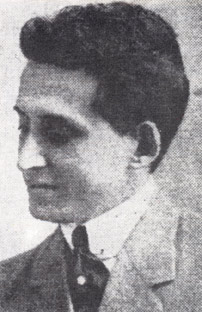 Adolfo Colombo From the 18th century (at least) to modern times, popular theatrical formats used, and gave rise to, music and dance. Many famous composers and musicians had their careers launched in the theatres, and many famous compositions got their first airing on the stage. In addition to staging some European operas and operettas, Cuban composers gradually developed ideas that better suited their audience. Recorded music was to be the couduit for Cuban music to reach the world. The most recorded artist in Cuba up to 1925 was a singer at the Alhambra, Adolfo Colombo. Records show he recorded about 350 numbers between 1906 and 1917.[119] The first theatre in Havana opened in 1776. The first Cuban-composed opera appeared in 1807. Theatrical music was hugely important in the 19th century[120] and the first half of the 20th century; its significance only began to wane with the change in political and social weather in the second part of the 20th century. Radio, which began in Cuba in 1922, helped the growth of popular music because it provided publicity and a new source of income for the artists. |
ミュージカル劇場 主な記事 キューバのミュージカル劇場  アドルフォ・コロンボ 少なくとも18世紀から現代に至るまで、大衆演劇の形式は音楽とダンスを用い、それを生み出した。多くの有名な作曲家や音楽家が劇場でキャリアをスタート させ、多くの有名な楽曲が舞台で初演された。キューバの作曲家たちは、ヨーロッパのオペラやオペレッタを上演するだけでなく、より観客に合うようなアイ ディアも徐々に開発していった。キューバの音楽が世界に広まるきっかけとなったのは、レコード音楽だった。1925年までキューバで最も録音されたアー ティストは、アルハンブラ宮殿の歌手アドルフォ・コロンボだった。記録によれば、彼は1906年から1917年の間に約350曲を録音している [119]。 ハバナで最初の劇場は1776年にオープンした。1807年にはキューバ初のオペラが上演された。劇場音楽は19世紀[120]から20世紀前半にかけて 非常に重要であったが、その重要性が薄れ始めたのは、20世紀後半の政治的・社会的風潮の変化によるものであった。1922年にキューバで始まったラジオ は、宣伝効果をもたらし、アーティストに新たな収入源を提供したため、ポピュラー音楽の成長に貢献した。 |
| Zarzuela This section needs additional citations for verification. Please help improve this article by adding citations to reliable sources in this section. Unsourced material may be challenged and removed. (October 2018) (Learn how and when to remove this message) Main article: Zarzuela Zarzuela is a small-scale light operetta format. Starting off with imported Spanish content (List of zarzuela composers), it developed into a running commentary on Cuba's social and political events and problems. Zarzuela has the distinction of providing Cuba's first recordings: the soprano Chalía Herrera (1864–1968) made, outside Cuba, the first recordings by a Cuban artist. She recorded numbers from the zarzuela Cádiz in 1898 on unnumbered Bettini cylinders.[121] 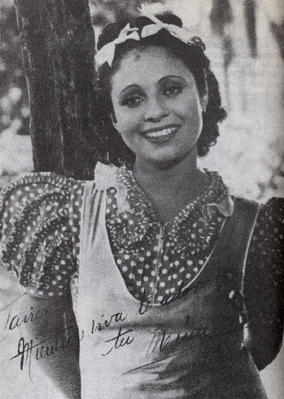 Rita Montaner in 1938 during shooting of El romance del palmar Zarzuela reached its peak in the first half of the 20th century. A string of front-rank composers such as Gonzalo Roig, Eliseo Grenet, Ernesto Lecuona and Rodrigo Prats produced a series of hits for the Regina and Martí theatres in Havana. Great stars like the vedette Rita Montaner, who could sing, play the piano, dance and act, were the Cuban equivalents of Mistinguett and Josephine Baker in Paris. Some of the best known zarzuelas are La virgen morena (Grenet), La Niña Rita (Grenet and Lecuona), María la O, El batey, Rosa la China (all Lecuona); Gonzalo Roig with La Habana de noche; Rodrigo Prats with Amalia Batista and La perla del caribe; and above all, Cecilia Valdés (the musical of the most famous Cuban novel of the 19th century, with music by Roig and script by Prats and Agustín Rodríguez). Artists who were introduced to the public in the lyric theatre include Caridad Suarez, María de los Angeles Santana, Esther Borja and Ignacio Villa, who had such a round, black face that Rita Montaner called him Bola de Nieve ('Snowball'). Another famous singer was Maruja González Linares. Born from Spanish parents in the Mexican locality of Mérida, Yucatán in 1904, González travelled from Cuba to the US at a very young age. She studied vocal techniques in Cuba, where she made her debut in 1929 as a lyrical singer in the Company of Maestro Ernesto Lecuona. González performed in several theaters of Havana before going on a tour through the United States and, upon her return to Havana, she sang La Bayadere and The Merry Widow in the same city. At the beginning of the 1930s, she signed a number of contracts in Latin America and in Spain. She married Perico Suarez. The Cuban Revolution caught her abroad and she never returned to her country. She died in Miami in 1999. |
サルスエラ このセクションの検証には追加の引用が必要である。このセクションに信 頼できる情報源への引用を追加することで、この記事の改善にご協力いただきたい。ソースのないものは異議申し立てされ、削除される可能性がある。 (2018年10月)(このメッセージを削除する方法とタイミングを学ぶ) 主な記事 サルスエラ サルスエラ(Zarzuela)は、小規模な軽いオペレッタ形式である。スペイン語から輸入された内容で始まり(サルスエラ作曲家リスト)、キューバの社 会的・政治的事件や問題を解説するものへと発展した。サルスエラには、キューバ初の録音という特徴がある。ソプラノ歌手のチャリア・エレーラ (1864~1968)は、キューバ人アーティストによる初の録音をキューバ国外で行った。彼女は1898年にベッティーニの番号なしのシリンダーにサル スエラ『カディス』のナンバーを録音した[121]。  1938年、『手のひらのロマンス』撮影中のリタ・モンタネール サルスエラは20世紀前半に最盛期を迎えた。ゴンサロ・ロイグ、エリセオ・グレネ、エルネスト・ルクオナ、ロドリゴ・プラッツといった第一線で活躍する作 曲家たちが、ハバナのレジーナ劇場やマルティ劇場でヒット曲を連発した。歌、ピアノ、ダンス、演技をこなすヴェデット、リタ・モンタネルのような偉大なス ターは、キューバではパリのミスティンゲットやジョセフィーヌ・ベイカーに相当した。有名なサルスエラには、La virgen morena(グレネ)、La Niña Rita(グレネとルクオナ)、Maria la O(マリア・ラ・オー)、El batey(エル・バティ)、Rosa la China(ロサ・ラ・チャイナ)(すべてルクオナ)、La Habana de noche(ラ・ハバナ・デ・ノーチェ)のGonzalo Roig(ゴンサロ・ロイグ)などがある; ロドリゴ・プラッツの『アマリア・バティスタ』と『ラ・ペルラ・デル・カリベ』、そしてなんといっても『セシリア・バルデス』(19世紀キューバで最も有 名な小説のミュージカルで、音楽はロイグ、脚本はプラッツとアグスティン・ロドリゲス)である。抒情歌劇場で大衆に紹介されたアーティストには、カリダッ ド・スアレス、マリア・デ・ロス・アンヘレス・サンタナ、エステル・ボルハ、イグナシオ・ビジャなどがいる。イグナシオ・ビジャは、リタ・モンタネールか ら「ボラ・デ・ニエベ(雪だるま)」と呼ばれるほど丸くて黒い顔をしていた。 もう一人の有名な歌手はマルハ・ゴンサレス・リナレスである。1904年、メキシコのユカタン州メリダでスペイン人の両親のもとに生まれたゴンサレスは、 若くしてキューバからアメリカに渡った。キューバで発声法を学び、1929年にマエストロ・エルネスト・レクオナのカンパニーでリリカル歌手としてデ ビューした。ゴンサレスはハバナのいくつかの劇場に出演した後、アメリカツアーに出かけ、ハバナに戻ると、同市で『ラ・バヤデール』と『メリー・ウィド ウ』を歌った。1930年代の初めには、ラテンアメリカとスペインで多くの契約を結んだ。ペリコ・スアレスと結婚した。キューバ革命に巻き込まれ、帰国す ることはなかった。1999年、マイアミで死去。 |
| Bufo theatre Cuban bufo theatre is a form of comedy, ribald and satirical, with stock figures imitating types that might be found anywhere in the country. Bufo had its origin around 1800-15 as an older form, tonadilla, began to vanish from Havana. Francisco Covarrubias the 'caricaturist' (1775–1850) was its creator. Gradually, the comic types threw off their European models and became more and more creolized and Cuban. Alongside, the music followed. Argot from slave barracks and poor barrios found its way into lyrics that are those of the guaracha: Una mulata me ha muerto! Y no prenden a esa mulata? Como ha de quedar hombre vivo si no prenden a quien mata! La mulata es como el pan; se debe comer caliente, que en dejandola enfriar ni el diablo le mete el diente![8]p218 (A mulata's done for me! What's more, they don't arrest her! How can any man live If they don't take this killer? A mulatta is like fresh bread You gotta eat it while it's hot If you leave it till it's cool Even the devil can't get a bite!) The "guaracha" occupied a predominant place within the development of vernacular theater in Cuba, which appearance at the beginning of the 19th century coincides with the emergence of the first autochthonous Cuban musical genres, the "guaracha" and the"contradanza.". Since 1812, Francisco Covarrubias (considered as the father of the Bufo Theater) gradually substituted in his theatrical pieces the typical characters of the Spanish "tonadilla escénica" with creole characters such as "guajiros", "monteros", "carreteros" or "peones". Those structural transformations were also associated to certain changes in the musical background of the pieces. Thus, the Spanish genres such as "jácaras", "tiranas", "boleras" or "villancicos", were substituted by "guarachas", "décimas" and "canciones cubanas."[114] |
ブフォ劇場 キューバのブフォ劇場は、滑稽で風刺的な喜劇の一形態である。ブフォの起源は1800~15年頃に遡り、古い形式であるトナディージャがハバナから消え始 めたことによる。諷刺画家」フランシスコ・コバルビアス(1775-1850)がその生みの親である。徐々に、コミックの種類はヨーロッパのモデルを捨 て、ますますクレオール化し、キューバ化していった。それと並行して、音楽も続いた。奴隷のバラックや貧しいバリオの言葉が、グアラチャの歌詞になった: Una mulata me ha muerto! そのムラタに何もしないのか? 生きている人間を殺すのはどうだ? そのムラタに何もしないのか? ムラタはフライパンのようなものだ; 熱々を食べなければならない、 灼熱の料理を食べなければならない。 ディアブロが啖呵を切ることもない![8]p218 (ムラタは私のためにやってくれた! しかも、彼らは彼女を逮捕しない! この殺人鬼を逮捕しないなら この殺人鬼を捕まえないなら、どんな男でも生きていけるだろう? ムラタは焼きたてのパンのようなものだ 熱いうちに食うんだ 冷めるまで放っておけば 悪魔でさえ一口も食べられない!) グアラチャ」は、キューバにおける地方演劇の発展の中で重要な位置を占めており、19世紀初頭の登場は、「グアラチャ」と「コントラプランサ」という キューバ初の自国音楽ジャンルの出現と重なる。1812年以降、フランシスコ・コバルビアス(ブフォ劇場の生みの親とされる)は、スペイン語の 「トナディージャ・エスケニカ 」の典型的な登場人物を、「グアジロス」、「モンテロス」、「カレテロス」、「ピオーネ 」といったクレオール語の登場人物に徐々に置き換えていった。このような構造の変化は、楽曲の音楽的背景の変化とも関連している。こうして、「ジャカラ ス」、「ティラナス」、「ボレラス」、「ヴィリャンシーコ」といったスペイン語のジャンルは、「グアラチャス」、「デシマス」、「カンシオネス・クバーナス」 に取って代わられた[114]。 |
| Other theatrical forms This section needs additional citations for verification. Please help improve this article by adding citations to reliable sources in this section. Unsourced material may be challenged and removed. (October 2018) (Learn how and when to remove this message) Vernacular theatre of various types often includes music. Formats rather like the British Music Hall, or the American Vaudeville, still occur, where an audience is treated to a potpourri of singers, comedians, bands, sketches and speciality acts. Even in cinemas during the silent movies, singers and instrumentalists appeared in the interval, and a pianist played during the films. Bola de Nieve and María Teresa Vera played in cinemas in their early days. Burlesque was also common in Havana before 1960. |
その他の演劇形態 このセクションでは、検証のために追加の引用が必要である。このセク ションに信頼できる情報源への引用を追加することで、この記事の改善にご協力いただきたい。ソースのないものは異議申し立てされ、削除される可能性があ る。(2018年10月)(このメッセージを削除する方法とタイミングを学ぶ) 様々なタイプのヴァナキュラー演劇には、しばしば音楽が含まれる。イギリスのミュージック・ホールやアメリカのヴォードヴィルのような形式は今でもあり、 観客は歌手、コメディアン、バンド、寸劇、特殊演技の寄せ集めでもてなされる。無声映画時代の映画館でも、幕間に歌手や器楽奏者が登場し、ピアニストが映 画中に演奏した。ボラ・デ・ニエベやマリア・テレサ・ベラは、その昔、映画館で演奏していた。1960年以前のハバナでは、バーレスクも一般的だった。 |
The Black Curros (Negros Curros)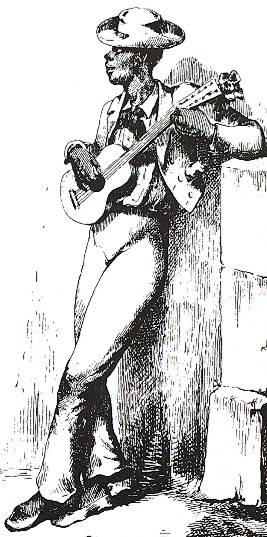 Negro Curro Juan Cocuyo In reference to the emergence of the Guaracha and, at a later time, also of the Urban Rumba in Havana and Matanzas, it is important to mention an important and picturesque social sector called Black Curros (Negros Curros). Composed of free blacks that had arrived from Seville on an undetermined date, this group was integrated to the population of free blacks and mulattos that lived in the marginal zones of the city of Havana.[122] José Victoriano Betancourt a Cuban "costumbrista" writer from the 19th century described them as follows: "they [the curros] had a peculiar aspect, and was enough to look at them to recognize them as curros: their long hunks of kinky braids, falling over their face and neck like big millipedes, their teeth cut (sharp and pointed) to the carabalí style, their fine embroidered cloth shirts, their pants, almost always white, or with colored stripes, narrow at the waist and very wide in the legs; the canvas shoes, cut low with silver buckles, the short jacket with pointed tail, the exaggerated straw hat, with black hanging silk tassles, and the thick gold hoops that they wore in their ears, from which they hung harts and padlocks of the same metal, forming an ornament that only they wear; ... those were the curros of El Manglar (The mangrove neighborhood)."[123] The curro was dedicated to laziness, theft and procuring, while his companion, the curra, also called "mulata de rumbo", exercised the prostitution in Cuba. According to Carlos Noreña, she was well known for the use of burato shawls of meticulous work and plaited fringes, for which they used to pay from nine to ten ounces of gold", as well as by the typical clacking (chancleteo) they produced with their wooden slippers.[124] But the Curros also provided entertainment, including songs and dances to the thousands of Spanish men that came to the Island every year in the ships that followed the "Carrera de Indias", a route established by the Spanish Crown for their galleons in order to avoid attacks from pirates and privateers, and stayed for months until they returned to the Port of Seville. Being subject to the influence of both the Spanish and the African culture from birth, they are supposed to have played an important role in the creolization of the Spanish song-dances original proto-type (copla-estribillo) that originated the Cuban Guaracha. The Black curro and the Mulata de Rumbo (Black Curra) disappeared since the mid-19th century by integrating to the Havana general population, but their picturesque images survived in social prototypes manifested in the characters of the Bufo Theater.[125] The famous "Mulatas de Rumbo" (mulatto characters) Juana Chambicú and María La O, as well as the black "cheches" (bullies) José Caliente "who rips in half those who oppose him,"[126] Candela, "negrito that flies and cuts with the knife," as well as the Black Curro Juán Cocuyo, were strongly linked to the characteristic image of the Black Curro and to the ambiance of the Guaracha and the Rumba.[127] |
黒人のキュロス(ネグロス・キュロス) ネグロ・クロ・フアン・コクーヨ ハバナとマタンサスにおけるグアラチャ、そして後のアーバン・ルンバの出現に関連して、ブラック・キュロス(ネグロス・キュロス)と呼ばれる重要で絵に描 いたような社会部門について言及することは重要である。いつセビリアから到着したか定かでない自由黒人で構成されたこのグループは、ハバナ市の限界地帯に 住む自由黒人と混血の人口に統合されていた[122]。 19世紀のキューバの「コスチュームブリスタ」作家であるホセ・ビクトリアーノ・ベタンコートは、彼らを次のように描写している: 「彼ら(キュロス)は独特な様相を呈しており、彼らをキュロスと見分けるには見るだけで十分であった: 大きなムカデのように顔や首の上に落ちている、キンキンした三つ編みの長い毛束、カラバリ風にカットされた歯(鋭く尖っている)、刺繍が施された上等な布 のシャツ、ズボンはほとんどいつも白か、色のついた縞模様で、ウエストは細く、脚は非常に幅広である; 銀のバックルで低くカットされたキャンバスの靴、尻尾の尖った短い上着、黒く吊るされた絹の房のついた大げさな麦わら帽子、耳にかける太い金の輪、そこか ら同じ金属の銛と南京錠が吊るされ、彼らだけが身につける装飾品となっている。 それらはエル・マングラル(マングローブの近所)のキュロであった」[123]。 キュロは怠惰、窃盗、調達に専心し、彼の仲間であるキュラは「ムラタ・デ・ランボ」とも呼ばれ、キューバで売春を行った。カルロス・ノレーニャによれば、 彼女は綿密な細工が施され、編んだフリンジがついたブラト・ショールを使うことでよく知られており、そのために9オンスから10オンスの金を支払ってい た」。 しかし、キュロス人はまた、海賊や私掠船からの攻撃を避けるためにスペイン王室がガレオン船のために設けた航路である「カレラ・デ・インディアス」を辿る船で毎年この島を訪れる何千人ものスペイン人に歌や踊りなどの娯楽を提供し、セビリア港に戻るまで何ヶ月も滞在した。 生まれたときからスペイン文化とアフリカ文化の両方の影響を受けていた彼らは、キューバのグアラチャの起源となったスペイン歌謡舞踊の原型(コプラ・エス トリビージョ)のクレオール化に重要な役割を果たしたと考えられている。黒人クーロとムラタ・デ・ルンボ(黒人クーラ)は、19世紀半ば以降、ハバナの一 般住民に統合されることによって姿を消したが、その絵のようなイメージはブフォ劇場の登場人物に現れる社会的な原型として生き残った[125]。 有名な 「Mulatas de Rumbo」(混血のキャラクター)であるJuana ChambicúとMaría La O、黒人の 「cheches」(いじめっ子)であるJosé Caliente「自分に逆らう者を真っ二つに引き裂く」[126]、Candela「ナイフで飛んで切るネグリート」、そして黒人のCurro Juán Cocuyoは、黒人のCurroの特徴的なイメージとGuarachaとRumbaの雰囲気と強く結びついていた[127]。 |
| Rumba Main articles: Rumba and Cuban rumba The word Rumba is an abstract term that has been applied with different purposes to a wide variety of subjects for a very long time. From a semantic point of view, the term rumba is included in a group of words with similar meaning such as conga, milonga, bomba, tumba, samba, bamba, mambo, tambo, tango, cumbé, cumbia and candombe. All of them denote a Congolese origin due to the utilization of sound combinations such as, mb, ng and nd, that are typical of the Niger-Congo linguistic complex.[128] Maybe the most ancient and general of its meanings is that of a feast or "holgorio". As far as the second half of the 19th century, this word can be found used several times to represent a feast in a short story called "La mulata de rumbo", from the Cuban folklorist Francisco de Paula Gelabert: "I have more enjoyment and fun in a rumbita with those of my color and class", or "Leocadia was going to bed, as I was telling you, nothing less than at twelve noon, when one of his friends from the rumbas arrived, along with another young man that he wanted to introduce to her."[129] According to Alejo Carpentier "it is significant that the word rumba have passed to the Cuban language as a synonym of holgorio, lewd dance, merrymaking with low class women (mujeres del rumbo)."[130] As an example, In the case of the Yuka, Makuta and Changüí feasts in Cuba, as well as the Milonga and the Tango in Argentina, the word rumba was originally utilized to nominate a festive gathering; and after some time it was used to name the musical and dance genres that were played at those gatherings. Among many others, some ultizations of the term "rumba include a cover-all term for faster Cuban music which started in the early 1930s with The Peanut Vendor. This term was replaced during the 1970s by salsa, which is also a cover-all term for marketing the Cuban music and other Hispano-Caribbean genres to non-Cubans. In the international Latin-American dance syllabus rumba is a misnomer for the slow Cuban rhythm more accurately called bolero-son. |
ルンバ 主な記事 ルンバとキューバン・ルンバ ルンバという言葉は、非常に長い間、様々な対象に様々な目的で適用されてきた抽象的な言葉である。意味的には、ルンバという言葉は、コンガ、ミロンガ、ボ ンバ、トゥンバ、サンバ、バンバ、マンボ、タンボ、タンゴ、クンベ、クンビア、カンドンベなど、似たような意味を持つ言葉群に含まれる。ニジェール・コン ゴ語の言語複合体の典型である、mb、ng、ndといった音の組み合わせが使われていることから、これらはすべてコンゴ語起源であることがわかる [128]。 おそらく最も古く一般的な意味は、祝祭または「ホルゴリオ」であろう。19世紀後半になると、キューバの民俗学者フランシスコ・デ・パウラ・ジェラベール の「La mulata de rumbo」という短編小説の中で、この単語は宴会を表すのに何度か使われている。 「129]アレホ・カルペンティエによれば、「ルンバという言葉が、ホルゴリオ、淫らなダンス、下層階級の女性(mujeres del rumbo)との歓談の同義語としてキューバ語に受け継がれてきたことは重要である」[130]。 一例として、キューバのユカ、マクタ、チャンギュイ、アルゼンチンのミロンガ、タンゴの祝祭の場合、ルンバという言葉はもともと祝祭の集まりを指す言葉として使われ、しばらくするとそれらの集まりで演奏される音楽やダンスのジャンルを指す言葉として使われるようになった。 1930年代初頭にピーナッツ・ヴェンダー(The Peanut Vendor)によって始まったキューバ音楽の速い曲の総称として使われるようになった。この用語は1970年代にサルサに取って代わられたが、サルサも また、キューバ音楽とその他のヒスパノ・カリビアン・ジャンルを非キューバ人に売り込むための隠語である。国際的なラテン・アメリカン・ダンスのシラバス では、ルンバはボレロ・ソンと呼ばれるキューバの遅いリズムの誤用とされている。 |
| Rumba and guaracha Some scholars have pointed out that in reference to the utilization of the terms rumba and guaracha, there is possibly a case of synonymy, or the use of two different words to denominate the same thing. According to María Teresa Linares: "during the first years of the 20th century, there were used at the end of the vernacular (Bufo) theater plays some musical fragments that the authors sang, and that were called closing rumba (rumba final)" and she continues explaining that those (rumbas) "were certainly guarachas."[131] The musical pieces used to close those plays may have been indistinctly called rumbas or guarachas, because those terms did not denote any generic or structural difference between them. Linares also said in reference to this subject: "Some recordings of guarachas and rumbas have been preserved that do not differentiate between them in the guitar parts – when it was a small group, duo or trio, or by the theater orchestra or a piano. The labels of the recordings stated: dialogue and rumba (diálogo y rumba)."[131] |
ルンバとグアラチャ ルンバとグアラチャという言葉の使い分けについて、シノニミー(同義語)、つまり同じものを表すのに2つの異なる言葉が使われている可能性があると指摘す る学者もいる。マリア・テレサ・リナレスによれば、「20世紀の最初の数年間は、ルンバとグアラチャは同義語であった: 「20世紀の最初の数年間、地方劇(ブフォ劇)の最後に、作者が歌う音楽の断片が使われ、それはエンディング・ルンバ(ルンバ・ファイナル)と呼ばれてい た」とし、さらに彼女は、それら(ルンバ)は「確かにグアラチャだった」と説明する[131]。これらの劇のエンディングに使われた音楽は、ルンバともグ アラチャとも区別されずに呼ばれていたのかもしれない。リナーレスはこの件に関してこうも述べている: 「グアラチャとルンバの録音がいくつか残っているが、ギター・パートでは区別されていない-小グループ、デュオ、トリオの場合、劇場オーケストラやピアノ の場合。録音のラベルには、対話とルンバ(diálogo y rumba)と書かれていた」[131]。 |
| Urban rumba Main article: Rumba (de solar o de cajón) 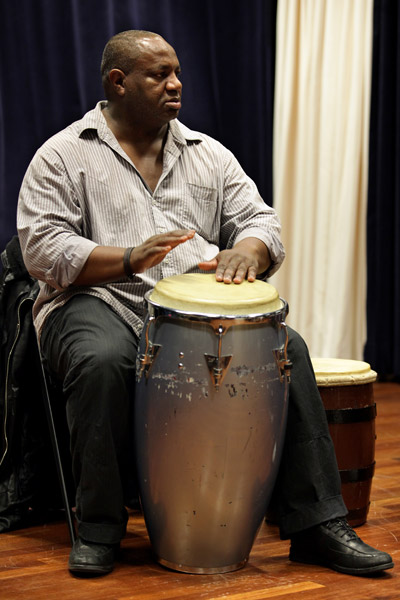 Rumba drummer Urban rumba (also called Rumba (de solar o de cajón)), is an amalgamation of several African drumming and dance traditions, combined with Spanish influences. According to Cuban musicologist Argeliers León: "In the feast that constituted a rumba concurred, therefore, determined African contributions, but also converged other elements from Hispanic roots, that were already incorporated to the expressions that appeared in the new population emerging in the Island."[132] Rumba (de solar o de cajón) is a secular musical style from the docks and the less prosperous areas of Havana and Matanzas. A the beginning, rumba musicians used a trio of wooden boxes (cajones) to play, that were substituted at a later time by drums, similar in appearance to conga drums. The treble drum is called "quinto", the medium range drum is called "macho or tres-dos" (three-two), because its essential rhythm is based on the Cuban clave pattern, and the bass drum is called "hembra o salidor," because it usually began or "broke in" (rompía) the rumba.[133] In the Rumba ensemble they also utilize two sticks or spoons to beat over a hollow piece of bamboo called "guagua" or "catá," as well as the Cuban Claves, the Güiro and some rattles from bantu origin called "nkembi".[134] The vocal part of the rumba corresponds to a modified version of the ancient Spanish style of "copla-estribillo" (quatrain-refrain), including a "montuno" section that one may consider an expanded or developed "refrain" that constitute an independent section which include the call and response style, so typical of the African traditions.[135] 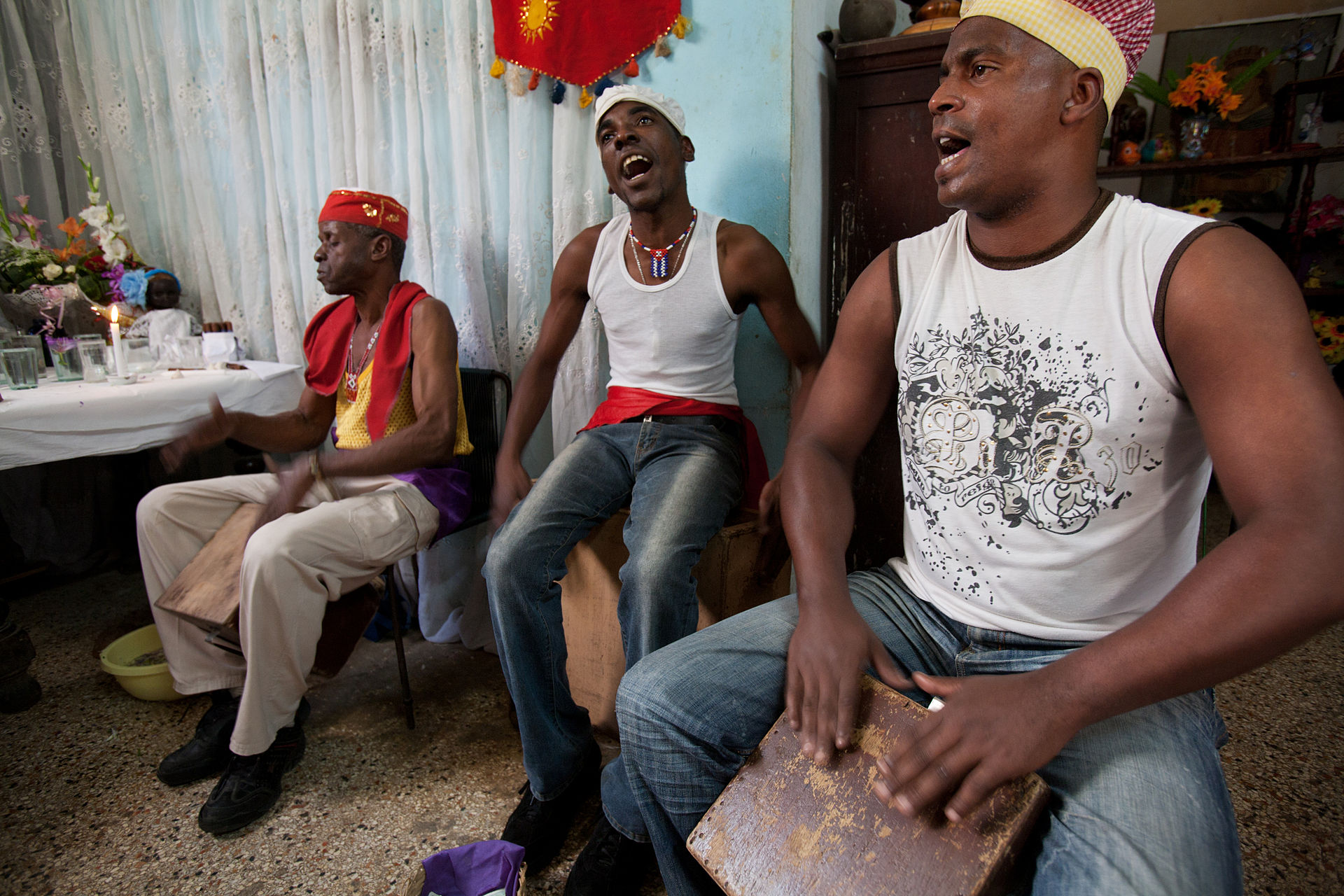 Rumba drummers From the many rumba styles that began to appear during the end of the 19th century called "Spanish times" (Tiempo'españa), such as tahona, jiribilla, palatino and resedá, three basic Rumba forms have survived: the Columbia, the guaguancó and the yambú. The Columbia, played in 6/8 time, is often as a solo dance performed only by a male performer. It is fast and swift and also includes aggressive and acrobatic moves. The guaguancó is danced by a pair of one man and one woman. The dance simulates the man's pursuit of the woman. The yambú, now a relic, featured a burlesque imitation of an old man walking with a stick. All forms of rumba are accompanied by song or chants.[136][137] Rumba (de solar o de cajón) is today a fossil genre usually seen in Cuba in performances of professional groups. There are also amateur groups based on Casas de Cultura (Culture Centers), and on work groups. Like all aspects of life in Cuba, dance and music are organised by the state through Ministries and their various committees.[138] |
アーバン・ルンバ 主な記事 ルンバ(太陽とカホン)  ルンバのドラマー アーバン・ルンバ(ルンバ(デ・ソーラー・オ・デ・カホン)とも呼ばれる)は、アフリカの伝統的な太鼓とダンスにスペインの影響を加えたものである。 キューバの音楽学者アルゲリエス・レオンによれば 「ルンバを構成する饗宴には、従って、アフリカの貢献が決定的に含まれているが、ヒスパニックのルーツに由来する他の要素も収束しており、それは島に出現 した新しい集団に登場した表現にすでに組み込まれていた」[132]。 ルンバ(de solar o de cajón)は、ハバナやマタンサスの波止場やあまり栄えていない地域で生まれた世俗的な音楽スタイルである。当初、ルンバ・ミュージシャンは3つの木製 の箱(カホン)を使って演奏していたが、後にコンガ・ドラムに似た外観のドラムに取って代わられた。高音ドラムは「キント」(quinto)、中音域のド ラムは「マッチョ」(macho)または「トレス・ドス」(tres-dos)(three-two)と呼ばれるが、これはその本質的なリズムがキューバ のクラーヴェのパターンに基づいているからである。 [133]ルンバ・アンサンブルでは、「グアグア」または「カタ」と呼ばれる中空の竹片の上で叩く2本のスティックやスプーン、キューバ・クラベス、グイ ロ、「ンケンビ」と呼ばれるバントゥー語起源のガラガラも利用される[134]。 ルンバのヴォーカルパートは、古代スペインのスタイルである 「copla-estribillo」(四行詩-リフレイン)の修正版に相当し、アフリカの伝統に典型的なコール・アンド・レスポンス・スタイルを含む独 立したセクションを構成する 「montuno 」セクションを含む。  ルンバ・ドラマー 19世紀末に「スペインの時代」(Tiempo'españa)と呼ばれるようになったタホナ(tahona)、ジリビージャ(jiribilla)、パ ラティーノ(palatino)、レセダ(resedá)など多くのルンバ・スタイルから、コロンビア(Columbia)、グアグアンコー (guaguancó)、ヤンブー(yambú)の3つの基本的なルンバ・フォームが残っている。コロンビアは8分の6拍子で演奏され、男性一人のソロダ ンスとして踊られることが多い。速くて素早く、攻撃的でアクロバティックな動きも含まれる。グアグアンコーは男女1人ずつがペアで踊る。この踊りは、男性 が女性を追いかける様子をシミュレートしている。ヤンブーは、今では遺物となってしまったが、杖をついて歩く老人をバーレスク風に真似たものだ。ルンバの すべての形式は歌や聖歌を伴う[136][137]。 ルンバ(デ・ソーラー・オ・デ・カホン)は今日、キューバでは通常プロのグループのパフォーマビティで見られる化石のようなジャンルである。また、カサ・ デ・クルトゥーラ(文化センター)や職場のグループによるアマチュア・グループもある。キューバの生活のあらゆる側面と同様に、ダンスと音楽は省庁やその 様々な委員会を通じて国家によって組織されている[138]。 |
| Coros de Clave Main article: Coros de Clave Coros de Clave were popular choral groups that emerged at the beginning of the 20th century in Havana and other Cuban cities. The Cuban government only allowed black people, slaves or free, to cultivate their cultural traditions within the boundaries of certain mutual aid societies, which were founded during the 16th century. According to David H. Brown, those societies, called Cabildos, "provided in times of sickness and death, held masses for deceased members, collected funds to buy nation-brethren out of slavery, held regular dances and diversions on Sundays and feast days, and sponsored religious masses, processions and dancing carnival groups (now called comparsas) around the annual cycle of Catholic festival days."[139] Within the Cabildos of certain neighborhoods from Havana, Matanzas, Sancti Spíritus and Trinidad, some choral groups were founded during the 19th century that organized competitive activities, and in some occasions were visited by local authorities and neighbors that gave them money and presents. Those choral societies were called Coros de Clave, probably after the instrument that used to accompany their performances, the Cuban Claves.[140] The accompaniment of the choirs also included a guitar and the percussion was executed over the sound box of an American banjo from which the strings were removed, due to the fact that African drums performance was strictly forbidden in Cuban cities.[141] The style of the Coros de Clave music, and particularly its rhythm, originated at a later time a popular song genre called Clave, which most probable served as the original prototype for the creation of the Criolla genre. Both genres, the Clave and the Criolla became very popular within the Cuban vernacular theater repertoire. |
コロ・デ・クラーベ 主な記事 コーロス・デ・クラーベ コーロス・デ・クラーベは、20世紀初頭にハバナやその他のキューバの都市で生まれたポピュラーな合唱団である。 キューバ政府は、奴隷であろうと自由であろうと、16世紀に設立された特定の相互扶助協会の枠内でしか黒人の文化的伝統を育むことを認めなかった。デイ ヴィッド・H・ブラウンによれば、カビルドと呼ばれるこれらの社会は、「病気や死の際に提供し、死亡したメンバーのためにミサを行い、国民的兄弟を奴隷か ら買い取るための資金を集め、日曜日や祝祭日に定期的にダンスや娯楽を行い、カトリックの祝祭日の年周期の前後に宗教的ミサ、行列、ダンス・カーニバル・ グループ(現在はコンパルサと呼ばれる)を後援した」[139]。 ハバナ、マタンサス、サンクティ・スピリトゥス、トリニダードの特定の地域のカビルドでは、19世紀にいくつかの合唱団が結成され、競争的な活動を組織し た。それらの合唱団は、おそらく彼らの演奏の伴奏に使われていた楽器、キューバン・クラベス(Cuban Claves)にちなんで、コーロス・デ・クラーベ(Coros de Clave)と呼ばれていた[140]。 合唱団の伴奏にはギターも含まれ、パーカッションは、キューバの都市ではアフリカン・ドラムの演奏が厳しく禁じられていたため、弦が外されたアメリカン・ バンジョーのサウンドボックスで演奏された[141]。コロス・デ・クラーヴェの音楽のスタイル、特にそのリズムは、後にクラーヴェと呼ばれる大衆歌謡の ジャンルを生み出し、クリオージャというジャンルを生み出す原型となった可能性が高い。クラーベとクリオージャの両ジャンルは、キューバの地方演劇のレ パートリーとして非常に人気があった。 |
Rural rumba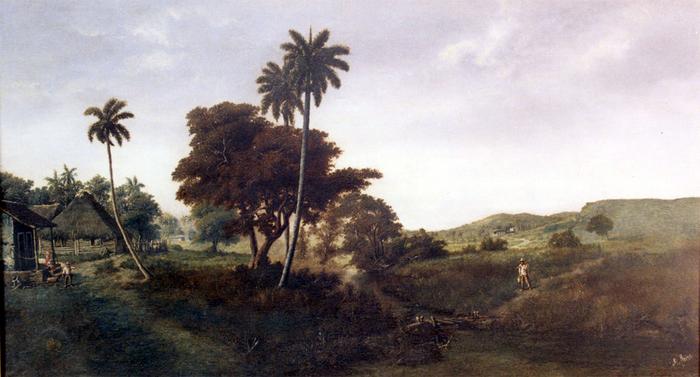 Cuban rural landscape In a similar way as the first Spanish song-dances spread from the cities to the countryside, also the characteristics of the Cuban Guaracha, that enjoyed great popularity in Havana, began to spread to the rural areas in an undetermined time during the 19th century. This process was not difficult at all if one considers how close one to the other were the urban and the rural areas in Cuba at that time. That was why the Cuban peasants (guajiros) began to include in their parties called "guateques" or "changüís", and in feasts such as the "fiestas patronales" (patron saint celebrations) and the "parrandas", some Rumbitas (little rumbas) that were very similar to the urban Guarachas, which binary meter contrasted with the ternary beat of their traditional "tonadas" and "zapateos".[142] Those little rural rumbas have been called by renowned musicologist Danilo Orozco "proto-sones", "soncitos primigenios", "rumbitas", "nengones"or "marchitas," and some of them, such as: Caringa, Papalote, Doña Joaquina, Anda Pepe and the Tingotalango have been preserved until the present time.[143] The Rumbitas were considered as Proto-sones (primeval Sones), because of the evident analogy that its structural components show with the Son, which emerged in Havana during the first decades of the 20th century. The Rumbitas may be considered as the original prototype of this popular genre.[144] According to musicologist Virtudes Feliú, those Rumbitas appeared in cities and towns throughout the entire territory of the Island, such as: Ciego de Ávila, Sancti Espíritus, Cienfuegos, Camagüey, Puerta de Golpe in Pinar del Río and Bejucal in Havana, as well as Remedios in Villa Clara and Isla de Pinos (Pines Island).[145] There are many references to the Cuban Independence Wars (1868-1898), related to the rural Rumbitas, in the Eastern region of the country as well as in the Western region and Isla de Pinos, which suggest that their emergence took place approximately during the second half of the 19th century.[146] The rural Rumbitas included a greater number of African characteristics in comparison with the Cuban Guaracha, due to the gradual integration of free Afro-Cuban citizens to the rural environment.[147] Since the 16th century, thanks to a government approved program called "manumisión", the black slaves were allowed to pay for their freedom with their own savings. Therefore, a larger number of free blacks were dedicated to the manual labors in the fields than in the cities and some of them were also able to become proprietaries of land and slaves.[148] Characteristics of the rural rumba 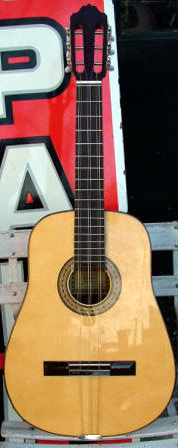 Tres cubano One of the most salient characteristics of the rural Rumbitas was its own form, very similar to the African typical song structure. In this case, the entire piece was based on a single musical fragment or phrase of short duration that was repeated, with some variations, time and time again; often alternating with a choir. This style was called "Montuno" (literally "from the countryside") due to its rural origin.[149] 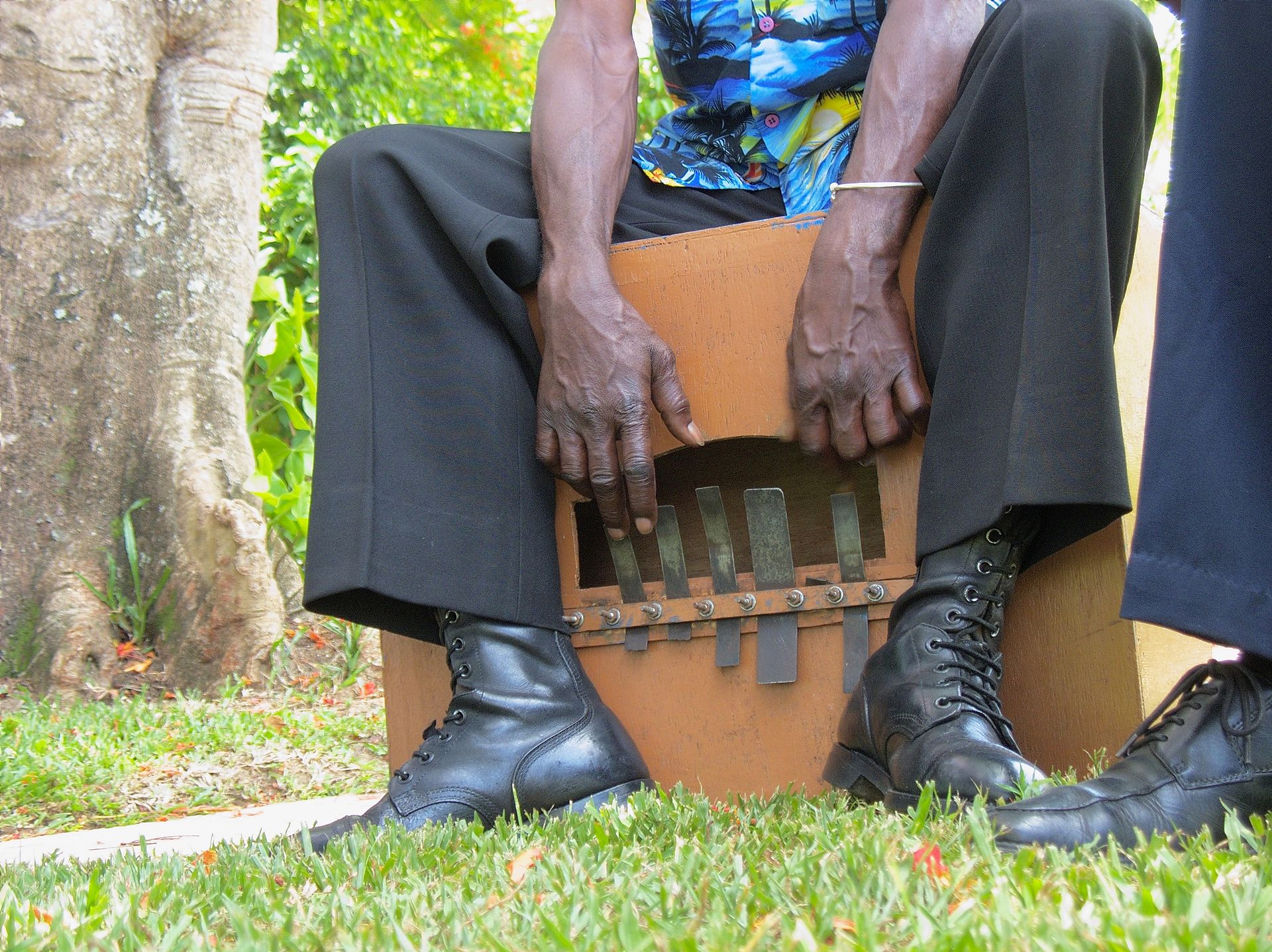 Marímbula Another characteristic of the new genre was the superposition of different rhythmic patterns simultaneously executed, similarly to the way it is utilized in the Urban Rumba, which is also a common trait of the African musical tradition.[150] Those layers or "franjas de sonoridades" according to Argeliers León, were assigned to different instruments that were gradually incorporated to the group. Therefore, the ensemble grew from the traditional Tiple and Güiro, to a one that included: guitar, "bandurria", Cuban lute, claves, and other instruments such as the"tumbandera", the "marímbula", the "botija", the bongoes, the common "machete" (cutlass) and the accordion.[151] 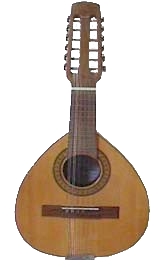 "bandurria" Some important musical functions were assigned to the sonority layers, such as the: "Time Line" or Clave Rhythm performed by the claves, a "1-eighth note + 2-sixteenth notes" rhythm played by the güiro or the machete, the patterns of the "guajeo" by the Tres (instrument), the improvisation on the bongoes and the anticipated bass on the "tumbandera" or the "botija".[152] |
農村=田舎のルンバ キューバの田園風景 スペインの最初の歌舞曲が都市から農村へと広がっていったのと同じように、ハバナで絶大な人気を誇ったキューバ・グアラチャの特徴もまた、19世紀のまだ 定かでない時期に農村へと広がり始めた。当時のキューバの都市部と農村部がいかに近接していたかを考えれば、このプロセスはまったく難しいものではなかっ た。そのため、キューバの農民(グアジロス)は、「グアテケス」や「チャングイス」と呼ばれるパーティや、「フィエスタス・パトローナレス(守護聖人 祭)」や「パランダス」などの祝祭に、都市部のグアラチャスと非常によく似たルンビタス(小さなルンバ)を取り入れるようになった。 これらの小さな田舎のルンバは、著名な音楽学者ダニロ・オロスコによって「プロト・ソネス」、「ソンシトス・プリミゲニオス」、「ルンビタス」、「ネンゴ ネス」、「マルキタス」と呼ばれており、そのうちのいくつかは以下のようなものである: カリンガ、パパロテ、ドニャ・ホアキーナ、アンダ・ペペ、ティンゴタランゴといったものが現在まで保存されている[143]。 ルンビタスは、20世紀の最初の数十年間にハバナで出現したソンとの構造的な類似性が明らかであったことから、プロト・ソン(原初のソン)と考えられていた。ルンビタスは、このポピュラー・ジャンルの原型と考えられる[144]。 音楽学者のヴィルトゥデス・フェリウによれば、これらのルンビタスは、ハバナ島の全領土の都市や町に出現したという: シエゴ・デ・アビラ、サンクティ・エスピリトゥス、シエンフエゴス、カマグエイ、ピナール・デル・リオのプエルタ・デ・ゴルペ、ハバナのベジュカル、ビ ジャ・クララやイスラ・デ・ピノス(松島)のレメディオスなどである[145]。 キューバ独立戦争(1868年~1898年)については、東部地域、西部地域、ピノス島でルンビタスに関連する記述が多く、19世紀後半にルンビタスが出現したことを示唆している[146]。 農村部のルンビタスは、キューバのグアラチャと比較してアフリカの特徴をより多く含んでいたが、これは自由なアフロ・キューバの市民が農村環境に徐々に溶け込んでいったためである[147]。 16世紀以降、政府が承認した「マニュミシオン」と呼ばれるプログラムのおかげで、黒人奴隷は自らの貯蓄で自由を得るための費用を支払うことが許された。 そのため、都市部よりも多くの自由黒人が畑での肉体労働に従事し、彼らの一部は土地や奴隷の所有者になることもできた[148]。 農村ルンバの特徴  トレス・クバーノ 農村ルンビタスの最も顕著な特徴のひとつは、アフリカの典型的な曲の構成に非常によく似た独自の形式であった。この場合、曲全体は、短い持続時間の単一の 音楽的断片やフレーズに基づいており、それがいくつかのバリエーションを伴って何度も繰り返され、しばしば合唱と交互に演奏された。この様式は、その田舎 に由来することから「モントゥーノ」(文字通り「田舎から来た」)と呼ばれた[149]。  マリアンブラ この新しいジャンルのもうひとつの特徴は、アフリカ音楽の伝統に共通する特徴でもあるアーバン・ルンバと同じように、異なるリズム・パターンを重ね合わせ て同時に演奏することであった[150]。アルゲリエス・レオンによれば、これらのレイヤー、すなわち「フランハス・デ・ソノリダーデス」は、徐々にグ ループに組み込まれた異なる楽器に割り当てられた。そのため、アンサンブルは伝統的なティプルとグイロから、ギター、「バンドゥリア」、キューバン・ リュート、クラベス、そして「トゥンバンデラ」、「マリンブラ」、「ボティージャ」、ボンゴ、一般的な「マチェーテ」(カトラス)、アコーディオンといっ た他の楽器を含むものへと成長した[151]。  "bandurria" いくつかの重要な音楽的機能がソノリティの層に割り当てられた: クラベスによって演奏される「時間軸」やクラーベのリズム、グイロやマチェーテによって演奏される「8分音符1つ+16分音符2つ」のリズム、トレス(楽 器)による「グアジェオ」のパターン、ボンゴによる即興演奏、「トゥンバンデラ」や「ボティージャ」による予想低音などである[152]。 |
| Proto-son The origin of the Cuban son can be traced to the rural rumbas, called proto-sones (primeval sones) by musicologist Danilo Orozco. They show, in a partial or embryonic form, all the characteristics that at a later time were going to identify the Son style: The repetition of a phrase called montuno, the clave pattern, a rhythmic counterpoint between different layers of the musical texture, the guajeo from the Tres, the rhythms from the guitar, the bongoes and the double bass and the call and response style between soloist and choir.[153] According to Radamés Giro: at a later time the refrain (estribillo) or montuno was tied to a quatrain (cuarteta – copla) called regina, which was how the peasants from the Eastern side of the country called the quatrain. In this way, the structure refrain–quatrain–refrain appears at a very early stage in the Son Oriental, like in one of the most ancient Sones called "Son de Máquina" (Machine Son) which comprises three reginas with its correspondent refrains.[154] During an investigative project about the Valera-Miranda family (old Soneros) conducted by Danilo Orozco in the region of Guantánamo, he recorded a sample of Nengón, which is considered an ancestor of the Changüí. It shows the previously mentioned refrain–quatrain–refrain structure. In this case, the several repetitions of the refrain constitute a true "montuno." Refrain: Yo he nacido para ti nengón, yo he nacido para ti nengón, yo he nacido para ti Nengón... (I was born for you Nengón...)[155] Nengón The "Nengón" is considered a Proto-Son, precursor of the Changüí and also of the Oriental Son. Its main characteristic is the alternance of improvised verses between a soloist and a choir. The Nengón is played with Tres, Guitar, Güiro and Tingotalango or Tumbandera.[156] Changüí Main article: Changüí Changüí is a type of son from the eastern provinces (area of Santiago de Cuba and Guantánamo), formerly known as Oriente. It shares relevant characteristics with the Oriental Son in regard to rhythms, instruments and choral refrains; and at the same time it shows certain original elements.[157] Changüí exists today in the form of dozens of small groups, mostly from Guantanamo province.[158] The instrumentation is similar to that of the early Son groups who set up in Havana before 1920. These son groups, for example, the early Sexteto Boloña and Sexteto Habanero, used either marimbulas or botijas as bass instruments before they changed over to the double bass, musically a more flexible instrument. Changui is a genuinely distinctive music and culture practiced by residents of the Guantanamo province with its own distinctive social dance form (couple dance). Guantanameros engage in Changui in house parties (called Peñas), street parties, concerts at venues such as Casa de Changui, a weekly Monday night dance broadcast live on Radio Guantanamo, an annual Changui festival to celebrate the anniversary of Chito Latanble, and the bi-annual Festival de Changui. There is often a Changui function on most nights of the week at the Province. Some modern orchestras, such as Orquesta Revé, have claimed Changüí as their main influence. Whether this is accurate, or not, is unclear. Sucu-Sucu We can also find in Isla de Pinos, at the opposite Western side of the Island a primeval Proto-Son called Sucu-Sucu, which also shows the same structure of the Oriental Proto-Sones. According to Maria Teresa Linares, In the Sucu-Sucu the music is similar to a Son Montuno in its formal, melodic, instrumental and harmonic structure. A soloist alternates with a choir and improvises on a quatrain or a "décima." The instrumental section is introduced by the Tres, gradually joined by the other instruments. The introduction of eight measures is followed by the refrain by the choir that alternates with the soloist several times.[159] An urban legend claims that the name "Sucu Sucu" came from the grandmother of one of the local musicians in la Isla de Juventud. The band was playing in the patio, and the dances were dancing while shuffling their feet on the sandy floor. The grandmother came out of the house to say "Please stop making noise with all that sucu sucu," referring to the sound of shuffling feet on a sandy floor. The legend claim that the name stuck, and the music the dancers were dancing too started to be named "Sucu Sucu". |
プロト・ソーン キューバのソンの起源は、音楽学者ダニーロ・オロスコがプロト・ソーン(原初のソーン)と呼んだ田舎のルンバに遡ることができる。このルンバには、後にソ ンのスタイルを特徴づけることになるすべての特徴が、部分的あるいは胎生的な形で表れている: モントゥーノと呼ばれるフレーズの反復、クラーベ・パターン、音楽テクスチュアの異なるレイヤー間のリズムの対位法、トレスのグアヘオ、ギター、ボンゴ、 コントラバスのリズム、ソリストと合唱団のコール・アンド・レスポンス・スタイルなどである。 [153]ラダメス・ジロによると、後年、リフレイン(エストリビージョ)やモントゥーノは、レジーナと呼ばれる四連符(クアルテータ-コプラ)に結び付 けられるようになった。このように、リフレイン-クアットレイン-リフレインという構造は、東洋のソンでは非常に早い段階から現れており、最も古いソンの ひとつである「ソン・デ・マキーナ(機械のソン)」のように、3つのレジーナとそれに対応するリフレインから構成されている[154]。 ダニロ・オロスコがグアンタナモ地方で行ったヴァレラ=ミランダ家(古いソネーロ)の調査プロジェクトで、彼はチャングイの祖先とされるネンゴンのサンプ ルを記録した。これは先に述べたリフレイン-クワトレイン-リフレインの構造を示している。この場合、リフレインが何度も繰り返されることで、真の 「montuno 」を構成している。 リフレイン リフレイン:Yo he nacido para ti nengón, yo he nacido para ti nengón, yo he nacido para ti Nengón...(私はネンゴンのために生まれた)[155]。 ネンゴン 「Nengón 」は、「Changüí 」や 「Oriental Son 」の前身となる原子と考えられている。主な特徴は、独唱と合唱が交互に即興の詩を歌うことである。ネンゴンは、トレス、ギター、グィロ、ティンゴタランゴ またはトゥンバンデラと一緒に演奏される[156]。 チャングイ 主な記事 チャングイ チャングイは、かつてオリエンテと呼ばれていた東部地方(サンティアゴ・デ・クーバとグアンタナモの地域)のソンの一種である。リズム、楽器、合唱のリフレインに関してオリエンタル・ソンと共通する特徴を持つが、同時に独自の要素も見られる[157]。 チャングイは今日、主にグアンタナモ州の数十の小グループの形で存在している[158]。楽器編成は、1920年以前にハバナで結成された初期のソン・グ ループと類似している。これらのソン・グループ、例えば初期のセクステート・ボローニャやセクステート・ハバネロは、音楽的により柔軟な楽器であるコント ラバスに変更する前は、マリンブラかボティジャをベース楽器として使用していた。 チャングイは、グアンタナモ州の住民が独自の社交ダンス(カップルダンス)を用いて実践する、真に独特な音楽と文化である。グアンタナモの人々は、ハウ ス・パーティー(ペーニャスと呼ばれる)、ストリート・パーティー、カサ・デ・チャンギのような会場でのコンサート、ラジオ・グアンタナモで毎週月曜夜に 生放送されるダンス、チト・ラタンブルの記念日を祝う年1回のチャンギ祭り、年2回のフェスティヴァル・デ・チャンギなどでチャンギに親しんでいる。州で は、週のほとんどの夜にチャングイの催しがある。 オルケスタ・レヴェのような現代のオーケストラの中には、チャングイに大きな影響を受けたと主張するものもある。これが正確かどうかは不明である。 スクスク 島の反対側の西側にあるピノス島にも、東洋のプロト・ソネと同じ構造を持つ、スクスクと呼ばれる原始ソネを見つけることができる。マリア・テレサ・リナレ スによると、スクスクの音楽は、形式的、旋律的、器楽的、和声的構造において、ソン・モントゥーノに似ている。ソリストが合唱と交互に、四連符や 「デシマ 」を即興で演奏する。器楽部分はトレスによって導入され、徐々に他の楽器が加わる。8小節の序奏に続いて、合唱団によるリフレインがソリストと交互に何度 か繰り返される[159]。 Sucu Sucu」という名前は、la Isla de Juventudの地元のミュージシャンの祖母に由来するという都市伝説がある。バンドがパティオで演奏していて、ダンスが砂の床で足をシャカシャカさせ ながら踊っていた。祖母は家から出てきて、砂の床で足をシャカシャカさせる音を指して「スクスクと音を立てるのはやめてください」と言った。伝説による と、この名前が定着し、ダンサーたちが踊っていた音楽は「スクスク」と名付けられるようになったという。 |
| Trova Main article: Trova In the 19th century, Santiago de Cuba became the focal point of a group of itinerant musicians, troubadours, who moved around earning their living by singing and playing the guitar.[160] They were of great importance as composers, and their songs have been transcribed for all genres of Cuban music Pepe Sánchez, born José Sánchez (1856–1918), is known as the father of the trova style and the creator of the Cuban bolero.[161] He had no formal training in music. With remarkable natural talent, he composed numbers in his head and never wrote them down. As a result, most of these numbers are now lost for ever, though some two dozen or so survive because friends and disciples transcribed them. His first bolero, Tristezas, is still remembered today. He also created advertisement jingles before radio was born.[162] He was the model and teacher for the great trovadores who followed him.[163] 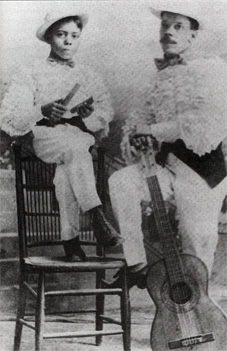 Guarionex & Sindo Garay The first, and one of the longest-lived, was Sindo Garay (1867–1968). He was an outstanding composer of trova songs, and his best have been sung and recorded many times. Garay was also musically illiterate – in fact, he only taught himself the alphabet at 16 – but in his case not only were scores recorded by others, but there are recordings. Garay settled in Havana in 1906, and in 1926 joined Rita Montaner and others to visit Paris, spending three months there. He broadcast on radio, made recordings and survived into modern times. He used to say "Not many men have shaken hands with both José Martí and Fidel Castro!"[13]p298[164] José 'Chicho' Ibáñez (1875–1981)[165] was even longer-lived than Garay. Ibáñez was the first trovador to specialize in the son; he also sang guaguancós and pieces from the abakuá. The composer Rosendo Ruiz (1885–1983) was another long-lived trovador. He was the author of a well-known guitar manual. Alberto Villalón (1882–1955), and Manuel Corona (1880–1950) were of similar stature. Garay, Ruiz, Villalón and Corona are known as the four greats of the trova, though the following trovadores are also highly regarded. Patricio Ballagas (1879–1920); María Teresa Vera (1895–1965), Lorenzo Hierrezuelo (1907–1993), Ñico Saquito (Antonio Fernandez: 1901–1982), Carlos Puebla (1917–1989) and Compay Segundo (Máximo Francisco Repilado Muñoz: 1907–2003) were all great trova musicians. El Guayabero (Faustino Oramas: 1911–2007) was the last of the old trova. Trova musicians often worked in pairs and trios, some of them exclusively so (Compay Segundo). As the sexteto/septeto/conjunto genre grew many of them joined in the larger groups. And let's not forget the Trio Matamoros, who worked together for most of their lives. Matamoros was one of the greats.[166] Bolero Main articles: Bolero § Cuba, and Trova This is a song and dance form quite different from its Spanish namesake. It originated in the last quarter of the 19th century with the founder of the traditional trova, Pepe Sánchez. He wrote the first bolero, Tristezas, which is still sung today. The bolero has always been a staple part of the trova musician's repertoire. 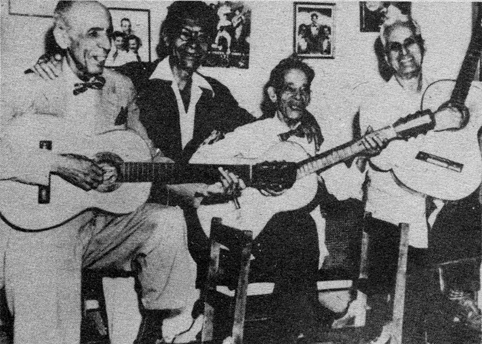 Rosendo Ruiz, Manuel Corona, Sindo Garay & Alberto Villalon Originally, there were two sections of 16 bars in 2/4 time separated by an instrumental section on the Spanish guitar called the pasacalle. The bolero proved to be exceptionally adaptable, and led to many variants. Typical was the introduction of sychopation leading to the bolero-moruno, bolero-beguine, bolero-mambo, bolero-cha. The bolero-son became for several decades the most popular rhythm for dancing in Cuba, and it was this rhythm that the international dance community picked up and taught as the wrongly-named 'rumba'. The Cuban bolero was exported all over the world, and is still popular. Leading composers of the bolero were Sindo Garay, Rosendo Ruiz, Carlos Puebla, and Agustín Lara (Mexico).[161][167][168][169][170] Canción Main article: Canción Canción means 'song' in Spanish. It is a popular genre of Latin American music, particularly in Cuba, where many of the compositions originate. Its roots lie in Spanish, French and Italian popular song forms. Originally highly stylized, with "intricate melodies and dark, enigmatic and elaborate lyrics"[171] The canción was democratized by the trova movement in the latter part of the 19th century, when it became a vehicle for the aspirations and feelings of the population. Canción gradually fused with other forms of Cuban music, such as the bolero.[172] |
トロバ 主な記事 トロバ 19世紀、サンティアゴ・デ・クーバは、歌とギターで生計を立てながら各地を旅する音楽家グループ、トルバドゥールの中心地となった[160]。彼らは作曲家としても重要な存在であり、彼らの歌はキューバ音楽のあらゆるジャンルに移植されている。 ホセ・サンチェス(1856-1918)生まれのペペ・サンチェスは、トローバ・スタイルの父、キューバのボレロの生みの親として知られている [161]。驚くべき天賦の才能を持つ彼は、頭の中でナンバーを作曲し、それを書き留めることはなかった。その結果、これらのナンバーのほとんどは永遠に 失われてしまったが、20数曲は友人や弟子たちが書き写したために残っている。彼の最初のボレロ『トリステーザス』は、今日でも記憶に残っている。彼はま た、ラジオが誕生する前に広告のジングルを作っていた[162]。彼は、彼に続く偉大なトロヴァドールたちの手本であり、師でもあった[163]。  グアリオネックス&シンド・ガライ 最初の、そして最も長生きした一人がシンド・ガライ(1867-1968)である。彼はトロヴァ歌曲の優れた作曲家であり、彼の最高傑作は何度も歌われ、 録音されている。ガレイは音楽的な文盲でもあった--実際、彼は16歳のときにアルファベットを独学で覚えただけだった--が、彼の場合、楽譜が他者に よって録音されただけでなく、レコーディングも存在する。ガレイは1906年にハバナに定住し、1926年にはリタ・モンタネールらとパリを訪れ、3ヵ月 を過ごした。彼はラジオで放送し、録音をし、現代まで生き残った。彼はよく「ホセ・マルティとフィデル・カストロの両方と握手した男はそうそういない!」 と言っていた[13]p298[164]。 ホセ・'チチョ'・イバニェス(1875-1981)[165]は、ガレイよりもさらに長命だった。イバニェスは息子を専門とした最初のトロバドールで、グアガンコやアバクアの曲も歌った。 作曲家のロセンド・ルイス(1885-1983)も長寿のトロバドールである。有名なギター教則本の著者でもある。アルベルト・ビジャロン(1882- 1955)、マヌエル・コロナ(1880-1950)も同様の存在であった。ガレイ、ルイス、ビジャロン、コロナがトロバの4大巨頭として知られている が、以下のトロバドールも高く評価されている。 パトリシオ・バラガス(1879~1920年)、マリア・テレサ・ベラ(1895~1965年)、ロレンソ・ヒエレスエロ(1907~1993年)、ニー コ・サキート(アントニオ・フェルナンデス:1901~1982年)、カルロス・プエブラ(1917~1989年)、コンパイ・セグンド(マキシモ・フラ ンシスコ・レピラード・ムニョス:1907~2003年)はいずれも偉大なトロバ音楽家だった。エル・グアヤベーロ(ファウスティーノ・オラマス: 1911-2007)は、古いトロバの最後の一人だった。 トロヴァの音楽家たちは、しばしばペアやトリオで活動し、そのうちの何人かは専属だった(コンパイ・セグンド)。セクステート/セプテート/コンジュント というジャンルが成長するにつれ、彼らの多くが大きなグループに加わった。彼らの生涯のほとんどを共にしたトリオ・マタモロスも忘れてはならない。マタモ ロスは偉大な人物のひとりだった[166]。 ボレロ 主な記事 ボレロ§キューバ、トロバ ボレロは、スペインのボレロとは全く異なる歌と踊りの形式である。19世紀末に伝統的なトロバの創始者であるペペ・サンチェス(Pepe Sanchez)によって創始された。彼は最 初のボレロ「Tristezas」を作曲し、これは今日でも歌われている。ボレロは常に、トローバ・ミュージシャンの定番レパートリーであった。  ロセンド・ルイス、マヌエル・コロナ、シンド・ガライ、アルベルト・ビジャロン もともとは、2/4拍子で16小節からなる2つのセクションがあり、パサカレと呼ばれるスパニッシュ・ギターの楽器セクションで区切られていた。ボレロは 非常に順応性が高く、多くの変種が生まれた。代表的なものは、ボレロ-モルーノ、ボレロ-ベギン、ボレロ-マンボ、ボレロ-チャにつながるシコーペーショ ンの導入である。ボレロ・ソンは数十年にわたりキューバで最もポピュラーなリズムとなり、国際的なダンス・コミュニティがこのリズムを「ルンバ」という間 違った名前で取り上げ、教えた。 Bolero Rhythm for Two Congas (YouTube) キューバのボレロは世界中に輸出され、今でも人気がある。ボレロの代表的な作曲家は、シンド・ガライ、ロセンド・ルイス、カルロス・プエブラ、アグスティン・ララ(メキシコ)である[161][167][168][169][170]。 カンシオン 主な記事 カンシオン カンシオンはスペイン語で「歌」を意味する。ラテンアメリカ音楽、特にキューバで人気のあるジャンルであり、多くの楽曲がここで生まれた。そのルーツはス ペイン、フランス、イタリアのポピュラー・ソングにある。カンシオンは、19世紀後半のトローバ運動によって民主化され、民衆の願望や感情を表現する手段 となった。カンシオンは、ボレロなど他の形式のキューバ音楽と徐々に融合していった[172]。 |
| Tropical waltz The waltz (El vals) arrived in Cuba by 1814. It was the first dance in which couples were not linked by a communal sequence pattern. It was, and still is, danced in 3/4 time with the accent on the first beat. It was originally thought scandalous because couples faced each other, held each other in the 'closed' hold, and, so to speak, ignored the surrounding community. The waltz entered all countries in the Americas; its relative popularity in 19th-century Cuba is hard to estimate. Indigenous Cuban dances did not use the closed hold with couples dancing independently until the danzón later in the century, though the guaracha might be an earlier example. The waltz has another characteristic: it is a 'travelling' dance, with couples moving round the arena. In Latin dances, progressive movement of dancers is unusual, but does occur in the conga, the samba and the tango. The Tropical waltz was performed in a slower tempo and frequently included a sung melody with a text. Those texts usually referred to the beauties of the Cuban countryside, the longing of the Siboneyes (Cuban aboriginee) and other creole themes. With accents on its three beats, its melody was fluid and composed of equal value notes. It was similar to many other songs in which the melody was treated in a syllabic way, where the first beat was not stressed by a brief anacrusis but had a tendency to move toward the second beat like in the peasant (guajiro) song.[173] |
トロピカル・ワルツ ワルツ(El vals)は1814年までにキューバに到着した。このダンスは、カップルが共通のシークエンス・パターンで結ばれていない最初のダンスである。昔も今 も、1拍目にアクセントを置いた3/4拍子で踊られる。当初は、カップルが互いに向き合い、「閉じた」ホールドで抱き合い、いわば周囲のコミュニティを無 視することから、スキャンダラスなものと考えられていた。ワルツはアメリカ大陸のすべての国に広まったが、19世紀のキューバにおける相対的な人気は推し 量りがたい。 キューバ固有のダンスでは、世紀後半にダンソンが登場するまで、カップルが独立して踊るクローズド・ホールドは使われなかったが、グアラチャはそれ以前の 例かもしれない。ワルツにはもうひとつ特徴がある。それは、カップルがアリーナを移動しながら踊る「トラベリング」ダンスであることだ。ラテンダンスで は、ダンサーが漸進的に移動することは珍しいが、コンガ、サンバ、タンゴでは見られる。 トロピカル・ワルツはゆったりとしたテンポで踊られ、しばしばテキスト付きのメロディが歌われる。これらのテキストは通常、キューバの田舎の美しさ、シボ ネー人(キューバの原住民)の憧れ、その他のクレオールのテーマに言及していた。3拍子にアクセントがあり、メロディーは流動的で、同値音符で構成されて いる。メロディが音節的に扱われる他の多くの歌曲と似ており、1拍目は短いアナクルシスによって強調されるのではなく、農民(guajiro)の歌のよう に2拍目に向かう傾向があった[173]。 |
| Son Main article: Son (music) Guitar and Tres Son cubano is a style of music and dance that originated in Cuba and gained worldwide popularity during the 1930s. Son combines the structure and traits of the Spanish canción with Afro-Cuban stylistic and percussion instruments elements. The Cuban Son is one of the most influential and widespread forms of Latin American music: its derivatives and fusions, especially salsa, have spread across the world.[174] The Son, said Cristóbal Díaz, is the most important genre of Cuban music, and the least studied.[175] It can fairly be said that son is to Cuba what the tango is to Argentina, or the samba to Brazil. In addition, it is perhaps the most flexible of all forms of Latin-American music. Its great strength is its fusion between European and African musical traditions. Its most characteristic instruments are the Cuban instrument known as the tres, and the well-known double-headed bongó; these are present from the start to the present day. Also typical are the claves, the Spanish guitar, the double bass (replacing the early botija or marímbula), early on the cornet or trumpet and finally the piano. In spite of a traditional tendency to attribute the origin of Cuban Son to the Eastern region of Cuba (Oriente), most recently, some musicologists have shown a more inclusive stance. Although Alejo Carpentier, Emilio Grenet and Cristóbal Díaz Ayala support the "Eastern origin" theory, Argeliers León does not mention anything about it in his pivotal work "Del Canto y el Tiempo", as well as María Teresa Linares in "The Music between Cuba and Spain."[176] Ramadamés Giro states about this subject: "If Son was an artistic phenomenon that was developing since the second half of the 19th century – and not just in the old Oriente (Eastern) province -, it is logical to suppose, but not to affirm, that long before 1909 it was heard in the Capital City (Havana) because of the aforementioned reasons."[177] It was in Havana where the encounter of the rural rumba and the urban rumba, that had been developing separately during the second half of the 19th century, took place. The guaracheros and rumberos that used to play with the Tiple and the Guiro finally met other Rumberos that sang and danced accompanied by the wooden box (cajón) and the Cuban Clave, and the result was the fusion of both styles in a new genre called Son.[178] Around 1910 the Son most likely adopted the clave rhythm from the Havana-based rumba, which had been developed in the late 19th century in Havana and Matanzas.[179] The mass popularization of Son music led to an increased valorization of Afro-Cuban street culture and of the artists who created it. It also opened the door for other music genres with Afro-Cuban roots to become popular in Cuba and throughout the world.[180] |
ソン 主な記事 ソン(音楽) ギターとトレス ソン・クバーノはキューバで生まれ、1930年代に世界的な人気を得た音楽とダンスのスタイルである。ソンは、スペインのカンシオンの構造と特徴に、アフ ロ・キューバの様式と打楽器の要素を組み合わせたものである。キューバのソンは、ラテン・アメリカ音楽において最も影響力があり、広く普及している形態の ひとつであり、その派生や融合、特にサルサは世界中に広まっている[174]。 クリストバル・ディアスは、ソンはキューバ音楽の最も重要なジャンルであり、最も研究されていないジャンルであると述べている[175]。ソンはキューバ にとって、アルゼンチンにとってのタンゴ、ブラジルにとってのサンバのようなものだと言える。加えて、おそらくラテン・アメリカ音楽のあらゆる形態の中で 最も柔軟性がある。その大きな強みは、ヨーロッパとアフリカの音楽伝統の融合にある。最も特徴的な楽器は、トレスとして知られるキューバの楽器と、よく知 られた双頭のボンゴで、これらは最初から現在まで存在する。また、クラベス、スパニッシュ・ギター、コントラバス(初期のボティージャやマリンブラの代わ り)、初期のコルネットやトランペット、そして最後にピアノも典型的な楽器である。 キューバのソンの起源はキューバ東部(オリエンテ)にあるとする伝統的な傾向があったが、最近では、より包括的なスタンスを示す音楽学者もいる。アレホ・ カルペンティエ、エミリオ・グレネ、クリストバル・ディアス・アヤラは「東方起源」説を支持しているが、アルゲリエス・レオンはその重要な著作『デル・カ ント・イ・エル・ティエンポ』において、またマリア・テレサ・リナレスは『キューバとスペインの間の音楽』において、それについて何も言及していない [176]: 「ソンが19世紀後半から、しかも旧オリエンテ(東部)州だけでなく、発展していた芸術的現象であったとすれば、1909年よりずっと以前から、前述の理 由から首都(ハバナ)で聴かれていたと考えるのは論理的だが、断言はできない」[177]。 19世紀後半に別々に発展していた農村ルンバと都市ルンバの出会いはハバナで起こった。ティプルとギロで演奏していたグアラチェロとルンベロは、木製の箱 (カホン)とキューバン・クラーヴェを伴奏に歌い踊る他のルンベロとついに出会い、その結果、両スタイルが融合してソンと呼ばれる新しいジャンルとなった [178]。1910年頃、ソンはハバナやマタンサスで19世紀後半に発展したハバナ・ルンバからクラーヴェのリズムを取り入れた可能性が高い [179]。 ソン音楽の大衆化は、アフロ・キューバン・ストリート文化やそれを生み出したアーティストの価値を高めることにつながった。また、アフロ・キューバンをルーツとする他の音楽ジャンルがキューバや世界中で人気を博すきっかけとなった[180]。 |
| Cuban jazz The history of jazz in Cuba was obscured for many years, but it has become clear that its history in Cuba is virtually as long as its history in the US.[181][182][183][184][185][186] Much more is now known about early Cuban jazz bands, but a full assessment is plagued by the lack of recordings. Migrations and visits to and from the US and the mutual exchange of recordings and sheet music kept musicians in the two countries in touch. In the first part of the 20th century, there were close relations between musicians in Cuba and those in New Orleans. The orchestra leader in the famous Tropicana Club, Armando Romeu Jr, was a leading figure in the post-World War II development of Cuban jazz. The phenomenon of cubop and the jam sessions in Havana and New York organized by Cachao created genuine fusions that influence musicians today. A key historian of early Cuban jazz is Leonardo Acosta.[181][182] Others have explored the history of jazz and Latin jazz more from the U.S. perspective.[183][184][185][186] Early Cuban jazz bands 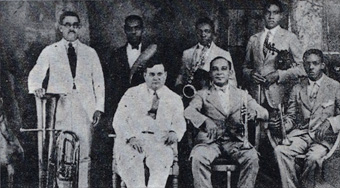 Jazz Band Sagua, 1920s The Jazz Band Sagua was founded in Sagua la Grande in 1914 by Pedro Stacholy (director & piano). Members: Hipólito Herrera (trumpet); Norberto Fabelo (cornet); Ernesto Ribalta (flute & sax); Humberto Domínguez (violin); Luciano Galindo (trombone); Antonio Temprano (tuba); Tomás Medina (drum kit); Marino Rojo (güiro). For fourteen years they played at the Teatro Principal de Sagua. Stacholy studied under Antonio Fabré in Sagua, and completed his studies in New York, where he stayed for three years.[187] The Cuban Jazz Band was founded in 1922 by Jaime Prats in Havana. The personnel included his son Rodrigo Prats on violin, the great flautist Alberto Socarrás on flute and saxophone and Pucho Jiménez on slide trombone. The line-up would probably have included double bass, kit drum, banjo, cornet at least. Earlier works cited this as the first jazz band in Cuba,[188] but evidently there were earlier groups. In 1924 Moisés Simons (piano) founded a group which played on the roof garden of the Plaza Hotel in Havana, and consisted of piano, violin, two saxes, banjo, double bass, drums and timbales. Its members included Virgilio Diago (violin); Alberto Soccarás (alto saz, flute); José Ramón Betancourt (tenor sax); Pablo O'Farrill (d. bass). In 1928, still at the same venue, Simons hired Julio Cueva, a famous trumpeter, and Enrique Santiesteban, a future media star, as vocalist and drummer. These were top instrumentalists, attracted by top fees of $8 a day.[181]p28 During the 1930s, several bands played Jazz in Havana, such as those of Armando Romeu, Isidro Pérez, Chico O'Farrill and Germán Lebatard. Their most important contribution was its own instrumental format itself, which introduced the typical Jazz sonority to the Cuban audience. Another important element within this process were the arrangements of Cuban musicians such as Romeu, O'Farrill, Bebo Valdés, Peruchín Jústiz and Leopoldo "Pucho" Escalante.[189] |
キューバのジャズ(キューバン・ジャズ) キューバにおけるジャズの歴史は長年曖昧だったが、キューバにおけるジャズの歴史は事実上アメリカにおける歴史と同じくらい長いことが明らかになってきた[181][182][183][184][185][186]。 初期のキューバのジャズバンドについては、現在では多くのことが知られているが、完全な評価は録音がないことに悩まされている。アメリカへの移住や訪問、 録音や楽譜の相互交換によって、両国のミュージシャンは連絡を取り合っていた。20世紀前半には、キューバの音楽家とニューオリンズの音楽家との間には密 接な関係があった。有名なトロピカーナ・クラブのオーケストラ・リーダー、アルマンド・ロメウ・ジュニアは、第二次世界大戦後のキューバ・ジャズ発展の立 役者だった。キューバップ現象や、カチャオが組織したハバナやニューヨークでのジャムセッションは、今日のミュージシャンに影響を与える本物の融合を生み 出した。 初期キューバン・ジャズの重要な歴史家はレオナルド・アコスタである[181][182]。また、ジャズとラテン・ジャズの歴史をよりアメリカの視点から探求している者もいる[183][184][185][186]。 初期のキューバジャズバンド  ジャズバンド・サグア、1920年代 ジャズバンド・サグアは、1914年にペドロ・スタチョリー(ディレクター兼ピアノ)によってサグア・ラ・グランデで結成された。メンバー ヒポリート・エレーラ(トランペット)、ノルベルト・ファベロ(コルネット)、エルネスト・リバルタ(フルート&サックス)、ウンベルト・ドミンゲス (ヴァイオリン)、ルシアーノ・ガリンド(トロンボーン)、アントニオ・テンプラーノ(チューバ)、トマス・メディーナ(ドラムセット)、マリーノ・ロホ (グイロ)。彼らは14年間、サグア劇場(Teatro Principal de Sagua)で演奏した。スタコリーはサグアでアントニオ・ファブレに師事し、ニューヨークで研鑽を積み、3年間滞在した[187]。 キューバン・ジャズバンドは1922年にハイメ・プラッツによってハバナで結成された。そのメンバーには、息子のロドリゴ・プラッツ(ヴァイオリン)、偉 大なフルート奏者アルベルト・ソカラス(フルートとサックス)、プチョ・ヒメネス(スライド・トロンボーン)らがいた。少なくともコントラバス、キットド ラム、バンジョー、コルネットは含まれていただろう。以前の著作では、これがキューバで最初のジャズバンドとされているが[188]、それ以前のグループ があったことは明らかである。 1924年、モイセス・シモンズ(ピアノ)がハバナのプラザ・ホテルの屋上庭園でピアノ、ヴァイオリン、サックス2本、バンジョー、コントラバス、ドラム ス、ティンバレスからなるグループを結成した。メンバーには、ヴィルジリオ・ディアゴ(ヴァイオリン)、アルベルト・ソッカラス(アルトサックス、フルー ト)、ホセ・ラモン・ベタンコート(テナーサックス)、パブロ・オファリル(コントラバス)がいた。年、やはり同じ会場で、シモンズは、有名なトランペッ ター、フリオ・クエバと、後にメディアでスターとなるエンリケ・サンティエステバンをヴォーカリストとドラマーとして雇った。彼らは、1日8ドルという最 高級のギャラに惹かれた一流の楽器奏者だった[181]p28。 1930年代、ハバナではアルマンド・ロメウ、イシドロ・ペレス、チコ・オファリル、ジェルマン・レバタールなど、いくつかのバンドがジャズを演奏してい た。彼らの最も重要な貢献は、キューバの聴衆に典型的なジャズのソノリティを紹介した、独自の楽器形式そのものであった。このプロセスにおけるもうひとつ の重要な要素は、ロメウ、オファリル、ベボ・バルデス、ペルチン・ジュスティス、レオポルド・「プチョ」・エスカランテといったキューバ人ミュージシャン のアレンジだった[189]。 |
| Afro-Cuban jazz Main article: Afro-Cuban jazz  Machito and his sister Graciella Grillo Afro-Cuban jazz is the earliest form of Latin jazz and mixes Afro-Cuban clave-based rhythms with jazz harmonies and techniques of improvisation. Afro-Cuban jazz first emerged in the early 1940s, with the Cuban musicians Mario Bauza and Frank Grillo "Machito" in the band Machito and his Afro-Cubans, based in New York City. In 1947 the collaborations of bebop innovator Dizzy Gillespie with Cuban percussionist Chano Pozo brought Afro-Cuban rhythms and instruments, most notably the tumbadora and the bongo, into the East Coast jazz scene. Early combinations of jazz with Cuban music, such as Dizzy's and Pozo's "Manteca" and Charlie Parker's and Machito's "Mangó Mangüé", were commonly referred to as "Cubop", short for Cuban bebop.[190] During its first decades, the Afro-Cuban jazz movement was stronger in the United States than in Cuba itself.[191] In the early 1970s, the Orquesta Cubana de Música Moderna and later Irakere brought Afro-Cuban jazz into the Cuban music scene, influencing new styles such as songo |
アフロ・キューバン・ジャズ 主な記事 アフロ・キューバン・ジャズ  マチートと妹のグラシエラ・グリージョ アフロ・キューバン・ジャズは、ラテン・ジャズの最も初期の形態であり、アフロ・キューバのクラーベをベースとしたリズムに、ジャズのハーモニーと即興演 奏のテクニックをミックスしたものである。アフロ・キューバン・ジャズは1940年代初頭、キューバ人ミュージシャンのマリオ・バウザとフランク・グリロ 「マチート 」が、ニューヨークを拠点とするバンド 「マチート・アンド・ヒズ・アフロ・キューバンズ 」を結成したことから始まった。1947年、ビバップの革新者ディジー・ガレスピーとキューバの打楽器奏者チャノ・ポゾのコラボレーションは、アフロ・ キューバのリズムと楽器、特にトゥンバドーラとボンゴを東海岸のジャズ・シーンに持ち込んだ。ディジーとポゾの「マンテカ」、チャーリー・パーカーとマ チートの「マンゴ・マングエ」など、ジャズとキューバ音楽の初期の組み合わせは、キューバン・ビバップを略して「キューバップ」と呼ばれた。 [1970年代初頭、オルケスタ・クバーナ・デ・ムジカ・モデルナ(Orquesta Cubana de Música Moderna)、後にイラケレ(Irakere)がアフロ・キューバン・ジャズをキューバの音楽シーンに持ち込み、ソンゴ(Songo)、マチェーレ (Machito)のような新しいスタイルに影響を与えた。 |
| Diversification and popularization Cuban music enters the United States In 1930, Don Azpiazú[192] had the first million-selling record of Cuban music: The Peanut Vendor (El Manisero), with Antonio Machín as the singer.[193] This number had been orchestrated and included in N.Y. theatre by Azpiazú before recording, which no doubt helped with the publicity. The Lecuona Cuban Boys[194] became the best-known Cuban touring ensemble: they were the ones who first used the conga drum in their conjunto, and popularized the conga as a dance. Xavier Cugat at the Waldorf Astoria was highly influential.[195] In 1941 Desi Arnaz popularized the comparsa drum (similar to the conga) in the U.S with his performances of Babalú. There was a real 'rumba craze' at the time.[196] Later, Mario Bauza and Machito set up in New York and Miguelito Valdés also arrived there. 1940s and '50s In the 1940s, Chano Pozo[197] formed part of the bebop revolution in jazz, playing conga with Dizzy Gillespie and Machito in New York City. Cuban jazz had started much earlier, in Havana, in the period 1910–1930. 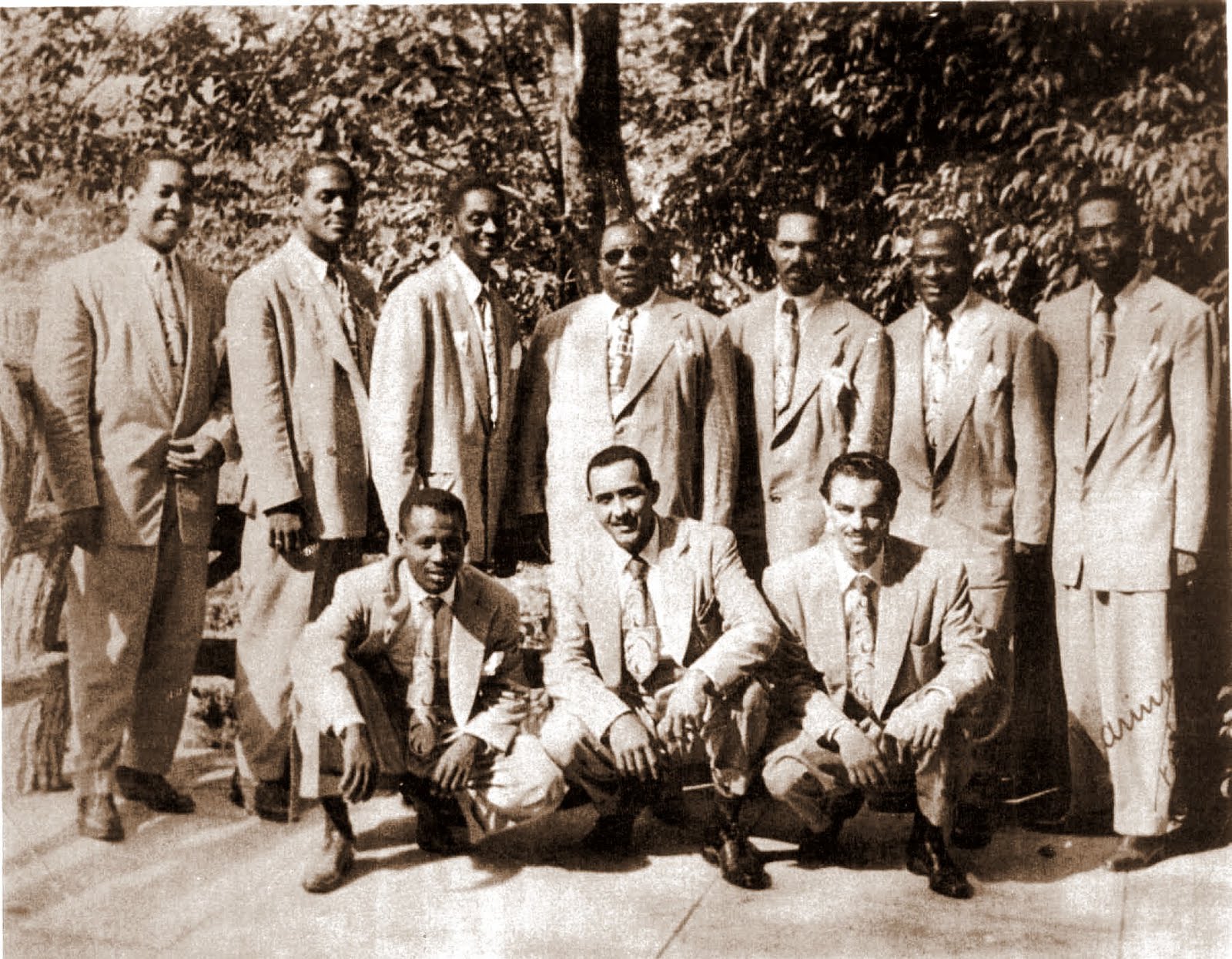 Conjunto of Arsenio Rodríguez Arsenio Rodríguez, one of Cuba's most famous tres players and conjunto leaders, emphasised the son's African roots by adapting the guaguancó style, and by adding a cowbell and conga to the rhythm section. He also expanded the role of the tres as a solo instrument.[198] In the late 1930s and 40s, the danzonera Arcaño y sus Maravillas incorporated more syncopation and added a montuno (as in son), transforming the music played by charanga orchestras.[199] The big band era The big band era arrived in Cuba in the 1940s, and became a dominant format that survives. Two great arranger-bandleaders deserve special credit for this, Armando Romeu Jr. and Damaso Perez Prado. Armando Romeu Jr. led the Tropicana Cabaret orchestra for 25 years, starting in 1941. He had experience playing with visiting American jazz groups as well as a complete mastery of Cuban forms of music. In his hands the Tropicana presented not only Afrocuban and other popular Cuban music, but also Cuban jazz and American big band compositions. Later he conducted the Orquesta Cubana de Musica Moderna.[181][200][201] Damaso Perez Prado had a number of hits, and sold more 78s than any other Latin music of the day. He took over the role of pianist/arranger for the Orquesta Casino de la Playa in 1944, and immediately began introducing new elements into its sound. The orchestra began to sound more Afrocuban, and at the same time Prado took influences from Stravinsky, Stan Kenton and elsewhere. By the time he left the orchestra in 1946 he had put together the elements of his big band mambo.:[202] "Above all, we must point out the work of Perez Prado as an arranger, or better yet, composer and arranger, and his clear influence on most other Cuban arrangers from then on."[181]p86 Benny Moré, considered by many as the greatest Cuban singer of all time, was in his heyday in the 1950s. He had an innate musicality and fluid tenor voice, which he colored and phrased with great expressivity. Although he could not read music, Moré was a master of all the genres, including son montuno, mambo, guaracha, guajira, cha cha cha, afro, canción, guaguancó, and bolero. His orchestra, the Banda Gigante, and his music, was a development – more flexible and fluid in style – of the Perez Prado orchestra, which he sang with in 1949–1950. Cuban music in the US Three great innovations based on Cuban music hit the US after World War II: the first was Cubop, the latest latin jazz fusion. In this, Mario Bauza and the Machito orchestra on the Cuban side and Dizzy Gillespie on the American side were prime movers. The rumbustious conguero Chano Pozo was also important, for he introduced jazz musicians to basic Cuban rhythms. Cuban jazz has continued to be a significant influence. The mambo first entered the United States around 1950, though ideas had been developing in Cuba and Mexico City for some time. The mambo as understood in the United States and Europe was considerably different from the danzón-mambo of Orestes "Cachao" Lopez, which was a danzon with extra syncopation in its final part. The mambo—which became internationally famous—was a big band product, the work of Perez Prado, who made some sensational recordings for RCA in their new recording studios in Mexico City in the late 1940s. About 27 of those recordings had Benny Moré as the singer, though the best sellers were mainly instrumentals. The big hits included "Que rico el mambo" (Mambo Jambo); "Mambo No. 5"; "Mambo #8"; "Cherry Pink (and Apple Blossom White)". The later (1955) hit "Patricia" was a mambo/rock fusion.[203] Mambo of the Prado kind was more a descendant of the son and the guaracha than the danzón. In the U.S. the mambo craze lasted from about 1950 to 1956, but its influence on the bugaloo and salsa that followed it was considerable.  Celia Cruz Violinist Enrique Jorrín invented the chachachá in the early 1950s. This was developed from the danzón by increased syncopation. The chachachá became more popular outside Cuba when the big bands of Perez Prado and Tito Puente produced arrangements that attracted American and European audiences.[204] Along with "Nuyoricans" Ray Barretto and Tito Puente and others, several waves of Cuban immigrants introduced their ideas into US music. Among these was Celia Cruz, a guaracha singer. Others were active in Latin jazz, such as percussionist Patato Valdés of the Cuban-oriented "Tipíca '73", linked to the Fania All-Stars. Several former members of Irakere have also become highly successful in the US, among them Paquito D'Rivera and Arturo Sandoval. Tata Güines, a famous conguero, moved to New York City in 1957, playing with jazz players such as Dizzy Gillespie, Maynard Ferguson, and Miles Davis at Birdland. As a percussionist, he performed with Josephine Baker and Frank Sinatra. He returned to Cuba in 1959 after Fidel Castro came to power in the Cuban Revolution, which he helped fund with contributions from his earnings as a musician.[205] |
多様化と大衆化 キューバ音楽のアメリカ進出 1930年、ドン・アスピアス[192]はキューバ音楽初のミリオンセラーを記録した: このナンバーは、レコーディング前にアスピアスによってオーケストレーションされ、N.Y.の劇場で演奏された。レクオーナ・キューバン・ボーイズ [194]は、キューバで最も有名なツアー・アンサンブルとなった。彼らはコンガ・ドラムを初めてコンジュントに使い、コンガをダンスとして広めた。ウォ ルドーフ・アストリアのザビエル・クガットの影響力も大きかった[195]。1941年、デシ・アルナズはババルのパフォーマンスでコンパルサ・ドラム (コンガに似ている)をアメリカに広めた。その後、マリオ・バウサとマチートがニューヨークに進出し、ミゲリート・バルデスもニューヨークに到着した [196]。 1940年代と50年代 1940年代、チャノ・ポゾ[197]はジャズにおけるビバップ革命の一翼を担い、ニューヨークでディジー・ガレスピーやマチートとコンガを演奏した。キューバン・ジャズは、それよりもずっと以前、1910年から1930年にかけてハバナで始まっていた。  アルセニオ・ロドリゲスのコンフント キューバで最も有名なトレス奏者であり、コンジュントのリーダーでもあったアルセニオ・ロドリゲスは、グアグアンコのスタイルを取り入れ、リズムセクショ ンにカウベルとコンガを加えることで、トレスのアフリカン・ルーツを強調した。彼はまた、ソロ楽器としてのトレスの役割を拡大した[198]。 1930年代後半から40年代にかけて、ダンツォネーラのアルカーニョ・イ・スス・マラビージャスはより多くのシンコペーションを取り入れ、モントゥーノ(ソンと同じ)を加えることで、チャランガ・オーケストラが演奏する音楽を一変させた[199]。 ビッグバンド時代 ビッグバンドの時代は1940年代にキューバに到来し、支配的なフォーマットとなった。アルマンド・ロメウ・ジュニアとダマソ・ペレス・プラドという2人 の偉大なアレンジャー兼バンドリーダーは、この点で特別な功績を残した。アルマンド・ロメウ・ジュニアは1941年から25年間、トロピカーナ・キャバ レーのオーケストラを率いた。彼は来日したアメリカのジャズ・グループで演奏した経験があり、キューバ音楽の形式を完全にマスターしていた。彼の指揮する トロピカーナでは、アフロキューバンをはじめとするポピュラーなキューバ音楽だけでなく、キューバン・ジャズやアメリカのビッグバンド曲も演奏された。そ の後、彼はオルケスタ・クバーナ・デ・ムジカ・モデルナを指揮した[181][200][201]。 ダマソ・ペレス・プラドは数々のヒットを飛ばし、当時のラテン音楽の中で最も多くの78枚を売り上げた。彼は1944年にカジノ・デ・ラ・プラヤ管弦楽団 のピアニスト/アレンジャーを引き継ぎ、すぐにそのサウンドに新しい要素を取り入れ始めた。オーケストラはよりアフロキューバン・サウンドになり、同時に プラドはストラヴィンスキーやスタン・ケントンなどから影響を受けた。1946年にオーケストラを去るまでに、彼はビッグバンドのマンボの要素をまとめて いた。[202] 「とりわけ、アレンジャーとしてのペレス・プラドの仕事、もっと言えば、作曲家兼アレンジャーとしての仕事と、それ以降の他のほとんどのキューバ人アレン ジャーに対する彼の明確な影響を指摘しなければならない」[181]p86 ベニー・モレは、史上最高のキューバ人歌手として多くの人に認められており、1950年代に全盛期を迎えていた。彼は生来の音楽性と流麗なテノールの声を 持っており、それを色付けし、素晴らしい表現力でフレージングした。楽譜は読めなかったが、モレはソン・モントゥーノ、マンボ、グアラチャ、グアヒーラ、 チャチャチャ、アフロ、カンシオン、グアグアンコ、ボレロなど、あらゆるジャンルの達人だった。彼のオーケストラ、バンダ・ギガンテと彼の音楽は、 1949年から1950年にかけて彼が一緒に歌っていたペレス・プラド楽団を発展させたもので、より柔軟で流動的なスタイルであった。 アメリカにおけるキューバ音楽 キューバ音楽をベースにした3つの偉大な革新が、第二次世界大戦後にアメリカで起こった。キューバ側ではマリオ・バウザとマチート楽団が、アメリカ側では ディジー・ガレスピーがその立役者だった。また、ジャズ・ミュージシャンにキューバの基本的なリズムを紹介した暴れん坊のコンゲーロ、チャノ・ポゾも重要 だった。キューバン・ジャズは今も大きな影響を与え続けている。 マンボが初めてアメリカに入ったのは1950年頃だが、キューバとメキシコ・シティでは以前からアイデアが発展していた。アメリカやヨーロッパで理解され ているマンボは、オレステス・「カチャオ」・ロペスのダンソンマンボとはかなり違っていた。国際的に有名になったマンボはビッグバンドによるもので、ペレ ス・プラドが1940年代後半にメキシコシティの新しい録音スタジオでRCAにセンセーショナルな録音を残した。そのうちの約27曲はベニー・モレがシン ガーとして参加していたが、ベストセラーは主にインストゥルメンタルだった。大ヒット曲には、「ケ・リコ・エル・マンボ」(マンボ・ジャンボ)、「マンボ 5番」、「マンボ8番」、「チェリー・ピンク(とアップル・ブロッサム・ホワイト)」などがある。後に(1955年)ヒットした「パトリシア」は、マンボ とロックのフュージョンだった[203]。プラド系のマンボは、ダンソンよりも、ソンやグアラチャの子孫である。アメリカでは、マンボの流行は1950年 頃から1956年まで続いたが、それに続くブガルーやサルサへの影響は相当なものであった。  セリア・クルス ヴァイオリニストのエンリケ・ジョリンは、1950年代初頭にチャチャチャを考案した。これはシンコペーションを増やすことでダンソンを発展させたもの だ。チャチャチャは、ペレス・プラドやティト・プエンテのビッグバンドがアメリカやヨーロッパの聴衆を魅了するアレンジを施したことで、キューバ国外でも 人気が高まった[204]。 ヌヨリカン」のレイ・バレットやティト・プエンテらとともに、キューバ移民のいくつかの波がアメリカ音楽に彼らのアイディアを持ち込んだ。その中には、グ アラチャ歌手のセリア・クルスもいた。また、ファニア・オール・スターズに連なるキューバ志向の「ティピカ'73」のパーカッショニスト、パタート・バル デスなど、ラテン・ジャズで活躍した者もいる。イラケレの元メンバーの中には、パキート・ディヴェラやアルトゥーロ・サンドヴァルなど、アメリカで大成功 を収めた者もいる。コンゲーロとして有名なタタ・グイネスは、1957年にニューヨークに移住し、バードランドでディジー・ガレスピー、メイナード・ ファーガソン、マイルス・デイヴィスといったジャズ・プレイヤーと共演した。パーカッショニストとしては、ジョセフィン・ベイカーやフランク・シナトラと 共演した。フィデル・カストロがキューバ革命で政権を握った後、彼は1959年にキューバに戻った。 |
| Mambo Main article: Mambo (music) Mambo is a musical genre and dance style that developed originally in Cuba. The word "Mambo", similarly to other afroamerican musical denominations as conga, milonga, bomba, tumba, samba, bamba, bamboula, tambo, tango, cumbé, cumbia and candombe, denote an African origin, particularly from Congo, due to the presence of certain characteristic combinations of sounds, such as mb, ng and nd, which belong to the Niger-Congo linguistic complex. The earliest roots of the Cuban Mambo can be traced to the "Danzón de Nuevo Ritmo" (Danzón with a new rhythm) made popular by the orchestra "Arcaño y sus Maravillas" conducted by famous bandleader Antonio Arcaño. He was the first to denominate a section of the popular Cuban Danzón as a "Mambo." It was Arcaño's cellist, Orestes López, who created the first Danzón called "Mambo" (1938).[206] In this piece, some syncopated motives, taken from the Son style, were combined with improvised flute passages.[207] Pianist and arranger from Matanzas, Cuba, Dámaso Pérez Prado (1927) established his residence in Havana at the beginning of the 1940s and began to work at night clubs and orchestras, such as Paulina Alvarez's and Casino de La Playa. In 1949 he traveled to Mexico looking for job opportunities and achieved great success with a new style, to which he assigns a name that had been already utilized by Antonio Arcaño, the "Mambo."[208] Perez Prado's style differed from the previous "Mambo" concept. The new style possessed a greater influence from the North-American Jazz band music, and an expanded instrumentation consisting of four or five trumpets, four of five saxophones, double bass, drum set, maracas, cowbell, congas and bongoes. The new "Mambo" included a catchy counterpoint between the trumpets and the saxophones, that impulsed the body to move along with the rhythm, stimulated at the end of each musical phrase by a characteristic deep throat sound expression.[209] Prado's recordings were meant for the Latin American and U.S. Latino markets, but some of his most celebrated mambos, such as "Mambo No. 5" and "Que Rico el Mambo", quickly crossed over to the United States.[210] |
マンボ 主な記事 マンボ(音楽) マンボは、元々はキューバで発展した音楽ジャンルであり、ダンススタイルである。マンボ」という言葉は、コンガ、ミロンガ、ボンバ、トゥンバ、サンバ、バ ンバ、バンブーラ、タンボ、タンゴ、クンベ、クンビア、カンドンベといった他のアフロアメリカ音楽の呼称と同様に、ニジェール・コンゴ語族に属するmb、 ng、ndといった特定の特徴的な音の組み合わせが存在することから、アフリカ、特にコンゴが起源であることを示す。 キューバン・マンボの最も古いルーツは、有名なバンドリーダー、アントニオ・アルカーニョが指揮するオーケストラ 「アルカーニョ・イ・ス・マラビージャス 」によって人気を博した 「新しいリズムのマンボ」(Danzón de Nuevo Ritmo)にまで遡ることができる。彼は、キューバで人気のあるダンソンの一部を 「マンボ 」と呼んだ最初の人物である。マンボ」と呼ばれる最初のダンソンを創作したのはアルカーニョのチェリスト、オレステス・ロペスであった(1938年) [206]。この作品では、ソン様式から取られたいくつかのシンコペーションのモチーフが、即興的なフルートのパッセージと組み合わされている [207]。 キューバのマタンサス出身のピアニストでアレンジャーのダマソ・ペレス・プラド(1927)は、1940年代の初めにハバナに居を構え、パウリナ・アルバ レスやカジノ・デ・ラ・プラヤなどのナイトクラブやオーケストラで働き始めた。1949年、彼は仕事の機会を求めてメキシコに渡り、アントニオ・アルカー ニョがすでに使っていた「マンボ」という名前を付けた新しいスタイルで大成功を収めた[208]。 ペレス・プラードのスタイルは、以前の「マンボ」のコンセプトとは異なっていた。新しいスタイルは、北アメリカのジャズバンド音楽の影響をより大きく受 け、4、5本のトランペット、4、5本のサクソフォン、コントラバス、ドラムセット、マラカス、カウベル、コンガ、ボンゴからなる楽器編成を拡大した。新 しい 「マンボ 」には、トランペットとサクソフォンの間のキャッチーな対位法が含まれており、リズムに合わせて身体を動かすよう促し、各音楽フレーズの終わりには特徴的 な深い喉の音の表現によって刺激された[209]。 プラドの録音はラテンアメリカとアメリカのラテン市場向けのものだったが、「マンボNo.5」や「ケ・リコ・エル・マンボ」のような彼の最も有名なマンボのいくつかは、すぐにアメリカに渡った[210]。 |
| Chachachá Main article: Cha-cha-chá (music) Cha-Cha rhythm.[211] Chachachá is a genre of Cuban music. It has been a popular dance music which developed from the Danzón-mambo in the early 1950s, and became widely popular throughout the entire world. Chachachávis a Cuban music genre whose creation has been traditionally attributed to Cuban composer and violinist Enrique Jorrín, which began his career playing for the charanga band Orquesta América.[212] According to the testimony of Enrique Jorrín, he composed some "Danzones" in which the musician of the orchestra had to sing short refrains, and this style was very successful. In the Danzón "Constancia" he introduced some montunos and the audience was motivated to join in singing the refrains. Jorrín also asked the members of the orchestra to sing in unison so the lyrics may be heard more clearly and achieve a greater impact in the audience. That way of singing also helped to mask the poor singing skills of the orchestra members. Since its inception, Chachachá music had a close relationship with the dancer's steps. The well-known name Chachachá came into being with the help of the dancers at the Silver Star Club in Havana. When the dance was coupled to the rhythm of the music, it became evident that the dancer's feet were making a peculiar sound as they grazed the floor on three successive beats. It was like an onomatopoeia that sounded as: Chachachá. From this peculiar sound, a music genre was born which motivated people from around the world to dance at its catchy rhythm.[213] Typical piano accompaniment to a cha-cha-chá (Orovio 1981:132) According to Olavo ALén: "During the 1950s, Chachachá maintained its popularity thanks to the efforts of many Cuban composers who were familiar with the technique of composing danzones and who unleashed their creativity on the Chachachá", such as Rosendo Ruiz, Jr. ("Los Marcianos" and "Rico Vacilón"), Félix Reina ("Dime Chinita," "Como Bailan Cha-cha-chá los Mexicanos"), Richard Egűes ("El Bodeguero" and "La Cantina") and Rafael Lay ("Cero Codazos, Cero Cabezazos").[214] The Chachachá was first presented to the public through the instrumental medium of the charanga, a typical Cuban dance band format made up of a flute, strings, piano, bass and percussion. The popularity of the Chachachá also revived the popularity of this kind of orchestra.[215] |
チャチャチャ 主な記事 チャチャチャ(音楽) チャチャチャのリズム[211]。 チャチャチャはキューバ音楽の一ジャンルである。1950年代初頭にダンソンマンボから発展したポピュラーなダンス音楽であり、全世界で広く親しまれている。 チャチャチャビスはキューバ音楽のジャンルで、その創始者は伝統的にキューバの作曲家兼ヴァイオリニストのエンリケ・ジョリンとされており、彼はチャランガ・バンドのオルケスタ・アメリカで演奏することからキャリアをスタートさせた[212]。 エンリケ・ジョリンの証言によると、彼はオーケストラのミュージシャンが短いリフレインを歌う「ダンツォーネ」をいくつか作曲し、このスタイルは非常に成 功した。Constancia "では、彼はモントゥーノを導入し、聴衆もリフレインを歌うように仕向けた。また、ジョリンはオーケストラのメンバーにもユニゾンで歌うように指示し、歌 詞をよりはっきりと聴かせ、聴衆に大きなインパクトを与えた。その歌い方は、オーケストラメンバーの歌唱力の低さを隠すのにも役立った。 チャチャチャの音楽は、その誕生以来、ダンサーのステップと密接な関係にあった。チャチャチャというよく知られた名前は、ハバナのシルバースター・クラブ のダンサーたちの助けによって生まれた。音楽のリズムに合わせて踊ると、ダンサーの足が3拍続けて床をかすめるような独特の音を立てていることがわかっ た。それはまるで擬音のように聞こえた: チャチャチャ」である。この独特の音から、世界中の人々をそのキャッチーなリズムで踊る気にさせる音楽ジャンルが生まれた[213]。 チャチャチャの典型的なピアノ伴奏(Orovio 1981:132) オラボ・アレンによれば、「1950年代、チャチャチャの人気を維持できたのは、ダンツォーネの作曲技法に精通し、チャチャチャに創造性を発揮した多くの キューバ人作曲家の努力のおかげである」。(ロス・マルシアノス「、」リコ・バチロン「)、フェリックス・レイナ(」ディメ・チニータ「、」コモ・バイラ ン・チャチャ・ロス・メキシカノス「)、リチャード・エギュエス(」エル・ボデゲーロ「、」ラ・カンティーナ「)、ラファエル・レイ(」セロ・コダソス、 セロ・カベサソス")などである[214]。 チャチャチャは、フルート、弦楽器、ピアノ、ベース、パーカッションで構成される典型的なキューバのダンス・バンドであるチャランガという楽器を媒介として初めて大衆に披露された。チャチャチャの人気は、この種のオーケストラの人気も復活させた[215]。 |
| Filin This section needs additional citations for verification. Please help improve this article by adding citations to reliable sources in this section. Unsourced material may be challenged and removed. (October 2018) (Learn how and when to remove this message) Main article: Filin (music) Filin was a Cuban fashion of the 1940s and 1950s, influenced by popular music in the US. The word is derived from feeling. It describes a style of post-microphone jazz-influenced romantic song (crooning).[216] Its Cuban roots were in the bolero and the canción. Some Cuban quartets, such as Cuarteto d'Aida and Los Zafiros, modelled themselves on U.S. close-harmony groups. Others were singers who had heard Ella Fitzgerald, Sarah Vaughan and Nat King Cole. A house in Havana, where the trovador Tirso Díaz lived, became a meeting-place for singers and musicians interested in filin such as: Luis Yañez, César Portillo de la Luz, José Antonio Méndez, Niño Rivera, José Antonio Ñico Rojas, Elena Burke, Froilán, Aida Diestro and Frank Emilio Flynn. Here lyricists and singers could meet arrangers, such as Bebo Valdés, El Niño Rivera (Andrés Hechavarria), Peruchín (Pedro Justiz), and get help to develop their work. Filin singers included César Portillo de la Luz, José Antonio Méndez, who spent a decade in Mexico from 1949 to 1959, Frank Domínguez, the blind pianist Frank Emilio Flynn, and the great singers of boleros Elena Burke and the still-performing Omara Portuondo, who both came from the Cuarteto d'Aida. The filin movement originally had a place every afternoon on Radio Mil Diez. Some of its most prominent singers, such as Pablo Milanés, took up the banner of the Nueva Trova at a later time. |
フィリン このセクションの検証には追加の引用が必要である。このセクションに信頼できる情報源への引用を追加することで、この記事の改善にご協力いただきたい。 ソースのないものは異議申し立てされ、削除される可能性がある。(2018年10月)(このメッセージを削除する方法とタイミングを学ぶ) 主な記事 フィリン(音楽) フィリンは1940年代と1950年代のキューバのファッションで、アメリカのポピュラー音楽の影響を受けた。語源はフィーリングである。そのルーツはボ レロとカンシオンにある。クアルテート・ダイーダやロス・ザフィロスといったキューバのカルテットは、アメリカのクローズ・ハーモニー・グループを手本に していた。また、エラ・フィッツジェラルドやサラ・ヴォーン、ナット・キング・コールを聴いたことのある歌手もいた。トロバドールのティルソ・ディアスが 住んでいたハバナの家は、フィリンに興味を持つ歌手やミュージシャンたちの集いの場となった: ルイス・ヤニェス、セサル・ポルティージョ・デ・ラ・ルス、ホセ・アントニオ・メンデス、ニーニョ・リベラ、ホセ・アントニオ・ニコ・ロハス、エレナ・ バーク、フロイラン、アイーダ・ディエストロ、フランク・エミリオ・フリンなどである。ここで作詞家や歌手たちは、ベボ・バルデス、エル・ニーニョ・リベ ラ(アンドレス・ヘチャバリア)、ペルチン(ペドロ・ユスティス)などのアレンジャーと出会い、作品を発展させる助けを得ることができた。フィリン歌手に は、セザール・ポルティージョ・デ・ラ・ルス、1949年から1959年までの10年間をメキシコで過ごしたホセ・アントニオ・メンデス、フランク・ドミ ンゲス、盲目のピアニスト、フランク・エミリオ・フリン、ボレロスの大歌手エレナ・バークと現在も演奏活動を続けるオマーラ・ポルトゥオンド(ともにクア ルテート・ダイーダ出身)などがいる。フィリン・ムーブメントは、もともとラジオ・ミル・ディエスで毎日午後に放送されていた。パブロ・ミラネスのような 最も著名な歌手の何人かは、後にヌエバ・トロバの旗を掲げた。 |
| 1960s and 70s This section needs additional citations for verification. Please help improve this article by adding citations to reliable sources in this section. Unsourced material may be challenged and removed. (October 2018) (Learn how and when to remove this message) Modern Cuban music is known for its relentless mixing of genres. For example, the 1970s saw Los Irakere use batá in a big band setting; this became known as son-batá or batá-rock. Later artists created the mozambique, which mixed conga and mambo, and batá-rumba, which mixed rumba and batá drum music. Mixtures including elements of hip hop, jazz and rock and roll are also common, like in Habana Abierta's rockoson. Revolutionary Cuba and Cuban exiles Tropicana stage The triumph of the Cuban Revolution in 1959 signalled the emigration of many musicians to Puerto Rico, Florida and New York, and in Cuba artists and their work came under the protection (and control) of the Socialist state, and the monopoly state-owned recording company EGREM. The Castro government abolished copyright laws in Cuba, closed many of the venues where popular music used to be played (e.g. night clubs), and so indirectly threw many musicians out of work.[181]p202 This undoubtedly had deleterious effects on the evolution of popular music and dance.[217] Pianist Bebo Valdés Many young musicians now studied classical music and not popular music. All musicians employed by the state were given academic courses in music. In Cuba, the Nueva Trova movement (including Pablo Milanés) reflected the new leftist ideals. The state took over the lucrative Tropicana Club, which continued as a popular attraction for foreign tourists until 1968, when it was closed along with many other music venues (and later reopened with the rebirth of tourism).[181] p202 Tourism was almost non-existent for three decades. Traditional Cuban music could be found in local Casas de la Trova. Musicians, if in work, were full-time and paid by the state after graduating from a conservatory. The collapse of the USSR in 1991, and the loss of its support for Cuba changed the situation quite a bit. Tourism became respectable again, and so did popular music for their entertainment. Musicians were even allowed to tour abroad and earn a living outside the state-run system. Famous artists from the Cuban exile include Celia Cruz and the whole conjunto she sang with, the Sonora Matancera. 'Patato' (Carlos Valdes), Cachao, La Lupe, Arturo Sandoval, Willy Chirino, Hansel y Raul, La Palabra, Paquito D'Rivera, Bebo Valdés and Gloria Estefan are some others. Many of these musicians, especially Cruz, became closely associated with the anti-revolutionary movement, and as 'unpersons'[218] have been omitted from the standard Cuban reference books, and their subsequent musical recordings are never on sale in Cuba.[219] Salsa Main article: Salsa music Rubén Blades Salsa was the fourth innovation based on Cuban music to hit the US, and differed in that it was initially developed in the US, not in Cuba. Because Cuba has so many indigenous types of music there has always been a problem in marketing the 'product' abroad to people who did not understand the differences between rhythms that, to a Cuban, are quite distinct. So, twice in the 20th century, a kind of product label was developed to solve this problem. The first occasion was in the 1930s after "The Peanut Vendor" became an international success. It was called a 'rumba' even though it really had nothing to do with genuine rumba: the number was obviously a son pregon. The label 'rumba' was used outside Cuba for years as a catch-all for Cuban popular music.[220] Musicians at the Hotel Nacional, Havana. October 2002 The second occasion happened during the period 1965–1975 in New York City, as musicians of Cuban and Puerto-Rican origin combined to produce the great music of the post Cha-cha-cha period. This music acquired the label of 'salsa'. No-one really knows how this happened, but everyone recognised what a benefit it was to have a common label for son, mambo, guaracha, guajira, guaguancó, etc. Cubans and non Cubans, such as Tito Puente, Rubén Blades and many experts of the Cuban music and salsa have always said "Salsa is just another name for Cuban, music. Tito Puentes once said, now they call it Salsa, later they may call it Stir Fry, but to me it will alway be Cuban Music"; but over time salsa bands worked in other influences. For example, in the late 1960s Willie Colón developed numbers that made use of Brazilian rhythms. New York radio programmes offered 'salsarengue' as a further combination. You look at a band of the 1940s playing Cuban music and you will see the same exact instruments in Salsa Music. Later still 'Salsa romantica' was the label for an especially sugary type of bolero. Even when, Benny Moré, Perez Prado the greatest Sonero that ever existed, was singing Boleros with a salsa cadence in the 1940s. It was not until the 1950s that Cuban music became popular for Puerto Rican bands. Plena, Bomba and other styles or music were popular at the time in Puerto Rico. Many famous Puerto Rican musicians went to learn the music styles of Cubans in the 1930s and 1940s, and it was not until the arrival of Castro in 1959 and the Cuban music stopped its exportation to the world, that Puerto Ricans in New York were able to be greatly noticed, but what is known as Salsa today, was brought to New York in the 1920s and 1930s by Dizzy Gillespie and Chano Pozo,[221][222] this last one was discovered by Dizzy Gillespie as he was one of the greatest percussionist that ever lived.[223][224][225] The question of whether or not salsa is anything more than Cuban music has been argued over for more than thirty years. Initially, not much difference could be seen. Later it became clear that not only was New York salsa different from popular music in Cuba, but salsa in Venezuela, Colombia and other countries could also be distinguished. It also seems clear that salsa has receded from the great position it achieved in the late 1970s. The reasons for this are also much disputed.[226] Nueva Trova Main articles: Nueva trova and Trova A local musical house, Casa de la Trova, at Santiago de Cuba Paralleling nueva canción in Latin America is the Cuban Nueva trova, which dates from about 1967/68, after the Cuban Revolution. It differed from the traditional trova, not because the musicians were younger, but because the content was, in the widest sense, political. Nueva trova is defined by its connection with Castro's revolution, and by its lyrics, which attempt to escape the banalities of life by concentrating on socialism, injustice, sexism, colonialism, racism and similar issues.[227] Silvio Rodríguez and Pablo Milanés became the most important exponents of this style. Carlos Puebla and Joseíto Fernández were long-time old trova singers who added their weight to the new regime, but of the two only Puebla wrote special pro-revolution songs. Nueva trova had its heyday in the 1970s, but was already declining before the fall of the Soviet Union. Examples of non-political styles in the nueva trova movement can be found, for example, Liuba María Hevia whose lyrics are focused on more traditional subjects such as love and solitude, sharing with the rest a highly poetical style. On the other side of the spectrum, Carlos Varela is famous in Cuba for his open criticism of some aspects of Castro's revolution. The nueva trova, initially so popular, suffered both inside Cuba, perhaps from a growing disenchantment with one-party rule, and externally, from the vivid contrast with the Buena Vista Social Club film and recordings. Audiences round the world have had their eyes opened to the extraordinary charm and musical quality of the older forms of Cuban music. By contrast, topical themes that seemed so relevant in the 1960s and 1970s now seem dry and passé. Even "Guantanamera" has been damaged by over-repetition in less skilled hands. All the same, those pieces of high musical and lyrical quality, among which Puebla's "Hasta siempre, Comandante" stands out, will probably last as long as Cuba lasts.[228] |
1960年代と70年代 このセクションの検証には追加の引用が必要である。このセクションに信頼できる情報源への引用を追加することで、この記事の改善にご協力いただきたい。 ソースのないものは異議申し立てされ、削除される可能性がある。(2018年10月)(このメッセージを削除する方法とタイミングを学ぶ) 現代のキューバ音楽は、ジャンルを容赦なくミックスすることで知られている。例えば、1970年代にはロス・イラケレがビッグバンドでバタを使用し、これ はソンバタまたはバタロックとして知られるようになった。その後のアーティストたちは、コンガとマンボをミックスしたモザンビークや、ルンバとバタ・ドラ ム音楽をミックスしたバタ・ルンバを生み出した。ヒップホップ、ジャズ、ロックンロールの要素を含むミックスも、ハバナ・アビエルタのロコソンのようによ く見られる。 キューバ革命とキューバ亡命者たち トロピカーナのステージ 1959年のキューバ革命の勝利は、多くのミュージシャンがプエルトリコ、フロリダ、ニューヨークに移住することを意味し、キューバではアーティストとそ の作品は社会主義国家と独占的な国営レコード会社EGREMの保護(と管理)の下に置かれるようになった。カストロ政権はキューバの著作権法を廃止し、ポ ピュラー音楽が演奏されていた多くの場所(ナイトクラブなど)を閉鎖したため、間接的に多くのミュージシャンが仕事を失った[181]。 ピアニストのベボ・バルデス 多くの若い音楽家は、ポピュラー音楽ではなくクラシック音楽を学ぶようになった。国家に雇用されたすべての音楽家は、音楽のアカデミック・コースを与えら れた。キューバでは、パブロ・ミラネスを含むヌエバ・トローバ運動が新しい左翼の理想を反映した。トロピカーナ・クラブは、1968年に他の多くの音楽施 設とともに閉鎖されるまで、外国人観光客に人気のアトラクションとして存続した(後に観光業の復興とともに再開)[181] p202 30年間、観光業はほとんど存在しなかった。伝統的なキューバ音楽は、地元のカサ・デ・ラ・トローバで聴くことができた。音楽家は、音楽院を卒業すると、 フルタイムで国から給料をもらうことができた。1991年にソ連が崩壊し、キューバへの支援を失ったことで、状況は大きく変わった。観光業が再び立派にな り、娯楽としてのポピュラー音楽も生まれた。ミュージシャンたちは海外ツアーを行い、国営以外の場所で生計を立てることさえ許された。 キューバ亡命者の有名なアーティストには、セリア・クルスと彼女が一緒に歌ったソノラ・マタンセラというコンジュントがいる。パタート」(カルロス・バル デス)、カチャオ、ラ・ルーペ、アルトゥーロ・サンドバル、ウィリー・チリーノ、ハンセル・イ・ラウル、ラ・パラブラ、パキート・ディベラ、ベボ・バルデ ス、グロリア・エステファンなどがいる。これらのミュージシャンの多く、特にクルスは、反革命運動と密接に関わるようになり、「不人気者」[218]とし て、キューバの標準的な参考書からは省かれており、彼らのその後の音楽録音はキューバでは販売されていない[219]。 サルサ 主な記事 サルサ音楽 ルベン・ブラデス サルサは、キューバ音楽に基づく4番目の革新的な音楽としてアメリカでヒットしたが、キューバではなくアメリカで最初に開発されたという点で異なってい た。キューバには非常に多くの土着音楽があるため、キューバ人にとってはまったく異なるリズムの違いを理解しない人々に対して、海外で「製品」を売り込む には常に問題があった。そこで、20世紀に2度、この問題を解決するために商品ラベルのようなものが開発された。最初の機会は、『ピーナッツ売り』が世界 的な成功を収めた後の1930年代だった。この曲は「ルンバ」と呼ばれたが、実際には本物のルンバとは何の関係もなかった。ルンバ」というレッテルは、 キューバのポピュラー音楽の総称として何年もキューバ国外で使われていた[220]。 ハバナ、ホテル・ナシオナルでのミュージシャンたち。2002年10月 2つ目の出来事は、1965年から1975年にかけてニューヨークで起こった。キューバとプエルト・リカン出身のミュージシャンたちが組み合わさり、 チャ・チャ・チャ以降の素晴らしい音楽が生み出されたのだ。この音楽は「サルサ」というラベルを獲得した。なぜこのようなことが起こったのかは誰にもわか らないが、ソン、マンボ、グアラチャ、グアヒーラ、グアグアンコなどに対して共通のラベルを持つことがいかに有益であるかは誰もが認識していた。ティト・ プエンテ、ルベン・ブラデス、そしてキューバ音楽とサルサの専門家の多くは、キューバ人もそうでない人も、「サルサはキューバ音楽の別名に過ぎない」と常 に言ってきた。ティト・プエンテスはかつて、「今はサルサと呼ばれているが、後には炒め物と呼ばれるかもしれない。例えば、1960年代後半、ウィリー・ コロンはブラジルのリズムを使ったナンバーを開発した。ニューヨークのラジオ番組では、さらなる組み合わせとして「サルサ・レングエ」を提供していた。 1940年代にキューバ音楽を演奏していたバンドを見れば、サルサ音楽にもまったく同じ楽器が使われているのがわかるだろう。その後、「サルサ・ロマンチ カ」は、特に甘いタイプのボレロのラベルとなった。ベニー・モレ、ペレス・プラドという史上最高のソネーロが、1940年代にサルサのカデンツでボレロを 歌っていた時でさえそうだった。キューバ音楽がプエルトリコのバンドに普及したのは1950年代になってからである。プレナ、ボンバ、その他のスタイルの 音楽は、当時プエルトリコで人気があった。1930年代から1940年代にかけて、多くの有名なプエルトリコ人ミュージシャンがキューバ人の音楽スタイル を学びに行ったが、1959年にカストロが登場し、キューバ音楽が世界に輸出されなくなってから、ニューヨークのプエルトリコ人が大きく注目されるように なった、 しかし、今日サルサとして知られているものは、1920年代と1930年代にディジー・ガレスピーとチャノ・ポゾによってニューヨークにもたらされたもの であり、[221][222]この最後のものは、ディジー・ガレスピーによって発見された。 [223][224][225] サルサがキューバ音楽以上のものであるかどうかという問題は、30年以上にわたって議論されてきた。当初は、それほど大きな違いは見られなかった。その 後、ニューヨークのサルサがキューバのポピュラー音楽と異なるだけでなく、ベネズエラやコロンビアなどのサルサも区別できることが明らかになった。サルサ が1970年代後半に達成した偉大な地位から後退したことも明らかである。その理由についても、多くの議論がある[226]。 ヌエバ・トロヴァ 主な記事 ヌエバ・トロバとトロバ サンティアゴ・デ・クーバにある地元の音楽ハウス、カサ・デ・ラ・トロバ ラテンアメリカのヌエヴァ・カンシオンと類似しているのが、キューバのヌエヴァ・トロヴァで、キューバ革命後の1967/68年頃から始まった。伝統的な トローバと異なるのは、音楽家が若かったからではなく、その内容が広い意味で政治的だったからである。ヌエバ・トロバは、カストロの革命とのつながりに よって定義され、社会主義、不正義、性差別、植民地主義、人種差別やそれに類する問題に集中することで、平凡な生活から逃れようとする歌詞によって定義さ れる[227]。シルビオ・ロドリゲスとパブロ・ミラネスがこのスタイルの最も重要な表現者となった。カルロス・プエブラとホセイト・フェルナンデスは、 新体制に比重を置いた長年のオールド・トロヴァ歌手だったが、2人のうちプエブラだけが特別に革命支持の歌を書いた。 ヌエバ・トローバは1970年代に全盛期を迎えたが、ソ連崩壊前にはすでに衰退していた。例えば、リウバ・マリア・ヘビア(Liuba María Hevia)の歌詞は、愛や孤独といった伝統的な題材に重点を置いており、詩的な作風を共有している。一方、カルロス・バレラは、カストロ革命のある側面 を公然と批判したことでキューバでは有名である。 ヌエバ・トローバは、当初は非常に人気があったが、キューバ国内では、おそらく一党支配への幻滅の高まりから、また対外的には、ブエナ・ビスタ・ソシア ル・クラブの映画やレコーディングとの鮮やかなコントラストから、苦境に立たされた。世界中の聴衆は、キューバ音楽の古い形式が持つ並外れた魅力と音楽性 に目を開かされた。それとは対照的に、1960年代や1970年代にはとても適切と思われた話題性のあるテーマも、今では乾いて古臭く感じられる。グアン タナメラ」でさえ、あまり熟練していない人の手による過剰な繰り返しによって傷んでいる。とはいえ、プエブラの「Hasta siempre, Comandante」のような、音楽的にも叙情的にも質の高い作品は、キューバが存続する限り続くだろう[228]。 |
| 1980s to the present This section needs additional citations for verification. Please help improve this article by adding citations to reliable sources in this section. Unsourced material may be challenged and removed. (October 2018) (Learn how and when to remove this message) Son remains the basis of most popular forms of modern Cuban music. Son is represented by long-standing groups like Septeto Nacional, which was re-established in 1985, Orquesta Aragón, Orquesta Ritmo Oriental and Orquesta Original de Manzanillo. Sierra Maestra, is famous for having sparked a revival in traditional son in the 1980s. Nueva trova still has influence, but the overtly political themes of the 1960s are well out of fashion. Meanwhile, Irakere fused traditional Cuban music with jazz, and groups like NG La Banda, Orishas and Son 14 continued to add new elements to son, especially hip hop and funk, to form timba music; this process was aided by the acquisition of imported electronic equipment. There are still many practitioners of traditional son montuno, such as Eliades Ochoa, who have recorded and toured widely as a result of interest in the son montuno after the Buena Vista Social Club success. Europe-based Cuban female singer-songwriter Addys Mercedes merged her roots of Son and Filin with elements of urban, rock and pop-music, reaching mainstream airplay charts in Germany.[229] In the 1990s, increased interest in world music coincided with the post-Soviet Union periodo especial in Cuba, during which the economy began opening up to tourism. Orquesta Aragón, Charanga Habanera and Cándido Fabré y su Banda have been long-time players in the charanga scene, and helped form the popular timba scene of the late 1990s. The biggest award in modern Cuban music is the Beny Moré Award. Timba Main article: Timba Cubans have never been content to hear their music described as salsa, even though it is crystal clear that this was a label for their music. Since the early 1990s Timba has been used to describe popular dance music in Cuba, rivaled only lately by Reggaetón. Though derived from the same roots as salsa, Timba has its own characteristics, and is intimately tied to the life and culture of Cuba, and especially Havana. As opposed to salsa, whose roots are strictly from Son and the Cuban conjunto bands of the 1940s and 1950s, Timba represents a synthesis of many folkloric (rumba, guaguancó, batá drumming and the sacred songs of santería.[230]), and popular sources (even taking inspiration from non Afro Cuban musical genres such as rock, jazz and funk). According to Vincenzo Perna, author of Timba: The Sound of the Cuban Crisis, timba needs to be spoken of because of its musical, cultural, social, and political reasons; its sheer popularity in Cuba, its novelty and originality as a musical style, the skill of its practitioners, its relationship with both local traditions and the culture of the black Diaspora, its meanings, and the way its style brings to light the tension points within society.[231] In addition to timbales, timba drummers make use of the drum-set, further distinguishing the sound from that of mainland salsa. The use of synthesised keyboard is also common. Timba songs tend to sound more innovative, experimental and frequently more virtuosic than salsa pieces; horn parts are usually fast, at times even bebop influenced, and stretch to the extreme ranges of all instruments. Bass and percussion patterns are similarly unconventional. Improvisation is commonplace. Revival projects Main articles: Afro-Cuban All Stars and Buena Vista Social Club Cuban bandleader and musician Juan de Marcos González Several projects gained international attention in the 1990s due to their revival of traditional music styles such as the son cubano of the septeto and the conjunto era. Founded in 1976, Sierra Maestra (band) was one of the first revivalist groups in Cuba. In 1995, Juan de Marcos González, director and tres player of Sierra Maestra, was contacted by Nick Gold (head of World Circuit Records) to record a traditional Cuban album featuring African musicians. In the end, the African musicians could not make it to Havana, so the project became a 100% Cuban affair featuring veteran Cuban musicians such as Rubén González, Ibrahim Ferrer, Compay Segundo and Omara Portuondo. It spawned two bands, both of which involved American guitarist Ry Cooder: Afro-Cuban All Stars and Buena Vista Social Club. Both bands recorded their debut albums, A Toda Cuba le Gusta and Buena Vista Social Club, respectively, in March 1996. The release of the latter in September 1997 was a true watershed event. The album became a worldwide hit, selling millions of copies and turning established musicians into globally renowned figures. Guitarist Eliades Ochoa Buena Vista resulted in several follow-up recordings and spawned a film of the same name, as well as tremendous interest in other Cuban groups. In subsequent years, dozens of singers and conjuntos made recordings for foreign labels and toured internationally. The conclusion some have drawn is that the wholesale closure of popular music venues (after the revolution), which threw many musicians out of work, and subsequent control by state committees, damaged the development of Cuban popular music.[181][217] Hip hop Hip hop grew steadily more popular in Cuba in the 1980s and 1990s through Cuba's Special Period.[232] After the collapse of the Soviet Union, the Cuban economy went into decline. Poverty became more widespread and visible in Cuba. In the 1990s, some Cubans started to protest this situation by means of rap and hip-hop. During this period of economic crisis, which the country's poor and black populations especially hard, hip hop became a way for the country's Afro-descended population to embrace their blackness and articulate a demand for racial equality for black people in Cuba.[233] The idea of blackness and black liberation was not always compatible with the goals of the Cuban government, which was still operating under the idea that a raceless society was the correct realization of the Cuban Revolution. When hip-hop emerged, the Cuban government opposed the vulgar image that rappers portrayed, but later accepted that it might be better to have hip-hop under the influence of the Ministry of Culture as an authentic expression of Cuban Culture.[234] Rap music in Cuba is heavily influenced by the country's pre-existing musical traditions, such as salsa and rumba.[234] In some ways, hip hop is tolerated by the government of Cuba and performers are provided with venues and equipment by the government.[235] The Cuban rap and hip-hop scene sought out the involvement of the Ministry of Culture in the production and promotion of their music, which would otherwise have been impossible to accomplish.[citation needed] After the Cuban government provided lukewarm endorsement, the Cuban Rap Agency provided the Cuban rap scene, in 2002, with a state-sponsored record label, magazine, and Cuba's own hip-hop festival.[234] The government gives rap and hip-hop groups time on mass media outlets in return for hip-hop artists limiting self-expression and presenting the government in a positive way.[236] Rappers who explicitly speak about race or racism in Cuba are still under scrutiny by the government.[237] The government recognizes that hip-hop is growing in Cuba, and would be difficult to eliminate.[citation needed] Cubatón Main article: Cubatón Like Spanish reggae from Panama is a new genre for the Cubans but by 2012 was so massively popular that "the face of Cuban pop music" was considered to be Cuban reggae (cubatón) singer, Osmani García "La Voz".[238] The advent of web software helped to distribute music unofficially. Both lyrics and dance movements have been criticised. Reggaeton musicians such as responded by making songs that defended their music. Despite their efforts, the Ministry of Culture has ruled that reggaeton is not to be used in teaching institutions, parties and at discos,[239] and in 2011 restricted its airplay after massive popularity of García's "Chupi Chupi", which referred to oral sex. Other popular cubatón artists include Eddy K and Gente de Zona ("People from the 'Hood"). |
1980年代から現在まで このセクションの検証には追加の引用が必要である。このセクションに信頼できる情報源への引用を追加することで、この記事の改善にご協力いただきたい。 ソースのないものは異議申し立てされ、削除される可能性がある。(2018年10月)(このメッセージを削除する方法とタイミングを学ぶ) ソンは、現代キューバ音楽のほとんどのポピュラーな形態の基礎であり続けている。ソンは、1985年に再結成されたセプテート・ナシオナル、オルケスタ・ アラゴン、オルケスタ・リトモ・オリエンタル、オルケスタ・オリジナル・デ・マンサニージョといった古くからのグループに代表される。シエラ・マエストラ は、1980年代に伝統的な息子のリバイバルの火付け役となったことで有名だ。ヌエバ・トロバはまだ影響力を持っているが、1960年代のあからさまに政 治的なテーマはすっかり廃れている。一方、イラケレは伝統的なキューバ音楽とジャズを融合させ、NGラ・バンダ、オリシャス、ソン14などのグループは、 ソンに新しい要素、特にヒップホップやファンクを加え、ティンバ音楽を形成し続けた。ブエナ・ビスタ・ソシアル・クラブの成功の後、ソンモンチュノへの関 心が高まった結果、レコーディングやツアーを広く行うようになったエリアデス・オチョアなど、伝統的なソンモンチュノを実践する人たちはまだたくさんい る。ヨーロッパを拠点に活動するキューバの女性シンガーソングライター、アディス・メルセデスは、彼女のルーツであるソンとフィリンをアーバン、ロック、 ポップミュージックの要素と融合させ、ドイツではメインストリームのエアプレイチャートにランクインした[229]。 1990年代、ワールド・ミュージックへの関心が高まったのは、ソビエト連邦崩壊後のキューバにおける特別な時代と重なる。オルケスタ・アラゴン、チャラ ンガ・ハバネラ、カーンディド・ファブレ・イ・ス・バンダは、チャランガ・シーンで長く活躍し、1990年代後半のポピュラーなティンバ・シーンの形成に 貢献した。現代キューバ音楽における最大の賞は、ベニー・モレ賞である。 ティンバ 主な記事 ティンバ キューバ人は、自分たちの音楽がサルサと形容されることに決して満足していない。1990年代初頭から、ティンバはキューバのポピュラー・ダンス・ミュー ジックを表すのに使われるようになり、最近ではレゲトンと肩を並べるまでになった。サルサと同じルーツに由来するとはいえ、ティンバには独自の特徴があ り、キューバ、特にハバナの生活や文化と密接に結びついている。 サルサがソンや1940~50年代のキューバのコンジュント・バンドをルーツとしているのとは対照的に、ティンバは多くの民俗的なもの(ルンバ、グアガン コ、バタ・ドラム、サンテリアの神聖な歌[230])やポピュラーなもの(ロック、ジャズ、ファンクといったアフロ・キューバン・ミュージック以外のジャ ンルからもインスピレーションを得ている)を統合したものである。ティンバの著者であるヴィンチェンツォ・ペルナによれば、「キューバ危機の音」である: ティンバが語られるべき理由は、その音楽的、文化的、社会的、政治的な理由にある。キューバでの人気の高さ、音楽スタイルとしての斬新さと独創性、練習者 の技術、地元の伝統と黒人ディアスポラ文化の両方との関係、その意味、そしてそのスタイルが社会内の緊張点を浮き彫りにする方法などである[231]。 ティンバのドラマーはティンバレスに加え、ドラムセットを使用し、本土のサルサのサウンドとはさらに異なる。シンセサイザーによるキーボードの使用も一般 的である。ホーン・パートは通常速く、時にはビバップの影響を受け、すべての楽器の極端な音域まで伸びる。ベースとパーカッションのパターンも同様に型破 りだ。即興演奏は当たり前である。 リバイバル・プロジェクト 主なもの アフロ・キューバン・オール・スターズとブエナ・ビスタ・ソシアル・クラブ キューバのバンドリーダー兼ミュージシャン、フアン・デ・マルコス・ゴンサレス 1990年代、セプテートやコンジュント時代のソン・クバーノなど、伝統的な音楽スタイルを復活させたいくつかのプロジェクトが国際的な注目を集めた。 1976年に結成されたシエラ・マエストラ(バンド)は、キューバにおける最初のリバイバル・グループのひとつだった。1995年、シエラ・マエストラの ディレクター兼トレス奏者であるフアン・デ・マルコス・ゴンサレスは、ニック・ゴールド(ワールド・サーキット・レコードの代表)から、アフリカ人ミュー ジシャンをフィーチャーしたキューバの伝統的なアルバムを録音するよう依頼された。結局、アフリカのミュージシャンはハバナに来ることができなかったた め、ルベン・ゴンサレス、イブラヒム・フェレール、コンパイ・セグンド、オマーラ・ポルトゥオンドといったベテラン・キューバ人ミュージシャンをフィー チャーした100%キューバのプロジェクトとなった。その結果、アメリカ人ギタリストのライ・クーダーが参加した2つのバンドが誕生した: アフロ・キューバン・オール・スターズとブエナ・ビスタ・ソシアル・クラブだ。両バンドはそれぞれ1996年3月にデビューアルバム『A Toda Cuba le Gusta』と『Buena Vista Social Club』をレコーディングした。後者の1997年9月のリリースは、まさに分水嶺となる出来事だった。このアルバムは世界的なヒットとなり、何百万枚も のセールスを記録し、既成のミュージシャンを世界的に有名な人物に変えた。 ギタリスト、エリアデス・オチョア 『ブエナ・ビスタ』は、いくつかの後続レコーディングを生み出し、同名の映画を生み、他のキューバ人グループにも多大な関心をもたらした。その後、何十人もの歌手やコンジュントが海外のレーベルからレコーディングを行い、国際的なツアーを行った。 革命後)多くのミュージシャンを失業させたポピュラー音楽場の全面的な閉鎖と、その後の国家委員会による統制が、キューバのポピュラー音楽の発展にダメージを与えたという結論もある[181][217]。 ヒップホップ ソビエト連邦崩壊後、キューバ経済は衰退した。キューバでは貧困が蔓延し、目に見えるようになった。1990年代、一部のキューバ人はラップやヒップホッ プによってこの状況に抗議し始めた。この経済危機の時期、キューバの貧困層と黒人が特に苦境に立たされる中、ヒップホップはキューバのアフロ系住民が自分 たちの黒人性を受け入れ、キューバの黒人の人種的平等を求める要求を明確にする方法となった[233]。黒人性と黒人解放の考えは、キューバ革命の正しい 実現が人種差別のない社会であるという考えの下で動いていたキューバ政府の目標と必ずしも両立するものではなかった。ヒップホップが出現したとき、キュー バ政府はラッパーが描く低俗なイメージに反対したが、後にヒップホップがキューバ文化の正統な表現として文化省の影響下にある方が良いかもしれないと受け 入れた[234]。キューバのラップミュージックは、サルサやルンバといったキューバに以前から存在する音楽の伝統に大きな影響を受けている[234]。 ある意味で、ヒップホップはキューバ政府によって容認されており、パフォーマーたちは政府によって会場や機材を提供されている[235]。 キューバのラップやヒップホップ・シーンは、そうでなければ達成することが不可能であった、自分たちの音楽の制作やプロモーションにおける文化省の関与を 求めた[要出典]。 キューバ政府が生ぬるいお墨付きを与えた後、キューバ・ラップ・エージェンシーは2002年に、キューバのラップ・シーンに、国が後援するレコード・レー ベル、雑誌、キューバ独自のヒップホップ・フェスティバルを提供した[234]。 政府は、ヒップホップ・アーティストが自己表現を制限し、政府を肯定的に紹介する見返りとして、マスメディアでラップやヒップホップ・グループに時間を与 えている[236]。 キューバにおける人種や人種差別について明確に語るラッパーは、依然として政府による監視下に置かれている[237]。 政府は、ヒップホップがキューバで成長しており、排除することは困難であると認識している[要出典]。 キューバトン(クバトン) 主な記事 クバトン パナマのスパニッシュ・レゲエと同様、キューバ人にとっては新しいジャンルだが、2012年までには「キューバのポップミュージックの顔」はキューバのレ ゲエ(クバトン)歌手、オスマニ・ガルシア 「ラ・ヴォス 」であると考えられるほど、大きな人気を博していた[238]。歌詞もダンスの動きも批判されてきた。レゲトンのミュージシャンなどは、自分たちの音楽を 擁護する曲を作ることで対抗した。彼らの努力にもかかわらず、文化省は、レゲトンを教育機関、パーティー、ディスコで使用してはならないと裁定し [239]、2011年には、オーラルセックスに言及したガルシアの「Chupi Chupi」が大流行した後、その放送を制限した。その他の人気クバトン・アーティストには、エディ・KやGente de Zona(「フードの人々」)などがいる。 |
| Rock music in Cuba This section needs additional citations for verification. Please help improve this article by adding citations to reliable sources in this section. Unsourced material may be challenged and removed. (October 2018) (Learn how and when to remove this message) Main article: Rock music in Cuba Gorki Águila, leader of the Cuban rock band Porno para Ricardo The musical interaction between Cuba and the US is ancient. Already in the 18th century, during the Spanish rule of Louisiana (1763–1803), the Havanese orchestras and bands offered concerts in New Orleans and in the 19th century the Cuan contradanza was very popular in the US. At the beginning of the 20th century, the first jazz bands were created in Cuba, in the style of the American groups. The "Sagua" Jaz Band was founded in Sagua la Grande in 1914 by Pedro Stacholy (conductor and pianist). The group played during 14 years at the Teatro Principal de Sagua.[187] The strong influence of the American music on the Cuban younger generations gave way to the beginning of the soloists and groups of rock and roll in Cuba during the 1950s. Many Cuban artists sang versions of American songs translated to Spanish, as it was also happening in Mexico.[240] The launching of the group Los LLopis represented the entrance in a new stage for the Cuban music, that of the generation and amplification of the sound by electroacoustic devices; because in the sound composition of this group one can observe a novel element of great importance, the inclusion of an electric guitar.[209] In 1961, other artists emerged such as Dany Puga, called the King of Twist, and bands such as Los Satélites, Los Diablos Melódicos and Los Enfermos del Rock, as well as Los Halcones and Los Huracanes from Marianao. The vocal quartet Los Zafiros was another successful group from the beginning of the sixties. Founded in 1961, it was influenced by the doo-wop style of The Platters, The Diamonds and other American groups, and counted on a repertoire consisting of ballads, calypsos and bossanovas, as well as songs with a slow rock ad bolero rhythms. At that time, the popular group Los Astros, led by the singer and guitarist Raúl Gómez, was threatened by pressures exerted by the Fidel Castro regime over the rock groups, which were considered as a form of "ideological diversionism" and actively opposed in all its manifesations. Its style, strongly influenced by the British Invasion groups, as the Beatles and the Rolling Stones, was labelled as "deviant" and consequently repressed without any hesitation. Since then, the Revolutionary government of Cuba began to implement an absolute control over all aspects of the Cuban society, including, of course, all cultural expressions. Around 1965, the Revolutionary government implemented a strategy to substitute the foreign products that the young people preferred, with others that better matched their official guidelines; and as a result of this strategy, a new radio program called Nocturno was broadcast in 1966, which initial musical theme was "La chica de la valija" (Girl with a suitcase) from the Italian sax player Fausto Papetti. The program presented modern songs, giving priority to the European repertoire in Spanish language of soloists and groups such as: Los Mustang, Los Bravos, Los Brincos, Juan y Junior, Rita Pavone, Massiel, Nino Bravo, Leonardo Fabio, Salvatore Adamo and Raphael, and some Cuban groups as Los Zafiros and Los Dan.[241] The ban against rock music was lifted in 1966, but rock fans continued to be marginalized by the communist establishment, and watched over with suspicion as "counter-revolutionaries".[242] Actually, rock music began to be heard in Havana during the seventies, in a radio program from Radio Marianao called Buenas Tardes Juventud. That program presented groups such as The Rolling Stones, The Beatles, Dave Clark Five, The Animals, Grand Funk, Rare Earth, Led Zeppelin, Jimi Hendrix, Elvis Presley, Neil Sedaka and Paul Anka. At the beginning of the eighties, that radio station joined Radio Ciudad de La Habana.[243] In 1979, a three-day music festival called Havana Jam took place at the Karl Marx Theater, in Havana, Cuba, where a group of rock artists that included Billy Joel and Stephen Stills performed. In the 1980s, a heavy metal band called Venus was formed by Roberto Armada in Municipio Playa. They achieved much success and created a headbanger following among the Cuban youth. Punk rock was introduced in Cuba in the late 1980s and gained a cult-type following among a minority of the youth. During the nineties, rock and roll in Cuba was still an underground phenomenon. In Havana, the "Ciudad de La Habana" radio station presented several programs showing the most recent tendencies on that type of music around the world. Juan Camacho, an old musician and radio host had a morning program called Disco Ciudad. El Programa de Ramón was also a successful radio show. Some bands from that period were Gens, Zeus and Los Tarsons. In 2001, the Welsh group Manic Street Preachers was invited to perform in Cuba,[244] and Fidel Castro attended its concert along with other government authorities. In 2004, Castro gave a speech honoring the Birthday of John Lennon, whose music, as a member of The Beatles and as a soloist, was banned in Cuba for a very long time. A bronze statue of Lennon was placed in a Havanese well known park, and it became a notoriety because of becoming a victim of constant vandalism from passers by that frequently stole its bronze spectacles. At the same time that the government was showing a more indulgent attitude toward the foreign rock groups, as part of an international campaign which purpose was to achieve an opening in the commercial transactions and investments of the US and Europe in Cuba, it continued to implement an inflexible repression against any form of internal dissidence. This was the case of the rocker Gorki Águila and his group Porno para Ricardo. In August 2008, Águila was arrested under charges of dangerousness, a law that allows the authorities to detain people whom they think are likely to commit crimes, even when they have not yet committed them.[245] More recently, Rick Wakeman, Sepultura and Audioslave performed in Havana,[246] and The Rolling Stones offered a historic concert that has become the most outstanding rock event since the beginning of the Revolutionary period in 1959.[247] A new phenomenon occurred in 2013 when several Cuban underground metal bands begin to emigrate to the United States, creating a parallel scene with the bands Agonizer, Escape, Ancestor, Hipnosis, Suffering Tool and Chlover [248] |
キューバのロック音楽 このセクションの検証には追加の引用が必要である。このセクションに信頼できる情報源への引用を追加することで、この記事の改善にご協力いただきたい。 ソースのないものは異議申し立てされ、削除される可能性がある。(2018年10月)(このメッセージを削除する方法とタイミングを学ぶ) 主な記事 キューバのロック音楽 キューバのロックバンド、ポルノ・パラ・リカルドのリーダー、ゴーリキ・アギラ キューバとアメリカの音楽交流は古い。すでに18世紀、スペインによるルイジアナ統治時代(1763~1803年)には、ハバニーズ・オーケストラや楽団 がニューオリンズでコンサートを開き、19世紀にはクアン・コントラダンザがアメリカで大人気となった。20世紀初頭、キューバで最初のジャズ・バンドが アメリカのグループのスタイルで結成された。サグア "ジャズ・バンドは、1914年にペドロ・スタチョリー(指揮者兼ピアニスト)によってサグア・ラ・グランデで結成された。このグループは14年間、サグ ア・プリンシパル劇場で演奏した[187]。 アメリカの音楽がキューバの若い世代に強い影響を与えたことで、1950年代にはキューバでロックンロールのソリストやグループが誕生した。多くのキューバのアーティストたちは、メキシコでもそうであったように、アメリカの歌をスペイン語に翻訳して歌った[240]。 ロス・ロピス(Los LLopis)というグループの登場は、キューバ音楽にとって、電気音響機器による音の生成と増幅という新たな段階への入口を意味した。 1961年には、ツイストの帝王と呼ばれたダニー・プガや、ロス・サテライテス、ロス・ディアブロス・メロディコス、ロス・エンフェルモス・デル・ロック、マリアナオのロス・ハルコネス、ロス・フラカネスなどのバンドが登場する。 ヴォーカル・カルテット、ロス・ザフィロスもまた、60年代初頭から成功を収めたグループである。1961年に結成されたこのグループは、プラターズ、ダ イアモンズ、その他のアメリカン・グループのドゥーワップ・スタイルに影響を受け、バラード、カリプソ、ボサノバ、そしてスローなロックやボレロのリズム の曲をレパートリーとしていた。 当時、歌手兼ギタリストのラウル・ゴメス率いるポピュラー・グループ、ロス・アストロスは、フィデル・カストロ政権によるロック・グループに対する圧力に 脅かされていた。ビートルズやローリング・ストーンズのようなブリティッシュ・インヴェイジョン・グループの影響を強く受けたそのスタイルは、「逸脱」の レッテルを貼られ、その結果、何のためらいもなく弾圧された。それ以来、キューバ革命政府は、キューバ社会のあらゆる側面、もちろんあらゆる文化表現も含 めて、絶対的な統制を実施し始めた。 1965年頃、革命政府は、若者たちが好む外国の製品を、彼らの公式ガイドラインにより合致する他の製品に置き換える戦略を実施した。この戦略の結果とし て、1966年にノクターノという新しいラジオ番組が放送され、その最初の音楽テーマは、イタリア人サックス奏者ファウスト・パペッティの「La chica de la valija(スーツケースを持った少女)」だった。この番組では、スペイン語のソリストやグループによるヨーロッパのレパートリーを優先し、現代的な曲 を紹介した: ロス・マスタング、ロス・ブラヴォス、ロス・ブリンコス、フアン・イ・ジュニオール、リタ・パヴォーネ、マシエル、ニーノ・ブラヴォ、レオナルド・ファビ オ、サルヴァトーレ・アダモ、ラファエル、そしてロス・ザフィロスやロス・ダンといったキューバのグループなどである[241]。ロック音楽に対する禁止 令は1966年に解除されたが、ロック・ファンは共産主義体制から疎外され続け、「反革命分子」として疑いの目を向けられた[242]。 実際、ロック音楽は70年代にラジオ・マリアナオのラジオ番組『Buenas Tardes Juventud』でハバナで聴かれるようになった。その番組では、ザ・ローリング・ストーンズ、ザ・ビートルズ、デイヴ・クラーク・ファイヴ、アニマル ズ、グランド・ファンク、レア・アース、レッド・ツェッペリン、ジミ・ヘンドリックス、エルヴィス・プレスリー、ニール・セダカ、ポール・アンカといった グループが紹介された。80年代の初め、そのラジオ局はラジオ・シウダー・デ・ラ・ハバナに加わった[243]。 1979年、キューバのハバナにあるカール・マルクス劇場でハバナ・ジャムと呼ばれる3日間の音楽祭が開催され、ビリー・ジョエルやスティーヴン・スティルスを含むロック・アーティストたちがパフォーマンスを行った。 1980年代には、ムニシピオ・プラヤでロベルト・アルマダによってヴィーナスというヘビーメタル・バンドが結成された。彼らは大きな成功を収め、キュー バの若者の間にヘドバンガーの支持者を生み出した。1980年代後半には、キューバにパンクロックが導入され、少数派の若者の間でカルト的な人気を得た。 90年代、キューバのロックンロールはまだアンダーグラウンドな現象だった。ハバナでは、ラジオ局 「Ciudad de La Habana 」が、世界中のロックンロールの最新動向を紹介する番組を放送していた。古くからのミュージシャンでラジオの司会者でもあったフアン・カマーチョは、 『ディスコ・シウダッド』という朝の番組を持っていた。El Programa de Ramón』もラジオ番組として成功した。この時代のバンドには、Gens、Zeus、Los Tarsonsなどがある。 2001年、ウェールズのグループ、マニック・ストリート・プリーチャーズがキューバに招かれパフォーマビティを行った[244]。2004年、カストロ は、ビートルズのメンバーとして、またソロとして、キューバで長い間音楽活動が禁止されていたジョン・レノンの誕生日を祝うスピーチを行った。レノンのブ ロンズ像がハバニーズの有名な公園に設置されたが、通行人による破壊行為の犠牲となり、そのブロンズメガネが頻繁に盗まれたことで有名になった。 政府は、アメリカやヨーロッパのキューバへの商業取引や投資の開放を目的とした国際キャンペーンの一環として、外国のロック・グループに対しては寛容な態 度を示していたが、同時に、国内の反体制的な動きに対しては、柔軟性のない弾圧を続けていた。ロッカーのゴーリキ・アギラと彼のグループ「ポルノ・パラ・ リカルド」がそうだった。2008年8月、アギラは危険容疑で逮捕された。この法律は、犯罪を犯す可能性があると当局が判断した人物を、たとえ犯罪を犯し ていなくても拘束できるようにするものである[245]。 最近では、リック・ウェイクマン、セパルトゥーラ、アウディオスレイヴがハバナで公演を行い[246]、ザ・ローリング・ストーンズは、1959年の革命期始まって以来の最も傑出したロック・イベントとなった歴史的なコンサートを提供した[247]。 2013年には新たな現象が起こり、キューバのアンダーグラウンド・メタル・バンド数組がアメリカに移住し始め、Agonizer、Escape、 Ancestor、Hipnosis、Suffering Tool、Chloverといったバンドとパラレル・シーンを作り出した[248]。 |
| https://en.wikipedia.org/wiki/Music_of_Cuba |
|
リ ンク
文 献
そ の他の情報
Copyleft, CC, Mitzub'ixi Quq Chi'j, 1996-2099
☆
 ☆
☆